Performance-Minded Leadership – Workshop 1 (Improvement Strategy)

The Appleton Greene Corporate Training Program (CTP) for Performance-Minded Leadership is provided by Mrs. Sherwood Certified Learning Provider (CLP). Program Specifications: Monthly cost USD$2,500.00; Monthly Workshops 6 hours; Monthly Support 4 hours; Program Duration 12 months; Program orders subject to ongoing availability.
If you would like to view the Client Information Hub (CIH) for this program, please Click Here
Learning Provider Profile

Mrs. Sherwood is passionate about empowering people and organizations to achieve extraordinary results. For over 20 years she has served in and partnered with a diverse array of organizations including financial services, insurance, healthcare, information technology, government (Federal, state, and local), higher education, energy, medical device, and manufacturing.
Mrs. Sherwood specializes in designing, launching, growing, and maturing continuous improvement and organizational effectiveness initiatives. She began her career in a leadership development program in the financial services business unit of one of the largest multinational corporations. After establishing a solid foundation in continuous improvement and leadership abilities, she transitioned to consulting with Fortune 500 companies, large Federal government organizations, and other industries to design, build, and expand their continuous improvement capabilities. Over the past 10 years Mrs. Sherwood has operated her own consulting practice and continues to serve large and medium size organizations to ignite transformation through workshops, advisory services, and content solutions.
Mrs. Sherwood’s core services include Lean Six Sigma deployment strategy and execution, development and delivery of Lean Six Sigma training programs (all levels), leadership development and coaching, performance metric development, reporting, and monitoring, project and team facilitation and coaching, and risk management deployment planning and execution. She is certified as a Lean Six Sigma Master Black Belt and John Maxwell Team Leadership Coach, Trainer, and Speaker. She also serves as a senior fellow and faculty member at multiple leading universities. Through her various experiences, Mrs. Sherwood partners with clients to defy established thinking and practices to spur positive change.
MOST Analysis
Mission Statement
Building and cultivating a culture of continuous improvement is essential for organizations to be resilient, adaptable, and to create problem solving capabilities. Senior leaders are at the forefront of driving a continuous improvement culture. In this workshop, participants will learn the basic principles of continuous improvement methods and how they can improve their organization’s performance. Participants will set the strategy for continuous improvement within their organization and align it with the broader short- and long-term goals and objectives. An effective continuous improvement initiative requires governance, supporting infrastructure, and standards of consistency. After this workshop participants will be able to develop a continuous improvement strategy and create the building blocks for operational governance, infrastructure, and standards to ensure its success. …
Objectives
01. Continuous Improvement: departmental SWOT analysis; strategy research & development. Time Allocated: 1 Month
02. Role of Leaders: departmental SWOT analysis; strategy research & development. Time Allocated: 1 Month
03. Method Principles: departmental SWOT analysis; strategy research & development. Time Allocated: 1 Month
04. Improving Performance.: departmental SWOT analysis; strategy research & development. Time Allocated: 1 Month
05. Setting Strategy: departmental SWOT analysis; strategy research & development. Time Allocated: 1 Month
06. Aligning Goals: departmental SWOT analysis; strategy research & development. Time Allocated: 1 Month
07. Building Infrastructure: departmental SWOT analysis; strategy research & development. 1 Month
08. Standards & Consistency: departmental SWOT analysis; strategy research & development. Time Allocated: 1 Month
09. Developing Strategy: departmental SWOT analysis; strategy research & development. Time Allocated: 1 Month
10. Operationalizing CI: departmental SWOT analysis; strategy research & development. Time Allocated: 1 Month
11. Ensuring Success: departmental SWOT analysis; strategy research & development. Time Allocated: 1 Month
Strategies
01. Continuous Improvement: Each individual department head to undertake departmental SWOT analysis; strategy research & development.
02. Role of Leaders: Each individual department head to undertake departmental SWOT analysis; strategy research & development.
03. Method Principles: Each individual department head to undertake departmental SWOT analysis; strategy research & development.
04. Improving Performance.: Each individual department head to undertake departmental SWOT analysis; strategy research & development.
05. Setting Strategy: Each individual department head to undertake departmental SWOT analysis; strategy research & development.
06. Aligning Goals: Each individual department head to undertake departmental SWOT analysis; strategy research & development.
07. Building Infrastructure: Each individual department head to undertake departmental SWOT analysis; strategy research & development.
08. Standards & Consistency: Each individual department head to undertake departmental SWOT analysis; strategy research & development.
09. Developing Strategy: Each individual department head to undertake departmental SWOT analysis; strategy research & development.
10. Operationalizing CI: Each individual department head to undertake departmental SWOT analysis; strategy research & development.
11. Ensuring Success: Each individual department head to undertake departmental SWOT analysis; strategy research & development.
Tasks
01. Create a task on your calendar, to be completed within the next month, to analyze Continuous Improvement.
02. Create a task on your calendar, to be completed within the next month, to analyze Role of Leaders.
03. Create a task on your calendar, to be completed within the next month, to analyze Method Principles.
04. Create a task on your calendar, to be completed within the next month, to analyze Improving Performance.
05. Create a task on your calendar, to be completed within the next month, to analyze Setting Strategy.
06. Create a task on your calendar, to be completed within the next month, to analyze Aligning Goals.
07. Create a task on your calendar, to be completed within the next month, to analyze Building Infrastructure.
08. Create a task on your calendar, to be completed within the next month, to analyze Standards & Consistency.
09. Create a task on your calendar, to be completed within the next month, to analyze Developing Strategy.
10. Create a task on your calendar, to be completed within the next month, to analyze Operationalizing CI.
11. Create a task on your calendar, to be completed within the next month, to analyze Ensuring Success.
Introduction
An Overview of Continuous Process Improvement
Your plan is a dynamic document. a work that is constantly evolving. Too much time left in the dark will cause it to decay. You’ll be rewarded if you take care of it.
How? By incorporating your strategic processes with this easy process improvement methodology.
This is the reality.
When the world wasn’t shifting as quickly, the old manner of doing strategy with static tools and bad habits worked well. However, something’s past success does not guarantee that it will continue to be successful in the future.
The outdated method of doing things doesn’t work in the world of Netflix and Airbnbs today.
But do not be perplexed. Large firms’ greatest threat today is not some unseen competitor. Complacency is the enemy.
Blockbuster did not suddenly find itself overthrown. Although it was aware of the new player, it seriously underestimated its competition. It became smug. Before it secured its stores.
Stagnation in strategy is a result of complacency. Additionally, stagnation cannot be overcome with the conventional methods. It requires updated tools, better routines, and procedures.
These issues will be covered in this course manual:
• How does a strategy for process improvement work?
• The business strategy’s process improvement methodology
• The key to process improvement for strategy is workplace culture
• The three advantages of the process improvement approach to strategy
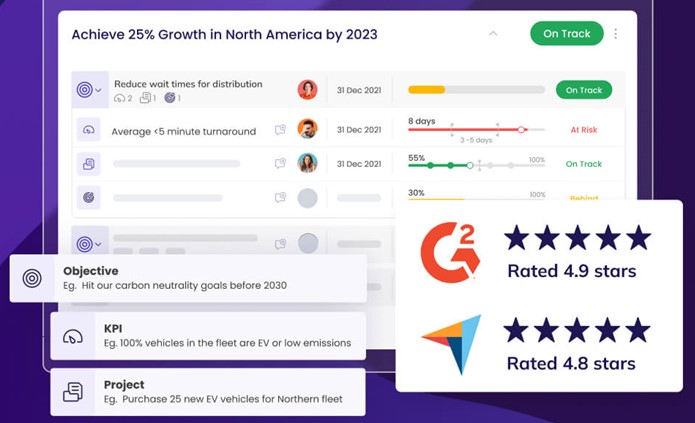
What Is Process Improvement In Strategy?
The set of organizational practices that enable the creation, evaluation, revision, and execution of the organization’s strategic plan is known as process improvement in strategy.
The continuous improvement of certain organizational practices is known as continuous process improvement.
The primary goal of a strategy’s continuous process improvement is the proactive adaptation to environmental changes through workforce alignment with the strategic plan for a lean, focused execution.
In layman’s words, it refers to how the company is enhancing and modifying its strategy to remain relevant in the modern, evolving world.
It’s the contemporary approach to dealing with business issues of today.
The 4 Parts Of The Process Improvement Methodology You Need In Your Strategy
Building habits in four crucial stages of your strategy management process is part of the technique to enhance your organization’s strategic process:
• Planning
• Executing
• Reviewing
• Refining
Your efforts to improve your processes should center on these.
Planning
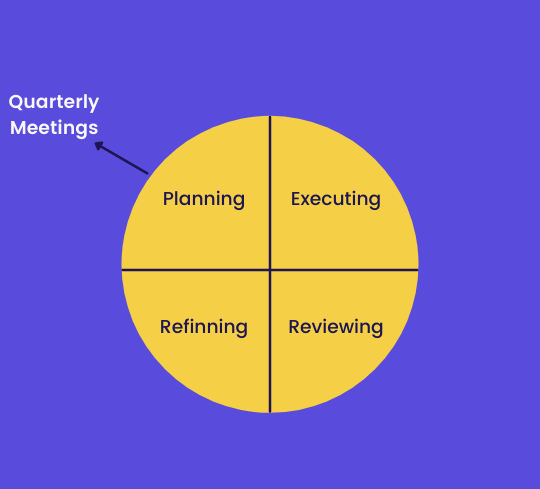
The top leadership of most companies meets once a year to develop the business’s strategy utilizing tools like a strategic planning template. They then organize their strategy and choose where to focus their attention.
Today, though, that rarely works. You cannot expect to lead the market if you revisit your approach only once a year because the world is changing so quickly.
You must therefore learn to be flexible if you want to improve the planning process. so that you can evolve to surf the waves of change, you must be able to recognize them early. You must develop a new routine to check in with your strategy more frequently.
Participate in a quarterly meeting to plan your strategy.
Instead of going over every detail of your plan every quarter, concentrate on what’s important and always question your presumptions. Make sure the trajectory of your company makes sense.
Here is a suggestion for successfully enhancing your planning procedure:
Quit using Excel.
Discussing the effectiveness of your plan so regularly is a taxing task. Static tools simply won’t do. You require a flexible platform that can accommodate all phases of the development of the plan.
However, if you’re not quite ready to leave Excel, utilize this gap analysis form to conduct an objective internal evaluation and determine precisely where you should concentrate your efforts.
Executing
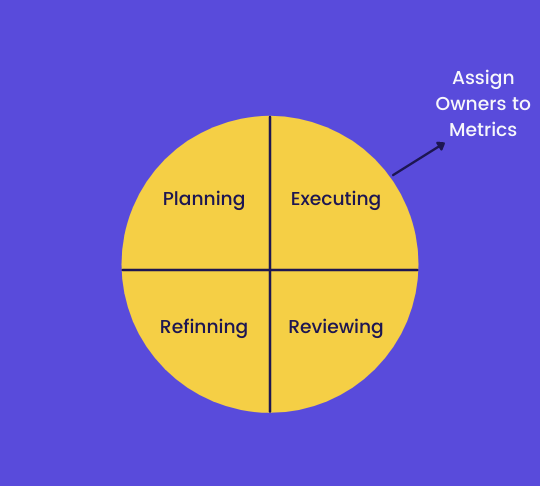
Getting your teams to concentrate on carrying out your strategy plan is one of your company’s most difficult issues. particularly the upgraded edition. Because if your staff doesn’t implement the new initiatives, what good is having a flexible planning process?
Business as usual is your adversary in implementing your strategy. the routine behavior of your workers. Your present people’s behavior is what you’ll need to consistently adjust and eventually improve.
And changing the measurements you employ is the most efficient way to do it.
People won’t alter their behavior simply because you told them to, until you alter the way in which you evaluate their performance.
As a result, match your measurements to your existing objectives. Make careful to measure the important aspects if you ask your team to make a substantial adjustment in their behavior.
Then give each measure a clear owner to empower your team. Make it a point to never abandon a project or metric without an owner. The clarity that results improves the execution of your strategy and encourages accountability.
Reviewing
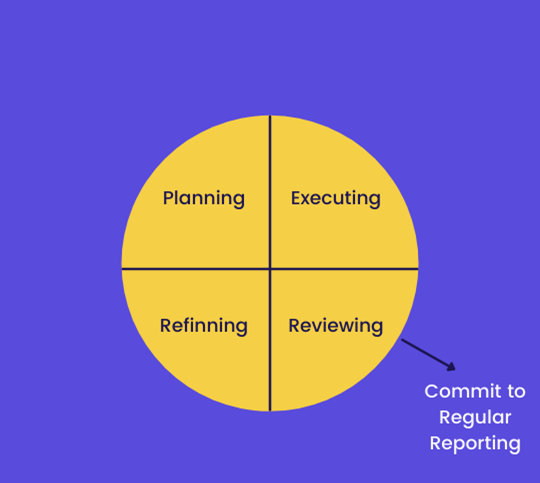
Regular reporting is one of the most difficult organizational practices to establish. It also offers the greatest rewards. A dedication to routinely evaluating the effectiveness of your plan has a significant impact on fostering organizational alignment.
What are your company’s reporting requirements? Decide what they are, and make it a practice to report on the most important things. Maintain focus by creating an agenda in advance and directing the conversations toward the “next steps.”
When you make a commitment to regular reporting on every level of your company, your business’s review process will improve. To keep your team on board with your strategy and everyone focused on the plan, start with something straightforward.
Prior to meetings, decide the KPIs you’ll evaluate, and create clear, brief, and simple-to-read reports. To save time in your preparation for the reviewing process, use this tutorial on how to build a KPI report.
Refining
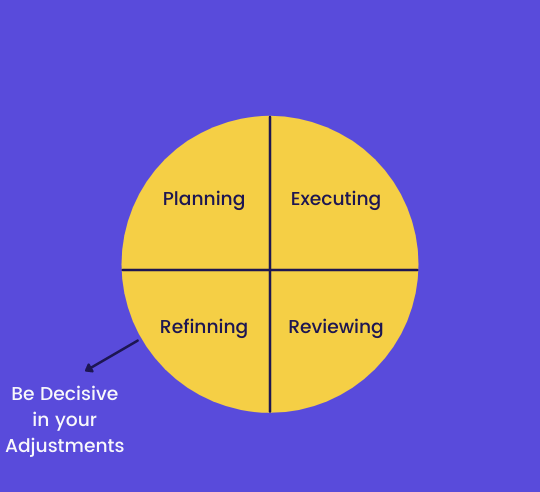
It’s challenging to modify your plan. It resembles making a mistaken admission.
However, that is untrue. Modifying your strategic plan indicates that you have discovered a more effective route to your goal.
Being decisive will significantly speed up the strategy-refining process.
Never question it when a strategy debate results in modifications. Put your decision into action and stay committed. You need to make it a habit to do this. dedication to change.
Nothing, really, truly guarantees a win, including changing your plan. However, by foreseeing upcoming industry shifts, it does improve your chances of keeping market leadership.
The business killer in a world full of disruptors is complacency. Avoid letting your strategy become stale. Change your strategy and course instead with decisiveness.
The Role Of Methodologies And Tools In Continuous Improvement

Case Study
Although Apple is a shining example of creativity, let’s not forget that most of its success is attributable to incremental breakthroughs. The smartphone already existed when the iPhone first hit the market, but Apple made it a success by significantly enhancing the touchscreen’s size, the user experience overall, adding an app store, and then creating their own ecosystem that has since become the center of our everyday life.
Apple has continued to hold its positions by little adjustments and advancements, but they do not significantly affect how we live. However, the internet and its commercialization were inventions that permitted the emergence of numerous new enterprises and sectors, and they fundamentally altered our society. These inventions are much less common than incremental ones, and they are also much harder to accomplish.
That’s not to argue that small-scale ideas are simple to implement. Whether you are creating items or services, there are a ton of things to improve. How to approach continuous improvement in a sustainable manner represents the real challenge.
How do you manage improvements in a methodical way so that they become standard procedure? Three crucial factors should be taken into account:
1. Start with the objective that is most important to your business plan.
Knowing your goals will help you avoid making changes just for the sake of making changes. Making improvements in specific areas that are important to the organization’s strategic goals should be the goal of continuous improvement.
2. Select the procedures and techniques that can help you achieve that aim.
You can follow the instructions and use the processes as a road map to assist you arrive at the desired results. It is simpler to maintain your concentration on the objective if you have these in place.
3. Select the implements that give the procedures and methods life.
The employment of numerous tools and strategies is possible in continuous development. Whether you choose one or several depends on your current situation and, certainly, your future objectives.

Case Study
As an illustration, Toyota, one of the forerunners of corporate continuous improvement, created their own processes and tools to help them dominate their market. But it takes a lot of perseverance over a long period of time to create a new mindset and culture.
Standards, Infrastructure, and Operational Governance Building Blocks
Organizations must set up robust infrastructure, standards of consistency, and governance to enable the continuous improvement strategy. Participants in the program will learn the components needed for their continuous improvement initiative to succeed:
1. Governance: Participants will learn how to set up governance frameworks that specify duties and decision-making procedures for initiatives at continuous improvement. This entails designating leaders, establishing improvement teams, and promoting an accountable culture.
2. Infrastructure: The right equipment, technology, and resources are necessary for a successful continuous improvement effort. In order to assist improvement initiatives, participants will examine various infrastructure components, such as information systems, communication platforms, and training programs.
3. Standards and best practices: By standardizing procedures and putting best practices into place, firms may learn from successful improvement programs and improve their own processes. Participants will investigate how approaches like Lean, Six Sigma, and Agile may be customized to the requirements of their firm.
The Key To Process Improvement For Strategy Is Workplace Culture
The advantageous elements of this system are activated by culture. Any effort to develop these behaviors will be unsuccessful if your working culture is unproductive. Your strategy’s initial area of change should be your workforce and organizational culture.
How Leaders Influence The Culture At Work
Here is a sound maxim (or more appropriately, a business strategy law):
Strategy suffers when it clashes with culture.
Flexible cultures that respect adaptability and view faltering and changing course as necessary parts of the journey have been developed by adaptive firms that continuously enhance their strategy processes.
Leadership should strive for that. Although they may not control it, leaders do set the tone.
Flexibility and speed are made possible by workplace safety and mutual trust. These qualities take time to develop, but once they do, your company’s strategic processes will be greatly enhanced by its personnel’s sense of security and mutual trust.
Leadership must take the initiative to bring about the change and promote a growth culture.
Market leaders and followers differ in their work environments and ability to form habits that will help them consistently enhance their strategic operations.
What is the first step in creating a flexible attitude toward the organization’s plan, then, given that?
How Can You Make Your Communication Process Better?
The majority of businesses tell their employees about their strategy. But very few are skilled at it.
Don’t believe anything I say. Just consider how many businesses fail to implement their strategy.
Finding a successful method of explaining your strategic plan to your workforce is actually a significant component of the continuous process improvement of your strategy.
To implement it, people require more context.
As a communication approach, outlining your plan or sending a document with examples is insufficient.
And let’s say your planning methodology has been improved, and you now update your strategic plan four times a year. The document must then be updated and distributed again internally. With programs like Excel, that takes weeks.
The goal of holding more regular assessment meetings is defeated.
Presentations of strategies are useless at getting your team on board with the plan and altering their front-line behavior.
Let’s be honest. The conventional top-down approach to communicating strategy is ineffective. The less effective it is the further you are from the top.
So how can you make your strategy’s communication process better? There must be a more effective technique than simply presenting your strategy to your team.
What if you could make your plan accessible to them round-the-clock?
What if you had a single source of truth for your approach rather than a bunch of papers and slides?
a digital platform that is user-friendly for every employee in your company and sufficiently competent to handle the complexity of planning.
You introduce your strategy plan and provide your team with all the information they require to make informed decisions. They work on projects that are closely related to what the leadership team stated they wanted to achieve.
The continuous improvement process, from planning to refining, is facilitated at every level when your strategic plan is shared with your team.
The Three Advantages Of The Process Improvement Approach To Strategy
What should you anticipate if you implement the process improvement approach for strategy’s habits?
Unparalleled Flexibility
The ultimate objective in this fast-paced world is to adapt quickly. For huge firms, being lean and agile to stay current with trends is a losing approach. They should instead take a proactive stance toward market changes.
Because of this, increasing operational flexibility is crucial. The process improvement methodology enables firms to become more adaptable.
In a nutshell. If your company adopts these behaviors, you’ll be able to change and modify your plan before your competitors even notice the trends.
You’ll be the one to drive the market, innovate, and bring about change.
Agile Execution
Your team’s attitude toward your approach will change if you make it more visible to them.
They’ll begin to appear in significant ways. They’ll begin testing and enhancing it. They’ll want to participate in it.
That is a significant victory. It implies that your team members will stay on top of the strategy and contribute meaningful and doable improvement ideas.
Since more employees will be concentrating on tasks that advance progress by removing waste, the execution process will eventually become leaner. The entire organization will be in alignment with your strategy.
Extraordinary Transparency
We are aware of many leaders who struggle to foster genuine transparency within their organizations. They run into too many issues.
The majority of them are eliminated or addressed by the continuous improvement process. Your approach being exposed in a fluid setting facilitates overview and eliminates silos.
Regular reporting strengthens accountability and encourages individuals to be more open about their methods, roadblocks, and conclusions.
A culture of safety and trust encourages honesty and encourages employees to share anything that might obstruct the implementation of the strategy.
Key Takeaways
Iteration is a key component of strategy. Stasis, its greatest foe, is lurking close by.
To keep it alive, it requires regular maintenance and revisiting.
These are the main ideas to remember from this article:
• Adopt the four behaviors of planning, executing, reviewing, and refining to enhance your strategic processes.
• Culture is fundamental. If your culture isn’t ready for it, no habit will last.
• Share your strategy with your team to improve communication.
• By using this model, you can create an adaptive, transparent company that executes its strategic strategy in a lean manner.
Executive Summary
Chapter 1: Continuous Improvement
Continuous improvement is essential for organizations seeking to enhance their resilience and adaptability in today’s dynamic business environment. It enables organizations to proactively identify vulnerabilities, address risks, and navigate unforeseen challenges. By fostering a culture of continuous learning, agility, and adaptability, organizations can position themselves for long-term success.
Continuous improvement offers numerous benefits to organizations. It enhances efficiency and productivity by eliminating waste, optimizing processes, and streamlining workflows. Quality improvement is a key aspect, as continuous improvement methodologies like Lean Six Sigma help organizations reduce defects, improve product or service quality, and enhance customer satisfaction. By actively seeking customer feedback and aligning improvement efforts with customer expectations, organizations can deliver exceptional value and gain a competitive edge.
Employee engagement is another crucial benefit of continuous improvement. By involving employees in improvement initiatives, organizations empower them to contribute ideas, take ownership of their work, and enhance collaboration. This engagement leads to increased job satisfaction, motivation, and overall organizational success.
Continuous improvement methodologies, such as Lean Six Sigma, Kaizen, and Agile, provide practical frameworks for driving improvement. Lean Six Sigma combines lean principles and Six Sigma’s data-driven approach to eliminate waste, reduce variability, and optimize processes. Kaizen focuses on small incremental changes, employee involvement, and waste elimination. Agile methodologies, initially developed for software development, promote iterative development, adaptability, and customer collaboration.
Key principles of continuous improvement include customer focus, data-driven decision making, process optimization, employee empowerment, and continuous learning and innovation. Organizations should prioritize customer needs, gather and analyze data for decision making, optimize processes to eliminate bottlenecks, empower employees to contribute to improvement initiatives, and foster a culture of continuous learning and innovation.
Creating a culture of continuous improvement requires leadership support, employee involvement, clear goals and objectives, effective communication, and recognition and rewards. Leaders should actively participate in improvement initiatives, communicate the vision, and provide resources and support. Employee involvement should be encouraged through teams, suggestion systems, and cross-functional collaboration. Clear goals and objectives should be established and communicated, and effective communication channels should be in place. Recognition and rewards should be given to motivate and reinforce improvement behaviors.
To implement continuous improvement initiatives, organizations must identify areas for improvement, establish metrics and targets, plan and execute improvement projects, monitor progress, and sustain and iterate improvements. Areas for improvement can be identified through audits, customer feedback, and benchmarking. Metrics and targets should be set to measure progress, and improvement projects should be planned and executed with proper project management techniques. Progress should be monitored using data analysis tools, and improvements should be sustained by embedding changes into the organization’s culture and continuously iterating.
Challenges in continuous improvement include resistance to change, lack of resources, inadequate training and skills, failure to measure progress, and sustainability issues. These challenges can be addressed through effective change management, resource allocation strategies, training programs, establishing clear metrics, and fostering a culture of continuous learning and adaptation.
In conclusion, continuous improvement is crucial for organizational resilience and adaptability. It offers benefits such as enhanced efficiency, quality improvement, customer satisfaction, employee engagement, and competitive advantage. By implementing continuous improvement methodologies, embracing key principles, creating a culture of continuous improvement, and overcoming challenges, organizations can drive sustainable improvement and achieve long-term success.

Chapter 2: Role of Leaders
The critical role of senior leaders in promoting a climate of continuous improvement and developing problem-solving skills inside businesses is examined in this text. It starts out by describing continuous improvement and outlining its advantages, such as increased effectiveness, cost savings, enhanced quality, and higher levels of customer satisfaction. The document then focuses on senior leaders’ duties in developing a continuous improvement culture.
Senior leaders are those in high-level positions who have a lot of power and influence over decisions. They are necessary for fostering change and creating a climate of constant improvement. They must establish clear objectives and goals, synchronize systems and procedures, create a learning organization, encourage innovation and creativity, and create a change-friendly workplace.
Senior leaders must articulate a compelling vision and set up clear objectives and goals in order to foster a culture of continuous development. Systems and procedures should be aligned, a learning organization should be established that fosters information exchange and employee growth, innovation, and creativity should be fostered, and a nurturing environment should be created where staff members are supported in taking calculated risks and learning from mistakes.
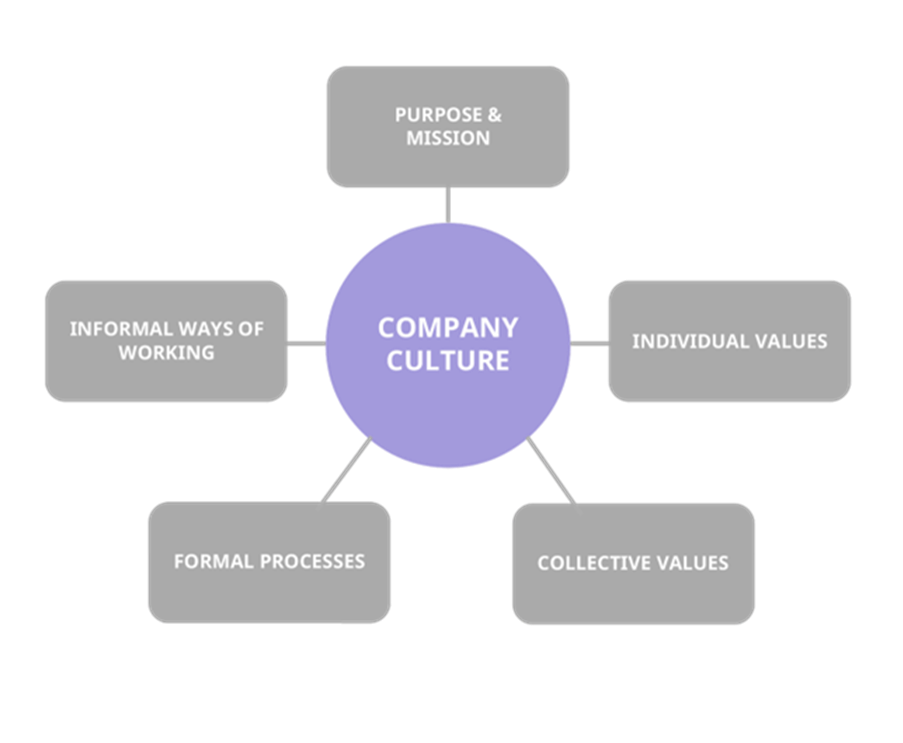
Additionally, senior executives are essential in developing problem-solving skills throughout their firms. They ought to stress the importance of successful issue solving, foster a problem-solving mindset among staff members, offer training and resources, promote cooperation and knowledge sharing, and acknowledge and reward problem-solving efforts.
Another crucial component of the senior leaders’ responsibility is setting an example for others. They must show that they are dedicated to continuous improvement, explain the vision and mission, foster a culture of trust and employee empowerment, promote candor and criticism, and accept change and the lessons that may be learned from mistakes.
A clear strategy and roadmap should be established, performance measurement tools should be put in place, coaching and mentoring should be offered, high-performing teams should be built, and change resistance should be managed, among other strategies, according to the manual. Additionally, it addresses difficulties that senior executives could experience, such as recognizing and removing obstacles to progress, overcoming opposition and change fatigue, maintaining momentum, and adjusting to outside influences and uncertainties. The guidebook emphasizes the significance of using technology to promote ongoing progress.
Senior leaders should identify pertinent key performance indicators (KPIs), gather and analyze data, conduct routine reviews and audits, establish feedback and improvement loops, and celebrate successes while learning from failures in order to drive continuous improvement.
In summary, senior executives are crucial in promoting a climate of continuous improvement and developing an organization’s capacity for problem-solving. Senior leaders enable their businesses to thrive at problem-solving, drive innovation, and achieve sustained success in a dynamic business environment by carrying out their responsibilities, setting an excellent example, and providing the appropriate support and resources.

Chapter 3: Method Principles
Tools and Techniques for Putting Continuous Improvement into Practice
Continuous improvement is a crucial aspect of organizational growth and success. To effectively implement continuous improvement strategies, various tools and techniques can be utilized. While it may be tempting to copy techniques from competitors, developing a unique continuous improvement framework is essential for long-term success. In this article, we will explore several tools and techniques that can be employed to put continuous improvement into practice.
1. Kaizen Corner: The Kaizen corner is based on the Kaizen concept, a Japanese management philosophy that focuses on positive change and continuous improvement. It involves creating a space where employees can submit ideas and proposals for improvements.
2. Kanban: Kanban is a lean concept used to organize and enhance work processes. It utilizes visual boards, cards, or flows to represent the project’s roadmap and the status of each component. Kanban boards are commonly used in product management and development, making it applicable to various organizations.
3. 5 Whys: The 5 Whys is a method for identifying the underlying causes of problems. It involves asking “why” repeatedly to delve deeper into the contributing factors and uncover the root causes of issues. This technique helps prioritize areas for improvement and encourages critical thinking.
4. Fishbone Diagram: The fishbone diagram, also known as the Ishikawa diagram, is a visual tool used in root cause analysis. It helps identify and illustrate various potential causes of a problem. By analyzing the interaction between causes, organizations can gain a better understanding of the contributing factors.
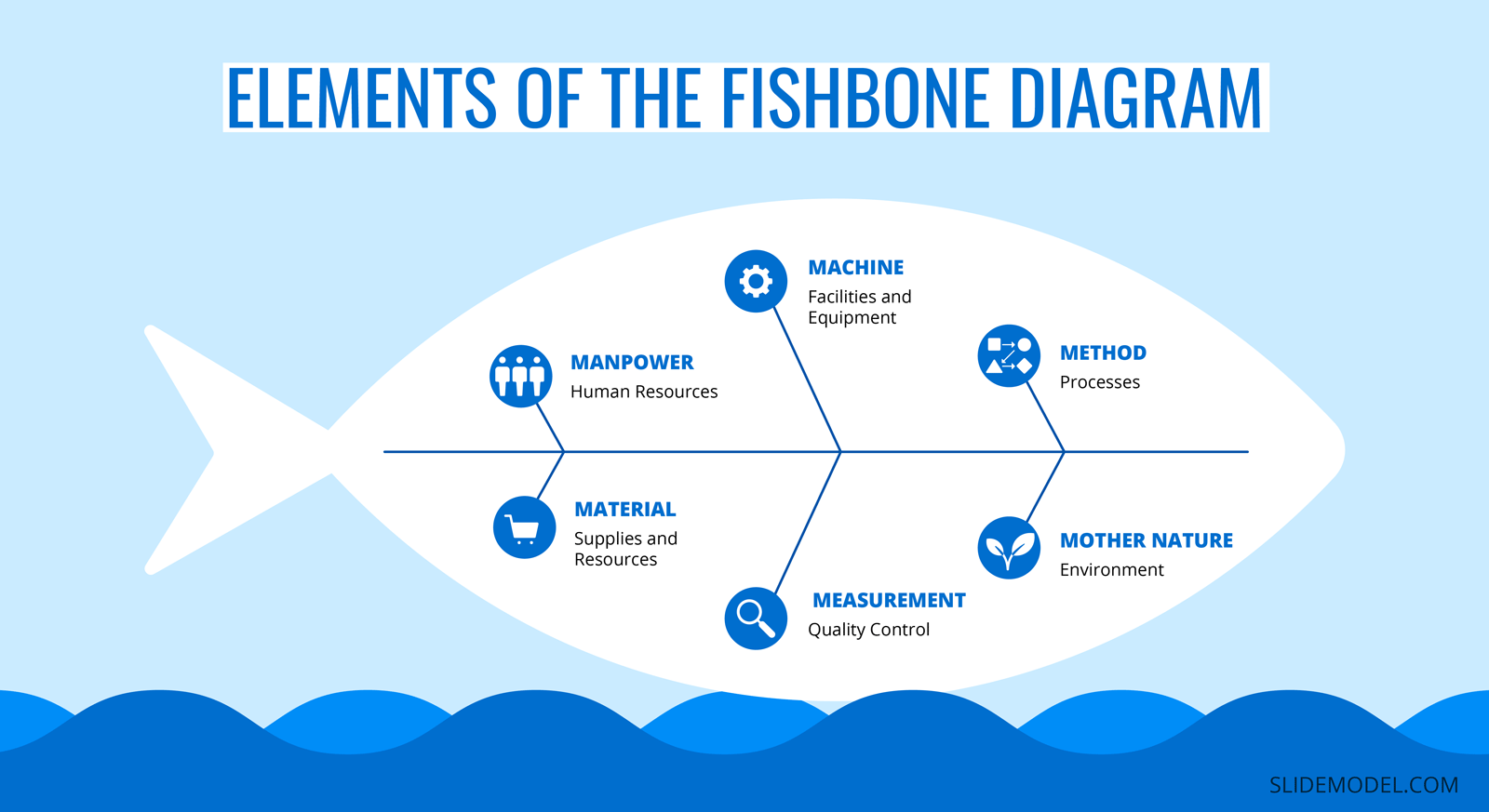
5. Gemba Walks: Gemba walks involve observing and engaging with employees in their workplace. Managers and leaders visit the areas where value is created to gain insights and identify improvement opportunities. Gemba walks are conducted in various settings, such as factory floors, hospitals, or construction sites.
6. Value Stream Mapping: Value stream mapping is a visual technique used to depict and analyze the processes involved in delivering a product or service. It helps identify inefficiencies and potential areas for improvement. This tool is particularly useful for organizations with complex processes and multiple touchpoints.
7. 5S: The 5S methodology focuses on organizing the workplace and eliminating waste and irregularities. The five steps involved are Sort, Set in order, Shine, Standardize, and Sustain. It can be applied to physical workplaces, as well as hybrid physical/virtual environments. Senior management support, employee training, and regular audits are crucial for successful implementation of the 5S practices.
8. Error Checking: Error checking, also known as mistake-proofing or Poka-Yoke, is a method used to prevent errors and ensure that all requirements are met before carrying out a process. It is applicable in processes that rely on human knowledge and expertise. Implementing error checking can prevent costly mistakes and improve overall quality.

Chapter 4: Improving Performance.
Continuous improvement is a management approach that boosts productivity and organizational performance. It involves principles, methodologies, and tools to drive ongoing improvements. It helps organizations identify and eliminate waste, streamline processes, empower employees, foster a learning culture, standardize practices, encourage innovation, enhance quality, make data-driven decisions, promote continuous learning, and prioritize customer satisfaction. Continuous improvement enables organizations to adapt, seize growth opportunities, and succeed in today’s dynamic business environment.
Streamlining processes is a crucial aspect of continuous improvement. Many organizations face complex and convoluted processes that hinder productivity. Continuous improvement encourages organizations to critically evaluate their existing processes and identify areas for improvement. Through process mapping, value stream analysis, and other improvement techniques, organizations can streamline their processes, remove non-value-added activities, and create a more efficient workflow. This results in improved productivity, faster delivery times, and enhanced customer satisfaction.
Empowering employees is a fundamental aspect of continuous improvement. Recognizing employees as valuable assets, continuous improvement encourages their active participation in improvement initiatives. Employees have valuable insights into areas that can be improved since they are closest to the work processes. By involving employees in problem-solving and decision-making, organizations tap into their knowledge, creativity, and expertise. Empowered employees who contribute ideas for improvement feel a sense of ownership and motivation, leading to increased engagement and productivity.
Cultivating a learning culture is another critical element of continuous improvement. It recognizes that organizations must embrace continuous learning and growth to stay ahead. Continuous improvement encourages employees to seek new knowledge, share best practices, and learn from failures and successes. Organizations can create opportunities for training, cross-functional collaboration, and knowledge sharing to foster innovation, problem-solving skills, and performance improvements. A learning culture supports employees in adapting to changes, acquiring new skills, and finding innovative solutions, ultimately boosting productivity and organizational performance.
Standardization plays a vital role in continuous improvement. By developing and implementing standardized practices and procedures, organizations ensure consistency and reliability in operations. Standardization reduces errors, variations, and confusion, thereby enhancing efficiency. When employees have clear guidelines and standardized processes to follow, they can perform their tasks more effectively. Standardization improves productivity by providing a common framework for work, enabling employees to focus on value-added activities and achieve higher levels of performance.
Continuous improvement also encourages organizations to foster a culture of innovation. Innovation is crucial for organizations to thrive in a rapidly changing business landscape. Continuous improvement provides a platform for employees to generate and implement innovative ideas. It creates an environment that supports and rewards experimentation, risk-taking, and creative problem-solving. By empowering employees to contribute to innovation efforts, organizations can improve products, processes, and services, leading to increased productivity, competitive advantage, and customer satisfaction.
Enhancing quality is another significant aspect of continuous improvement. It emphasizes the importance of quality enhancement as a means to drive organizational performance. By implementing robust quality control measures, organizations can identify and rectify defects, reduce rework, and prevent errors. Improved quality not only increases productivity by reducing waste and rework but also enhances customer satisfaction. Organizations that consistently deliver high-quality products and services build a strong reputation, cultivate customer loyalty, and achieve long-term success.
Data-driven decision making is a fundamental principle of continuous improvement. By collecting and analyzing relevant data, organizations gain insights into their current performance and identify areas for improvement. Key performance indicators (KPIs) serve as valuable metrics to measure progress and guide decision making. Data-driven decision making enables organizations to focus on critical improvement opportunities, prioritize resources effectively, and achieve sustainable productivity gains.

Chapter 5: Setting Strategy
Continuous improvement is a powerful approach that drives organizational success by fostering ongoing enhancement and innovation. To fully leverage its potential, organizations must develop a strategic framework that aligns improvement initiatives with their short- and long-term goals. This article emphasizes the importance of setting a strategy for continuous improvement and provides insights into developing a strategic framework to maximize the benefits of such initiatives.
A strategic framework is crucial to guide improvement efforts effectively. Without a clear strategy, organizations may engage in scattered or ad hoc improvement activities that lack direction and fail to deliver significant results. A strategic framework for continuous improvement provides a roadmap, aligning improvement initiatives with organizational priorities, goals, and values. It ensures that improvement efforts are integrated into the organization’s fabric, creating a cohesive and purposeful approach to enhancing performance.
The strategic framework serves several key purposes:
Alignment with Organizational Goals: By setting a strategy for continuous improvement, organizations ensure that improvement initiatives are aligned with their overall objectives. This alignment ensures that improvement efforts directly contribute to organizational success and drive progress in critical areas for achieving strategic outcomes.
Prioritization of Improvement Efforts: A strategic framework helps organizations prioritize improvement initiatives based on their potential impact and alignment with organizational goals. This allows organizations to focus their resources and efforts on the most critical areas that will drive the greatest value and deliver the desired results.
Resource Allocation: Continuous improvement initiatives require resources, including time, budget, and personnel. A strategic framework enables organizations to allocate resources efficiently and effectively by identifying areas of highest priority and allocating resources accordingly. This ensures that improvement initiatives receive the necessary support and investment to succeed.
Clear Communication and Engagement: A strategic framework provides clarity and direction to employees regarding the organization’s continuous improvement efforts. It communicates the importance of improvement initiatives, their link to organizational goals, and the role that employees play in driving improvement. This clear communication fosters employee engagement and encourages active participation in improvement initiatives.
Developing a strategic framework for continuous improvement involves several key steps:
Define Organizational Goals and Priorities: Clearly define the organization’s short- and long-term goals, including key performance indicators (KPIs) and critical areas requiring improvement. Aligning improvement efforts with organizational goals ensures a meaningful impact on performance.
Conduct a Current State Assessment: Assess the organization’s current state by analyzing existing processes, identifying areas for improvement, and understanding the root causes of inefficiencies or bottlenecks. This provides a baseline for measuring progress and focuses improvement efforts.
Establish Improvement Priorities: Prioritize improvement initiatives based on the current state assessment and organizational goals. Evaluate the potential impact, resource requirements, feasibility, and alignment with organizational priorities. Target improvement efforts where they will generate the most significant benefits.
Develop Improvement Strategies: Develop improvement strategies that outline the approaches, methodologies, and tools for driving continuous improvement. Tailor these strategies to the specific needs and context of the organization, such as implementing Lean Six Sigma methodologies or establishing cross-functional improvement teams.
Set Goals and Targets: Set specific goals and targets aligned with the organization’s overall objectives to track progress and measure the success of continuous improvement initiatives. Clear goals and targets enable monitoring, celebrating successes, and identifying areas requiring intensified improvement efforts.
Establish Key Performance Indicators (KPIs): Establish KPIs aligned with improvement priorities that provide meaningful insights into performance. Regularly monitor and review these KPIs to track progress, identify trends, and take timely corrective actions.
Implement Continuous Improvement Initiatives: Implement improvement initiatives, such as process improvement projects, training programs, suggestion systems, or innovation initiatives, in alignment with the strategic framework. Regularly measure and evaluate progress to ensure effectiveness.
Foster a Culture of Continuous Improvement: Include strategies in the strategic framework to foster a culture of continuous improvement. Create an environment

Chapter 6: Aligning Goals
Setting and aligning team goals with organizational objectives is crucial for maximizing team output, motivation, and engagement. When team goals are consistent with the vision and mission of the company, it provides a clear sense of direction for the team and fosters a shared commitment to organizational success. This article provides a playbook for aligning employee goals with corporate objectives and offers guidelines for tracking progress and accomplishments.
Goal alignment ensures that everyone in the organization, regardless of their level, is working together to achieve the same business objectives. It encourages shared values by clarifying the company’s mission, vision, values, and strategic goals to employees. When employees understand the purpose of the company and how their individual efforts contribute to its success, it promotes collaboration, camaraderie, and higher morale.
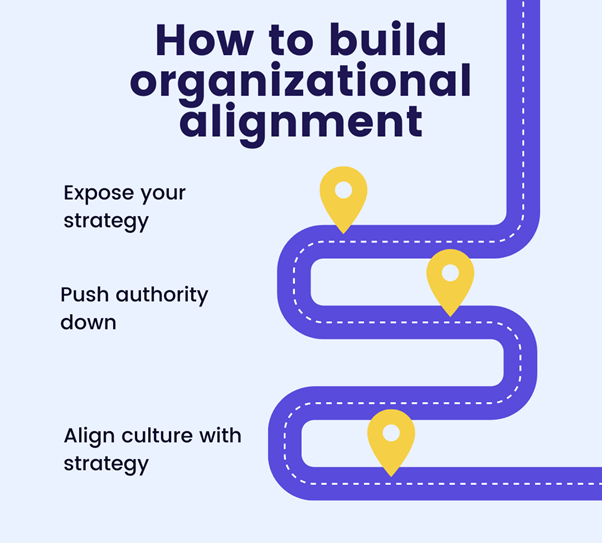
Transparency is another benefit of goal alignment. By providing information on team, department, and organizational performance, employees can see the results of their efforts and those of their colleagues. Increased transparency allows employees to actively participate in projects and goals, leading to stronger collaboration and higher productivity.
To effectively balance individual goals with organizational objectives, several steps can be taken. The first step is to set escalating objectives that cascade throughout the organization. This can be done annually, biannually, or quarterly, with departments, teams, and individuals aligning their goals based on the organization’s direction.
Tracking goals in one centralized location is essential for continuous monitoring and alignment. By having all goals and metrics in one place, employees can easily track their progress and understand how it contributes to the organization’s objectives. This also helps employees remember the company’s goals and the impact of their contributions.
Making metrics accessible to employees is vital. Sharing performance data through regular communication, such as emails or company-wide displays, creates a shared understanding of the organization’s progress and the importance of individual contributions. The more widely and frequently metrics are made available, the better employees can understand their performance and align it with the organization’s goals.
In summary, aligning team goals with organizational objectives is crucial for team success. It promotes shared values, transparency, and context for individual and team goal setting. By following guidelines such as setting escalating objectives, tracking goals in one location, and making metrics accessible, organizations can effectively align individual goals with company objectives, leading to increased performance, motivation, and engagement.

Chapter 7: Building Infrastructure
Infrastructure is a crucial component for organizational success, alongside leadership and employee behavior. The infrastructure refers to the systems, procedures, policies, and programs that support and enable the desired behaviors and performance within an organization. It ensures that the right work is accomplished with acceptable behaviors and that the organization operates cohesively like an orchestra.
While values play a role in defining the infrastructure, they alone are not sufficient. Merely stating values such as integrity and communication is subject to personal interpretation. The infrastructure is constructed through various strategies and programs implemented by the organization, including employee handbooks, manager training, performance assessment systems, and behavioral interviews.
However, it is important to note that HR programs alone may fall short of creating an infrastructure based on values. Managers must align their actions with the values and ensure that the infrastructure sends consistent signals. Regular assessment and adjustment of HR programs are necessary to meet the needs of the organization and create a strong foundation based on values.
The implementation of a strong infrastructure is crucial for business success. Failure is often not caused by lack of planning but by a failure to execute the plan and utilize the infrastructure. A strong infrastructure enables businesses to weather challenges and improve profitability. It is likened to a house built on a sturdy foundation to withstand storms.
To achieve excellence in infrastructure and operations, organizations can consider adopting technology solutions. One example is the use of a metacloud, which integrates multiple cloud platforms and allows for a single security configuration. Adopting AI features can help with data processing, performance monitoring, and problem-solving. Platform engineering, derived from DevOps, focuses on optimizing software delivery through the development of a shared platform for automated infrastructure operations and self-service deployments.
In conclusion, leadership, employee behavior, and infrastructure are all crucial factors for organizational success. Infrastructure refers to the systems, procedures, policies, and programs that support and enable desired behaviors. It is important to align actions with values and regularly assess and adjust HR programs to create a strong foundation based on values. Adopting technology solutions can further enhance infrastructure and operational excellence.

Chapter 8: Standards & Consistency
Enhancing consistency in an organization is crucial for maximizing efficiency and productivity, leading to increased client satisfaction, decreased expenses, and reduced waste. There are several strategies that can be employed to achieve this goal.
One effective strategy is to implement a management system. Management systems, such as the Quality Management Standard ISO 9001, provide a standard way of doing things and help establish more effective working practices. ISO 9001, for example, focuses on exceeding client expectations and standardizing operations to save costs and improve business growth. It is important to align the management system with the organization’s strategic objectives and continuously improve processes through regular assessments by external auditors.
Setting and sharing SMART objectives is another key strategy. SMART goals are Specific, Measurable, Achievable, Relevant, and Time-bound. Clear and accurate goals ensure that everyone in the organization is working towards the same objectives, avoiding conflicts and enhancing efficiency. Breaking down larger goals into smaller, manageable ones helps motivate employees and align their efforts with the company’s objectives.
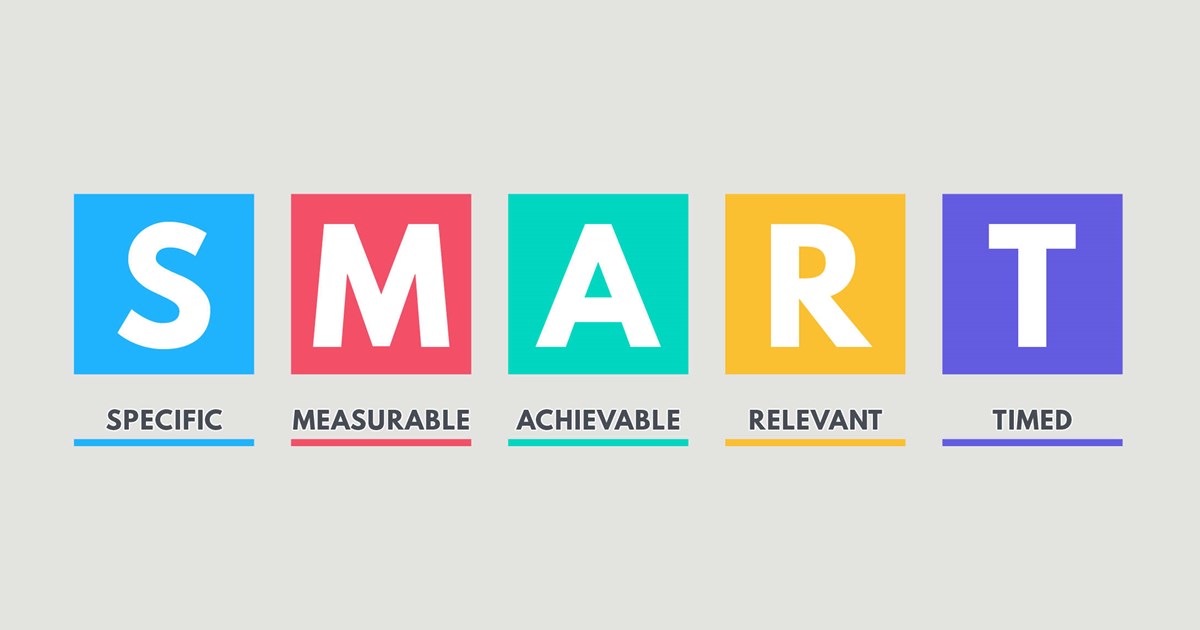
Recognizing the value of employees is essential for maintaining consistency and efficiency. Motivated and satisfied employees contribute to lower staff turnover, increased productivity, and higher customer satisfaction. It is important to have documented policies and procedures to ensure employees know what is expected of them. Creating a system for employees to communicate their opinions, considering their suggestions, and providing feedback fosters employee engagement and a sense of value.
Putting the customer first is another vital strategy. Excellent customer service should be at the core of all organizational activities, regardless of size or industry. Providing intensive and continuous training to employees in customer service skills ensures consistent and high-quality customer experiences. Standardizing processes, from answering phone calls to handling queries and resolving issues, improves customer loyalty and trust.
Maintaining machinery and equipment in good condition is also crucial for consistency and efficiency. Neglecting minor issues can lead to disruptions and inefficiencies in daily operations. Regular maintenance and checkups help identify and fix problems before they escalate, preventing costly downtime. Encouraging all employees to contribute to general maintenance tasks and promptly reporting issues ensures a proactive approach to equipment management.
Standardized work is a technique used in lean manufacturing to create accurate and efficient processes. It involves three components: time, work sequence, and standard inventory. Standardizing work reduces variation, improves productivity, simplifies training, and provides a foundation for continuous improvement. By gathering information about existing operations, identifying variations and problems, optimizing processes, recording standardized procedures, and adjusting training initiatives, organizations can establish and maintain standardized work.
In conclusion, consistency is essential for maximizing efficiency and productivity in an organization. Strategies such as implementing a management system, setting SMART objectives, recognizing the value of employees, putting the customer first, maintaining machinery, and establishing standardized work can help achieve this goal. By continuously improving and refining these strategies, organizations can enhance their consistency and efficiency, leading to overall success.

Chapter 9: Developing Strategy
Creating a strategy for continuous improvement is essential for organizations that want to maintain their competitive advantage and achieve long-term success. While many people recognize the importance of continuous development, they often fail to make it a habit. A continuous improvement strategy involves consciously investing in and focusing on progress to enhance goods, services, or procedures in a business setting.
To create an effective continuous improvement strategy, it should be tailored to address the specific needs and untapped potential of different departments or divisions within the organization. It should also align with the overall business goals and objectives. A well-planned strategy provides direction, emphasizes the importance of improvement, and helps win over stakeholders who can support and contribute to the improvement efforts.
Having a continuous improvement strategy is important for several reasons. First, it helps break down larger objectives into manageable steps, making improvement more attainable and sustainable. Second, it ensures that continuous improvement becomes ingrained in the organization’s culture and daily operations. Third, it facilitates prioritization and deliberate decision-making, allowing the organization to focus on areas that will have the most significant impact.
Creating a continuous improvement culture strategy involves three key components: simplicity, strategic alignment, and operational execution. The strategy should be straightforward and easy to understand, ensuring broad participation across the organization. It should also align with the organization’s vision, goals, and objectives to drive meaningful improvement. Finally, the strategy should outline the specific actions, responsibilities, timelines, resources, and metrics needed to implement and measure the success of continuous improvement initiatives.
Implementing a continuous improvement strategy involves several stages. It begins with assessing the current state to identify improvement opportunities and strengths. Next, the desired outcomes are mapped, setting clear goals for improvement. Then, the improvement journey is charted, specifying the steps and actions required to close the gaps and foster a culture of improvement. Finally, the strategy is implemented, tested, adjusted, and scaled, with the involvement and support of all levels of the organization.
Key success factors for a good continuous improvement strategy include alignment of business objectives, involvement of management in promoting and supporting improvement efforts, effective communication to engage and motivate employees, and continued and persistent efforts to sustain improvement over time. These factors help create a culture of continuous improvement that drives business performance and results in cost savings, waste reduction, and improved operational effectiveness.
In conclusion, developing a strategy for continuous improvement is crucial for organizations that want to stay competitive and achieve long-term success. It involves consciously investing in progress and enhancing goods, services, or procedures. A well-planned strategy provides direction, aligns with business objectives, and emphasizes the importance of improvement. By following a structured approach and focusing on key success factors, organizations can create a continuous improvement culture that drives ongoing progress and long-lasting benefits.

Chapter 10: Operationalizing CI
Operationalization is a method used in the workplace to transform intangible or abstract concepts into quantitative data, making them easier to examine and analyze. It is a valuable tool for decision-making and has several advantages for businesses. This course manual defines operationalization, explores its significance, discusses its benefits, and provides examples of how it can be implemented.
Operationalization involves converting non-quantifiable concepts into observable and recordable data, allowing for better understanding and evaluation of employee behavior, productivity, and motivation. By quantifying data, operationalization enhances the ability to evaluate and analyze information, providing specific variables that contribute to an employee’s motivation at work.
The advantages of operationalization in the workplace are numerous. First, it enables the quantification of abstract concepts, leading to clearer evaluation and measurement of data. By defining metrics and indicators, operationalization helps maintain focus during assessments and improves comprehension of the information provided. It also allows for the identification of trends by transforming abstract concepts into quantifiable statistics, enabling analytical tasks like sorting, charting, and averaging.
Furthermore, operationalization aims to improve employee and organizational performance by identifying areas for improvement and developing new strategies. It enables the testing of the effects of changes made in procedures, facilitating the implementation of effective approaches and the elimination of ineffective ones.
To implement operationalization at work, several steps can be followed. Firstly, a focus must be determined, clearly defining the abstract concept to be researched. Next, variables that indicate the concept’s performance are chosen. These variables are then assigned values using indicators, which are quantifiable measurements. Data is collected, analyzed, and sorted according to the chosen variables. Based on the findings, adjustments can be made, and the process is repeated to track the impact of changes and continuously improve performance.
The manual provides four examples of operationalization in the workplace. In the first example, a sales team measures their level of confidence in their abilities by comparing sales forecasts with actual performance. The second example focuses on employee satisfaction, using retention rates and employee recommendations to gauge morale. The third example deals with workload management, using metrics such as task completion and deadlines to assess the balance of challenges faced by employees. Lastly, customer satisfaction is measured using average purchase amounts, repeat purchases, and product returns.
In conclusion, operationalization is a valuable method for making reasonable decisions in the workplace. By transforming abstract concepts into quantitative data, businesses can better evaluate and analyze various aspects of the workplace and its employees. The advantages of operationalization include quantifying data, maintaining focus, identifying trends, and improving performance. By implementing operationalization procedures and following the necessary steps, businesses can enhance their understanding of key factors and make informed decisions to drive success.

Chapter 11: Ensuring Success
How To Determine Whether Your Strategy Plan Was Successful
To keep your business on track, use milestones.
After putting in the effort to create a strategic plan, make sure it stays on course by monitoring its progress with metrics.
Measuring progress is a defining characteristic of successful firms, according to a BDC research of more than 1,100 small and medium-sized businesses. Compared to other organizations, the fastest growing ones were nearly 50% more likely to utilize three or more performance measurement metrics.
Pick Your Metrics Wisely
The KPIs you’ll monitor should be listed in the action plan you create to support your business strategy. These can be separated into quantitative performance measurements (such as revenue and profit growth, for example) and milestones (the completion of a task or project by a specific date).
Each business selects its own set of benchmarks. The opening of a website, the acquisition of equipment or a car, the hiring of important personnel, or the receipt of a business loan are examples of milestones.
There are numerous possibilities for performance measures, also referred to as key performance indicators or KPIs. Since your organization will be concentrating its efforts on these indicators, it can be challenging to choose the best ones to follow. Here are some suggestions for choosing and implementing these actions.
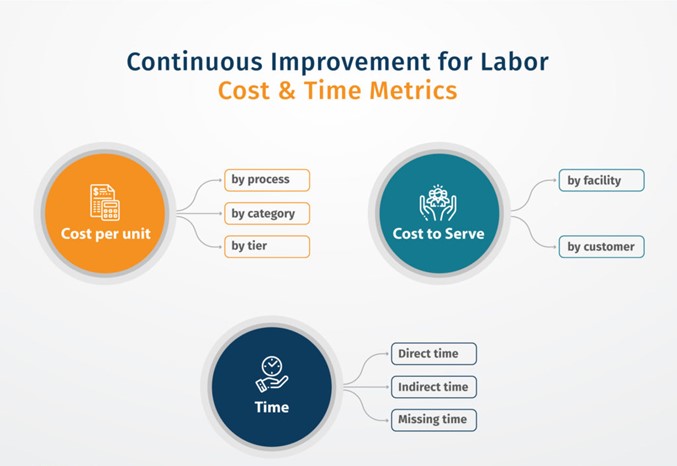
Connect To Strategic Goals
Financial measures including profit, sales, and cash flow are among them. Additionally, you can want to keep tabs on indicators for marketing and/or sales objectives (such as conversion rates or repeat business), operational effectiveness (such as the value creation index), safety (such as the number of hours lost due to accidents), and environmental impact (such as energy use).
Your metrics should be directly related to your strategic goals and should encourage your staff to take the desired actions.
Simple Is Best.
Don’t overburden your personnel with KPIs to monitor. Only four may be chosen per department. It’s crucial to instruct your employees in metrics tracking. Without training, the data might not be monitored or updated properly, endangering the execution of your strategy plan.
Maintain Current Data
Make sure your metrics reflect the most recent information and are communicated quickly within your organization. This is the secret to turning them into a resource for feedback on your work and a mechanism for problem detection.
Employ Dashboards
You should use performance dashboards to monitor your KPIs.
In a newsletter or report on the implementation of your strategic plan, you can also periodically update your team and stakeholders on your progress. Make sure to use understandable images to deliver data in a clear manner.
At follow-up meetings arranged to talk about the execution of your strategic plan, you should also go through your metrics more carefully. You can examine your chosen actions during these meetings to make sure they produce relevant data and encourage the greatest outcomes.
Curriculum
Performance-Minded Leadership – Workshop 1 – Improvement Strategy
- Continuous Improvement
- Role of Leaders
- Method Principles
- Improving Performance.
- Setting Strategy
- Aligning Goals
- Building Infrastructure
- Standards & Consistency
- Developing Strategy
- Operationalizing CI
- Ensuring Success
Distance Learning
Introduction
Welcome to Appleton Greene and thank you for enrolling on the Performance-Minded Leadership corporate training program. You will be learning through our unique facilitation via distance-learning method, which will enable you to practically implement everything that you learn academically. The methods and materials used in your program have been designed and developed to ensure that you derive the maximum benefits and enjoyment possible. We hope that you find the program challenging and fun to do. However, if you have never been a distance-learner before, you may be experiencing some trepidation at the task before you. So we will get you started by giving you some basic information and guidance on how you can make the best use of the modules, how you should manage the materials and what you should be doing as you work through them. This guide is designed to point you in the right direction and help you to become an effective distance-learner. Take a few hours or so to study this guide and your guide to tutorial support for students, while making notes, before you start to study in earnest.
Study environment
You will need to locate a quiet and private place to study, preferably a room where you can easily be isolated from external disturbances or distractions. Make sure the room is well-lit and incorporates a relaxed, pleasant feel. If you can spoil yourself within your study environment, you will have much more of a chance to ensure that you are always in the right frame of mind when you do devote time to study. For example, a nice fire, the ability to play soft soothing background music, soft but effective lighting, perhaps a nice view if possible and a good size desk with a comfortable chair. Make sure that your family know when you are studying and understand your study rules. Your study environment is very important. The ideal situation, if at all possible, is to have a separate study, which can be devoted to you. If this is not possible then you will need to pay a lot more attention to developing and managing your study schedule, because it will affect other people as well as yourself. The better your study environment, the more productive you will be.
Study tools & rules
Try and make sure that your study tools are sufficient and in good working order. You will need to have access to a computer, scanner and printer, with access to the internet. You will need a very comfortable chair, which supports your lower back, and you will need a good filing system. It can be very frustrating if you are spending valuable study time trying to fix study tools that are unreliable, or unsuitable for the task. Make sure that your study tools are up to date. You will also need to consider some study rules. Some of these rules will apply to you and will be intended to help you to be more disciplined about when and how you study. This distance-learning guide will help you and after you have read it you can put some thought into what your study rules should be. You will also need to negotiate some study rules for your family, friends or anyone who lives with you. They too will need to be disciplined in order to ensure that they can support you while you study. It is important to ensure that your family and friends are an integral part of your study team. Having their support and encouragement can prove to be a crucial contribution to your successful completion of the program. Involve them in as much as you can.
Successful distance-learning
Distance-learners are freed from the necessity of attending regular classes or workshops, since they can study in their own way, at their own pace and for their own purposes. But unlike traditional internal training courses, it is the student’s responsibility, with a distance-learning program, to ensure that they manage their own study contribution. This requires strong self-discipline and self-motivation skills and there must be a clear will to succeed. Those students who are used to managing themselves, are good at managing others and who enjoy working in isolation, are more likely to be good distance-learners. It is also important to be aware of the main reasons why you are studying and of the main objectives that you are hoping to achieve as a result. You will need to remind yourself of these objectives at times when you need to motivate yourself. Never lose sight of your long-term goals and your short-term objectives. There is nobody available here to pamper you, or to look after you, or to spoon-feed you with information, so you will need to find ways to encourage and appreciate yourself while you are studying. Make sure that you chart your study progress, so that you can be sure of your achievements and re-evaluate your goals and objectives regularly.
Self-assessment
Appleton Greene training programs are in all cases post-graduate programs. Consequently, you should already have obtained a business-related degree and be an experienced learner. You should therefore already be aware of your study strengths and weaknesses. For example, which time of the day are you at your most productive? Are you a lark or an owl? What study methods do you respond to the most? Are you a consistent learner? How do you discipline yourself? How do you ensure that you enjoy yourself while studying? It is important to understand yourself as a learner and so some self-assessment early on will be necessary if you are to apply yourself correctly. Perform a SWOT analysis on yourself as a student. List your internal strengths and weaknesses as a student and your external opportunities and threats. This will help you later on when you are creating a study plan. You can then incorporate features within your study plan that can ensure that you are playing to your strengths, while compensating for your weaknesses. You can also ensure that you make the most of your opportunities, while avoiding the potential threats to your success.
Accepting responsibility as a student
Training programs invariably require a significant investment, both in terms of what they cost and in the time that you need to contribute to study and the responsibility for successful completion of training programs rests entirely with the student. This is never more apparent than when a student is learning via distance-learning. Accepting responsibility as a student is an important step towards ensuring that you can successfully complete your training program. It is easy to instantly blame other people or factors when things go wrong. But the fact of the matter is that if a failure is your failure, then you have the power to do something about it, it is entirely in your own hands. If it is always someone else’s failure, then you are powerless to do anything about it. All students study in entirely different ways, this is because we are all individuals and what is right for one student, is not necessarily right for another. In order to succeed, you will have to accept personal responsibility for finding a way to plan, implement and manage a personal study plan that works for you. If you do not succeed, you only have yourself to blame.
Planning
By far the most critical contribution to stress, is the feeling of not being in control. In the absence of planning we tend to be reactive and can stumble from pillar to post in the hope that things will turn out fine in the end. Invariably they don’t! In order to be in control, we need to have firm ideas about how and when we want to do things. We also need to consider as many possible eventualities as we can, so that we are prepared for them when they happen. Prescriptive Change, is far easier to manage and control, than Emergent Change. The same is true with distance-learning. It is much easier and much more enjoyable, if you feel that you are in control and that things are going to plan. Even when things do go wrong, you are prepared for them and can act accordingly without any unnecessary stress. It is important therefore that you do take time to plan your studies properly.
Management
Once you have developed a clear study plan, it is of equal importance to ensure that you manage the implementation of it. Most of us usually enjoy planning, but it is usually during implementation when things go wrong. Targets are not met and we do not understand why. Sometimes we do not even know if targets are being met. It is not enough for us to conclude that the study plan just failed. If it is failing, you will need to understand what you can do about it. Similarly if your study plan is succeeding, it is still important to understand why, so that you can improve upon your success. You therefore need to have guidelines for self-assessment so that you can be consistent with performance improvement throughout the program. If you manage things correctly, then your performance should constantly improve throughout the program.
Study objectives & tasks
The first place to start is developing your program objectives. These should feature your reasons for undertaking the training program in order of priority. Keep them succinct and to the point in order to avoid confusion. Do not just write the first things that come into your head because they are likely to be too similar to each other. Make a list of possible departmental headings, such as: Customer Service; E-business; Finance; Globalization; Human Resources; Technology; Legal; Management; Marketing and Production. Then brainstorm for ideas by listing as many things that you want to achieve under each heading and later re-arrange these things in order of priority. Finally, select the top item from each department heading and choose these as your program objectives. Try and restrict yourself to five because it will enable you to focus clearly. It is likely that the other things that you listed will be achieved if each of the top objectives are achieved. If this does not prove to be the case, then simply work through the process again.
Study forecast
As a guide, the Appleton Greene Performance-Minded Leadership corporate training program should take 12-18 months to complete, depending upon your availability and current commitments. The reason why there is such a variance in time estimates is because every student is an individual, with differing productivity levels and different commitments. These differentiations are then exaggerated by the fact that this is a distance-learning program, which incorporates the practical integration of academic theory as an as a part of the training program. Consequently all of the project studies are real, which means that important decisions and compromises need to be made. You will want to get things right and will need to be patient with your expectations in order to ensure that they are. We would always recommend that you are prudent with your own task and time forecasts, but you still need to develop them and have a clear indication of what are realistic expectations in your case. With reference to your time planning: consider the time that you can realistically dedicate towards study with the program every week; calculate how long it should take you to complete the program, using the guidelines featured here; then break the program down into logical modules and allocate a suitable proportion of time to each of them, these will be your milestones; you can create a time plan by using a spreadsheet on your computer, or a personal organizer such as MS Outlook, you could also use a financial forecasting software; break your time forecasts down into manageable chunks of time, the more specific you can be, the more productive and accurate your time management will be; finally, use formulas where possible to do your time calculations for you, because this will help later on when your forecasts need to change in line with actual performance. With reference to your task planning: refer to your list of tasks that need to be undertaken in order to achieve your program objectives; with reference to your time plan, calculate when each task should be implemented; remember that you are not estimating when your objectives will be achieved, but when you will need to focus upon implementing the corresponding tasks; you also need to ensure that each task is implemented in conjunction with the associated training modules which are relevant; then break each single task down into a list of specific to do’s, say approximately ten to do’s for each task and enter these into your study plan; once again you could use MS Outlook to incorporate both your time and task planning and this could constitute your study plan; you could also use a project management software like MS Project. You should now have a clear and realistic forecast detailing when you can expect to be able to do something about undertaking the tasks to achieve your program objectives.
Performance management
It is one thing to develop your study forecast, it is quite another to monitor your progress. Ultimately it is less important whether you achieve your original study forecast and more important that you update it so that it constantly remains realistic in line with your performance. As you begin to work through the program, you will begin to have more of an idea about your own personal performance and productivity levels as a distance-learner. Once you have completed your first study module, you should re-evaluate your study forecast for both time and tasks, so that they reflect your actual performance level achieved. In order to achieve this you must first time yourself while training by using an alarm clock. Set the alarm for hourly intervals and make a note of how far you have come within that time. You can then make a note of your actual performance on your study plan and then compare your performance against your forecast. Then consider the reasons that have contributed towards your performance level, whether they are positive or negative and make a considered adjustment to your future forecasts as a result. Given time, you should start achieving your forecasts regularly.
With reference to time management: time yourself while you are studying and make a note of the actual time taken in your study plan; consider your successes with time-efficiency and the reasons for the success in each case and take this into consideration when reviewing future time planning; consider your failures with time-efficiency and the reasons for the failures in each case and take this into consideration when reviewing future time planning; re-evaluate your study forecast in relation to time planning for the remainder of your training program to ensure that you continue to be realistic about your time expectations. You need to be consistent with your time management, otherwise you will never complete your studies. This will either be because you are not contributing enough time to your studies, or you will become less efficient with the time that you do allocate to your studies. Remember, if you are not in control of your studies, they can just become yet another cause of stress for you.
With reference to your task management: time yourself while you are studying and make a note of the actual tasks that you have undertaken in your study plan; consider your successes with task-efficiency and the reasons for the success in each case; take this into consideration when reviewing future task planning; consider your failures with task-efficiency and the reasons for the failures in each case and take this into consideration when reviewing future task planning; re-evaluate your study forecast in relation to task planning for the remainder of your training program to ensure that you continue to be realistic about your task expectations. You need to be consistent with your task management, otherwise you will never know whether you are achieving your program objectives or not.
Keeping in touch
You will have access to qualified and experienced professors and tutors who are responsible for providing tutorial support for your particular training program. So don’t be shy about letting them know how you are getting on. We keep electronic records of all tutorial support emails so that professors and tutors can review previous correspondence before considering an individual response. It also means that there is a record of all communications between you and your professors and tutors and this helps to avoid any unnecessary duplication, misunderstanding, or misinterpretation. If you have a problem relating to the program, share it with them via email. It is likely that they have come across the same problem before and are usually able to make helpful suggestions and steer you in the right direction. To learn more about when and how to use tutorial support, please refer to the Tutorial Support section of this student information guide. This will help you to ensure that you are making the most of tutorial support that is available to you and will ultimately contribute towards your success and enjoyment with your training program.
Work colleagues and family
You should certainly discuss your program study progress with your colleagues, friends and your family. Appleton Greene training programs are very practical. They require you to seek information from other people, to plan, develop and implement processes with other people and to achieve feedback from other people in relation to viability and productivity. You will therefore have plenty of opportunities to test your ideas and enlist the views of others. People tend to be sympathetic towards distance-learners, so don’t bottle it all up in yourself. Get out there and share it! It is also likely that your family and colleagues are going to benefit from your labors with the program, so they are likely to be much more interested in being involved than you might think. Be bold about delegating work to those who might benefit themselves. This is a great way to achieve understanding and commitment from people who you may later rely upon for process implementation. Share your experiences with your friends and family.
Making it relevant
The key to successful learning is to make it relevant to your own individual circumstances. At all times you should be trying to make bridges between the content of the program and your own situation. Whether you achieve this through quiet reflection or through interactive discussion with your colleagues, client partners or your family, remember that it is the most important and rewarding aspect of translating your studies into real self-improvement. You should be clear about how you want the program to benefit you. This involves setting clear study objectives in relation to the content of the course in terms of understanding, concepts, completing research or reviewing activities and relating the content of the modules to your own situation. Your objectives may understandably change as you work through the program, in which case you should enter the revised objectives on your study plan so that you have a permanent reminder of what you are trying to achieve, when and why.
Distance-learning check-list
Prepare your study environment, your study tools and rules.
Undertake detailed self-assessment in terms of your ability as a learner.
Create a format for your study plan.
Consider your study objectives and tasks.
Create a study forecast.
Assess your study performance.
Re-evaluate your study forecast.
Be consistent when managing your study plan.
Use your Appleton Greene Certified Learning Provider (CLP) for tutorial support.
Make sure you keep in touch with those around you.

Tutorial Support
Programs
Appleton Greene uses standard and bespoke corporate training programs as vessels to transfer business process improvement knowledge into the heart of our clients’ organizations. Each individual program focuses upon the implementation of a specific business process, which enables clients to easily quantify their return on investment. There are hundreds of established Appleton Greene corporate training products now available to clients within customer services, e-business, finance, globalization, human resources, information technology, legal, management, marketing and production. It does not matter whether a client’s employees are located within one office, or an unlimited number of international offices, we can still bring them together to learn and implement specific business processes collectively. Our approach to global localization enables us to provide clients with a truly international service with that all important personal touch. Appleton Greene corporate training programs can be provided virtually or locally and they are all unique in that they individually focus upon a specific business function. They are implemented over a sustainable period of time and professional support is consistently provided by qualified learning providers and specialist consultants.
Support available
You will have a designated Certified Learning Provider (CLP) and an Accredited Consultant and we encourage you to communicate with them as much as possible. In all cases tutorial support is provided online because we can then keep a record of all communications to ensure that tutorial support remains consistent. You would also be forwarding your work to the tutorial support unit for evaluation and assessment. You will receive individual feedback on all of the work that you undertake on a one-to-one basis, together with specific recommendations for anything that may need to be changed in order to achieve a pass with merit or a pass with distinction and you then have as many opportunities as you may need to re-submit project studies until they meet with the required standard. Consequently the only reason that you should really fail (CLP) is if you do not do the work. It makes no difference to us whether a student takes 12 months or 18 months to complete the program, what matters is that in all cases the same quality standard will have been achieved.
Support Process
Please forward all of your future emails to the designated (CLP) Tutorial Support Unit email address that has been provided and please do not duplicate or copy your emails to other AGC email accounts as this will just cause unnecessary administration. Please note that emails are always answered as quickly as possible but you will need to allow a period of up to 20 business days for responses to general tutorial support emails during busy periods, because emails are answered strictly within the order in which they are received. You will also need to allow a period of up to 30 business days for the evaluation and assessment of project studies. This does not include weekends or public holidays. Please therefore kindly allow for this within your time planning. All communications are managed online via email because it enables tutorial service support managers to review other communications which have been received before responding and it ensures that there is a copy of all communications retained on file for future reference. All communications will be stored within your personal (CLP) study file here at Appleton Greene throughout your designated study period. If you need any assistance or clarification at any time, please do not hesitate to contact us by forwarding an email and remember that we are here to help. If you have any questions, please list and number your questions succinctly and you can then be sure of receiving specific answers to each and every query.
Time Management
It takes approximately 1 Year to complete the Performance-Minded Leadership corporate training program, incorporating 12 x 6-hour monthly workshops. Each student will also need to contribute approximately 4 hours per week over 1 Year of their personal time. Students can study from home or work at their own pace and are responsible for managing their own study plan. There are no formal examinations and students are evaluated and assessed based upon their project study submissions, together with the quality of their internal analysis and supporting documents. They can contribute more time towards study when they have the time to do so and can contribute less time when they are busy. All students tend to be in full time employment while studying and the Performance-Minded Leadership program is purposely designed to accommodate this, so there is plenty of flexibility in terms of time management. It makes no difference to us at Appleton Greene, whether individuals take 12-18 months to complete this program. What matters is that in all cases the same standard of quality will have been achieved with the standard and bespoke programs that have been developed.
Distance Learning Guide
The distance learning guide should be your first port of call when starting your training program. It will help you when you are planning how and when to study, how to create the right environment and how to establish the right frame of mind. If you can lay the foundations properly during the planning stage, then it will contribute to your enjoyment and productivity while training later. The guide helps to change your lifestyle in order to accommodate time for study and to cultivate good study habits. It helps you to chart your progress so that you can measure your performance and achieve your goals. It explains the tools that you will need for study and how to make them work. It also explains how to translate academic theory into practical reality. Spend some time now working through your distance learning guide and make sure that you have firm foundations in place so that you can make the most of your distance learning program. There is no requirement for you to attend training workshops or classes at Appleton Greene offices. The entire program is undertaken online, program course manuals and project studies are administered via the Appleton Greene web site and via email, so you are able to study at your own pace and in the comfort of your own home or office as long as you have a computer and access to the internet.
How To Study
The how to study guide provides students with a clear understanding of the Appleton Greene facilitation via distance learning training methods and enables students to obtain a clear overview of the training program content. It enables students to understand the step-by-step training methods used by Appleton Greene and how course manuals are integrated with project studies. It explains the research and development that is required and the need to provide evidence and references to support your statements. It also enables students to understand precisely what will be required of them in order to achieve a pass with merit and a pass with distinction for individual project studies and provides useful guidance on how to be innovative and creative when developing your Unique Program Proposition (UPP).
Tutorial Support
Tutorial support for the Appleton Greene Performance-Minded Leadership corporate training program is provided online either through the Appleton Greene Client Support Portal (CSP), or via email. All tutorial support requests are facilitated by a designated Program Administration Manager (PAM). They are responsible for deciding which professor or tutor is the most appropriate option relating to the support required and then the tutorial support request is forwarded onto them. Once the professor or tutor has completed the tutorial support request and answered any questions that have been asked, this communication is then returned to the student via email by the designated Program Administration Manager (PAM). This enables all tutorial support, between students, professors and tutors, to be facilitated by the designated Program Administration Manager (PAM) efficiently and securely through the email account. You will therefore need to allow a period of up to 20 business days for responses to general support queries and up to 30 business days for the evaluation and assessment of project studies, because all tutorial support requests are answered strictly within the order in which they are received. This does not include weekends or public holidays. Consequently you need to put some thought into the management of your tutorial support procedure in order to ensure that your study plan is feasible and to obtain the maximum possible benefit from tutorial support during your period of study. Please retain copies of your tutorial support emails for future reference. Please ensure that ALL of your tutorial support emails are set out using the format as suggested within your guide to tutorial support. Your tutorial support emails need to be referenced clearly to the specific part of the course manual or project study which you are working on at any given time. You also need to list and number any questions that you would like to ask, up to a maximum of five questions within each tutorial support email. Remember the more specific you can be with your questions the more specific your answers will be too and this will help you to avoid any unnecessary misunderstanding, misinterpretation, or duplication. The guide to tutorial support is intended to help you to understand how and when to use support in order to ensure that you get the most out of your training program. Appleton Greene training programs are designed to enable you to do things for yourself. They provide you with a structure or a framework and we use tutorial support to facilitate students while they practically implement what they learn. In other words, we are enabling students to do things for themselves. The benefits of distance learning via facilitation are considerable and are much more sustainable in the long-term than traditional short-term knowledge sharing programs. Consequently you should learn how and when to use tutorial support so that you can maximize the benefits from your learning experience with Appleton Greene. This guide describes the purpose of each training function and how to use them and how to use tutorial support in relation to each aspect of the training program. It also provides useful tips and guidance with regard to best practice.
Tutorial Support Tips
Students are often unsure about how and when to use tutorial support with Appleton Greene. This Tip List will help you to understand more about how to achieve the most from using tutorial support. Refer to it regularly to ensure that you are continuing to use the service properly. Tutorial support is critical to the success of your training experience, but it is important to understand when and how to use it in order to maximize the benefit that you receive. It is no coincidence that those students who succeed are those that learn how to be positive, proactive and productive when using tutorial support.
Be positive and friendly with your tutorial support emails
Remember that if you forward an email to the tutorial support unit, you are dealing with real people. “Do unto others as you would expect others to do unto you”. If you are positive, complimentary and generally friendly in your emails, you will generate a similar response in return. This will be more enjoyable, productive and rewarding for you in the long-term.
Think about the impression that you want to create
Every time that you communicate, you create an impression, which can be either positive or negative, so put some thought into the impression that you want to create. Remember that copies of all tutorial support emails are stored electronically and tutors will always refer to prior correspondence before responding to any current emails. Over a period of time, a general opinion will be arrived at in relation to your character, attitude and ability. Try to manage your own frustrations, mood swings and temperament professionally, without involving the tutorial support team. Demonstrating frustration or a lack of patience is a weakness and will be interpreted as such. The good thing about communicating in writing, is that you will have the time to consider your content carefully, you can review it and proof-read it before sending your email to Appleton Greene and this should help you to communicate more professionally, consistently and to avoid any unnecessary knee-jerk reactions to individual situations as and when they may arise. Please also remember that the CLP Tutorial Support Unit will not just be responsible for evaluating and assessing the quality of your work, they will also be responsible for providing recommendations to other learning providers and to client contacts within the Appleton Greene global client network, so do be in control of your own emotions and try to create a good impression.
Remember that quality is preferred to quantity
Please remember that when you send an email to the tutorial support team, you are not using Twitter or Text Messaging. Try not to forward an email every time that you have a thought. This will not prove to be productive either for you or for the tutorial support team. Take time to prepare your communications properly, as if you were writing a professional letter to a business colleague and make a list of queries that you are likely to have and then incorporate them within one email, say once every month, so that the tutorial support team can understand more about context, application and your methodology for study. Get yourself into a consistent routine with your tutorial support requests and use the tutorial support template provided with ALL of your emails. The (CLP) Tutorial Support Unit will not spoon-feed you with information. They need to be able to evaluate and assess your tutorial support requests carefully and professionally.
Be specific about your questions in order to receive specific answers
Try not to write essays by thinking as you are writing tutorial support emails. The tutorial support unit can be unclear about what in fact you are asking, or what you are looking to achieve. Be specific about asking questions that you want answers to. Number your questions. You will then receive specific answers to each and every question. This is the main purpose of tutorial support via email.
Keep a record of your tutorial support emails
It is important that you keep a record of all tutorial support emails that are forwarded to you. You can then refer to them when necessary and it avoids any unnecessary duplication, misunderstanding, or misinterpretation.
Individual training workshops or telephone support
Please be advised that Appleton Greene does not provide separate or individual tutorial support meetings, workshops, or provide telephone support for individual students. Appleton Greene is an equal opportunities learning and service provider and we are therefore understandably bound to treat all students equally. We cannot therefore broker special financial or study arrangements with individual students regardless of the circumstances. All tutorial support is provided online and this enables Appleton Greene to keep a record of all communications between students, professors and tutors on file for future reference, in accordance with our quality management procedure and your terms and conditions of enrolment. All tutorial support is provided online via email because it enables us to have time to consider support content carefully, it ensures that you receive a considered and detailed response to your queries. You can number questions that you would like to ask, which relate to things that you do not understand or where clarification may be required. You can then be sure of receiving specific answers to each individual query. You will also then have a record of these communications and of all tutorial support, which has been provided to you. This makes tutorial support administration more productive by avoiding any unnecessary duplication, misunderstanding, or misinterpretation.
Tutorial Support Email Format
You should use this tutorial support format if you need to request clarification or assistance while studying with your training program. Please note that ALL of your tutorial support request emails should use the same format. You should therefore set up a standard email template, which you can then use as and when you need to. Emails that are forwarded to Appleton Greene, which do not use the following format, may be rejected and returned to you by the (CLP) Program Administration Manager. A detailed response will then be forwarded to you via email usually within 20 business days of receipt for general support queries and 30 business days for the evaluation and assessment of project studies. This does not include weekends or public holidays. Your tutorial support request, together with the corresponding TSU reply, will then be saved and stored within your electronic TSU file at Appleton Greene for future reference.
Subject line of your email
Please insert: Appleton Greene (CLP) Tutorial Support Request: (Your Full Name) (Date), within the subject line of your email.
Main body of your email
Please insert:
1. Appleton Greene Certified Learning Provider (CLP) Tutorial Support Request
2. Your Full Name
3. Date of TS request
4. Preferred email address
5. Backup email address
6. Course manual page name or number (reference)
7. Project study page name or number (reference)
Subject of enquiry
Please insert a maximum of 50 words (please be succinct)
Briefly outline the subject matter of your inquiry, or what your questions relate to.
Question 1
Maximum of 50 words (please be succinct)
Maximum of 50 words (please be succinct)
Question 3
Maximum of 50 words (please be succinct)
Question 4
Maximum of 50 words (please be succinct)
Question 5
Maximum of 50 words (please be succinct)
Please note that a maximum of 5 questions is permitted with each individual tutorial support request email.
Procedure
* List the questions that you want to ask first, then re-arrange them in order of priority. Make sure that you reference them, where necessary, to the course manuals or project studies.
* Make sure that you are specific about your questions and number them. Try to plan the content within your emails to make sure that it is relevant.
* Make sure that your tutorial support emails are set out correctly, using the Tutorial Support Email Format provided here.
* Save a copy of your email and incorporate the date sent after the subject title. Keep your tutorial support emails within the same file and in date order for easy reference.
* Allow up to 20 business days for a response to general tutorial support emails and up to 30 business days for the evaluation and assessment of project studies, because detailed individual responses will be made in all cases and tutorial support emails are answered strictly within the order in which they are received.
* Emails can and do get lost. So if you have not received a reply within the appropriate time, forward another copy or a reminder to the tutorial support unit to be sure that it has been received but do not forward reminders unless the appropriate time has elapsed.
* When you receive a reply, save it immediately featuring the date of receipt after the subject heading for easy reference. In most cases the tutorial support unit replies to your questions individually, so you will have a record of the questions that you asked as well as the answers offered. With project studies however, separate emails are usually forwarded by the tutorial support unit, so do keep a record of your own original emails as well.
* Remember to be positive and friendly in your emails. You are dealing with real people who will respond to the same things that you respond to.
* Try not to repeat questions that have already been asked in previous emails. If this happens the tutorial support unit will probably just refer you to the appropriate answers that have already been provided within previous emails.
* If you lose your tutorial support email records you can write to Appleton Greene to receive a copy of your tutorial support file, but a separate administration charge may be levied for this service.

How To Study
Your Certified Learning Provider (CLP) and Accredited Consultant can help you to plan a task list for getting started so that you can be clear about your direction and your priorities in relation to your training program. It is also a good way to introduce yourself to the tutorial support team.
Planning your study environment
Your study conditions are of great importance and will have a direct effect on how much you enjoy your training program. Consider how much space you will have, whether it is comfortable and private and whether you are likely to be disturbed. The study tools and facilities at your disposal are also important to the success of your distance-learning experience. Your tutorial support unit can help with useful tips and guidance, regardless of your starting position. It is important to get this right before you start working on your training program.
Planning your program objectives
It is important that you have a clear list of study objectives, in order of priority, before you start working on your training program. Your tutorial support unit can offer assistance here to ensure that your study objectives have been afforded due consideration and priority.
Planning how and when to study
Distance-learners are freed from the necessity of attending regular classes, since they can study in their own way, at their own pace and for their own purposes. This approach is designed to let you study efficiently away from the traditional classroom environment. It is important however, that you plan how and when to study, so that you are making the most of your natural attributes, strengths and opportunities. Your tutorial support unit can offer assistance and useful tips to ensure that you are playing to your strengths.
Planning your study tasks
You should have a clear understanding of the study tasks that you should be undertaking and the priority associated with each task. These tasks should also be integrated with your program objectives. The distance learning guide and the guide to tutorial support for students should help you here, but if you need any clarification or assistance, please contact your tutorial support unit.
Planning your time
You will need to allocate specific times during your calendar when you intend to study if you are to have a realistic chance of completing your program on time. You are responsible for planning and managing your own study time, so it is important that you are successful with this. Your tutorial support unit can help you with this if your time plan is not working.
Keeping in touch
Consistency is the key here. If you communicate too frequently in short bursts, or too infrequently with no pattern, then your management ability with your studies will be questioned, both by you and by your tutorial support unit. It is obvious when a student is in control and when one is not and this will depend how able you are at sticking with your study plan. Inconsistency invariably leads to in-completion.
Charting your progress
Your tutorial support team can help you to chart your own study progress. Refer to your distance learning guide for further details.
Making it work
To succeed, all that you will need to do is apply yourself to undertaking your training program and interpreting it correctly. Success or failure lies in your hands and your hands alone, so be sure that you have a strategy for making it work. Your Certified Learning Provider (CLP) and Accredited Consultant can guide you through the process of program planning, development and implementation.
Reading methods
Interpretation is often unique to the individual but it can be improved and even quantified by implementing consistent interpretation methods. Interpretation can be affected by outside interference such as family members, TV, or the Internet, or simply by other thoughts which are demanding priority in our minds. One thing that can improve our productivity is using recognized reading methods. This helps us to focus and to be more structured when reading information for reasons of importance, rather than relaxation.
Speed reading
When reading through course manuals for the first time, subconsciously set your reading speed to be just fast enough that you cannot dwell on individual words or tables. With practice, you should be able to read an A4 sheet of paper in one minute. You will not achieve much in the way of a detailed understanding, but your brain will retain a useful overview. This overview will be important later on and will enable you to keep individual issues in perspective with a more generic picture because speed reading appeals to the memory part of the brain. Do not worry about what you do or do not remember at this stage.
Content reading
Once you have speed read everything, you can then start work in earnest. You now need to read a particular section of your course manual thoroughly, by making detailed notes while you read. This process is called Content Reading and it will help to consolidate your understanding and interpretation of the information that has been provided.
Making structured notes on the course manuals
When you are content reading, you should be making detailed notes, which are both structured and informative. Make these notes in a MS Word document on your computer, because you can then amend and update these as and when you deem it to be necessary. List your notes under three headings: 1. Interpretation – 2. Questions – 3. Tasks. The purpose of the 1st section is to clarify your interpretation by writing it down. The purpose of the 2nd section is to list any questions that the issue raises for you. The purpose of the 3rd section is to list any tasks that you should undertake as a result. Anyone who has graduated with a business-related degree should already be familiar with this process.
Organizing structured notes separately
You should then transfer your notes to a separate study notebook, preferably one that enables easy referencing, such as a MS Word Document, a MS Excel Spreadsheet, a MS Access Database, or a personal organizer on your cell phone. Transferring your notes allows you to have the opportunity of cross-checking and verifying them, which assists considerably with understanding and interpretation. You will also find that the better you are at doing this, the more chance you will have of ensuring that you achieve your study objectives.
Question your understanding
Do challenge your understanding. Explain things to yourself in your own words by writing things down.
Clarifying your understanding
If you are at all unsure, forward an email to your tutorial support unit and they will help to clarify your understanding.
Question your interpretation
Do challenge your interpretation. Qualify your interpretation by writing it down.
Clarifying your interpretation
If you are at all unsure, forward an email to your tutorial support unit and they will help to clarify your interpretation.
Qualification Requirements
The student will need to successfully complete the project study and all of the exercises relating to the Performance-Minded Leadership corporate training program, achieving a pass with merit or distinction in each case, in order to qualify as an Accredited Performance-Minded Leadership Specialist (APTS). All monthly workshops need to be tried and tested within your company. These project studies can be completed in your own time and at your own pace and in the comfort of your own home or office. There are no formal examinations, assessment is based upon the successful completion of the project studies. They are called project studies because, unlike case studies, these projects are not theoretical, they incorporate real program processes that need to be properly researched and developed. The project studies assist us in measuring your understanding and interpretation of the training program and enable us to assess qualification merits. All of the project studies are based entirely upon the content within the training program and they enable you to integrate what you have learnt into your corporate training practice.
Performance-Minded Leadership – Grading Contribution
Project Study – Grading Contribution
Customer Service – 10%
E-business – 05%
Finance – 10%
Globalization – 10%
Human Resources – 10%
Information Technology – 10%
Legal – 05%
Management – 10%
Marketing – 10%
Production – 10%
Education – 05%
Logistics – 05%
TOTAL GRADING – 100%
Qualification grades
A mark of 90% = Pass with Distinction.
A mark of 75% = Pass with Merit.
A mark of less than 75% = Fail.
If you fail to achieve a mark of 75% with a project study, you will receive detailed feedback from the Certified Learning Provider (CLP) and/or Accredited Consultant, together with a list of tasks which you will need to complete, in order to ensure that your project study meets with the minimum quality standard that is required by Appleton Greene. You can then re-submit your project study for further evaluation and assessment. Indeed you can re-submit as many drafts of your project studies as you need to, until such a time as they eventually meet with the required standard by Appleton Greene, so you need not worry about this, it is all part of the learning process.
When marking project studies, Appleton Greene is looking for sufficient evidence of the following:
Pass with merit
A satisfactory level of program understanding
A satisfactory level of program interpretation
A satisfactory level of project study content presentation
A satisfactory level of Unique Program Proposition (UPP) quality
A satisfactory level of the practical integration of academic theory
Pass with distinction
An exceptional level of program understanding
An exceptional level of program interpretation
An exceptional level of project study content presentation
An exceptional level of Unique Program Proposition (UPP) quality
An exceptional level of the practical integration of academic theory
Preliminary Analysis
Online Article
By Unzueta, Esnaola & Eguren,
Quality Innovation Prosperity,
July, 2020.
“Framework to Evaluate Continuous Improvement Process Efficacy: A Case Study of a Capital Goods Company
INTRODUCTION
The results of implementing continuous improvement (CI) have been well documented in the literature (Bhuiyan and Baghel, 2005; Marin-Garcia, Pardo del Val and Martín, 2008; Singh and Singh, 2015). However, in many cases, once CI techniques have been applied, the initial results are not maintained and become much less effective as time passes (Dale, 2015). For this reason, many authors insist that CI systems must be adapted to individual organisations (Singh and Singh, 2015). Organisation must define a CI deployment strategy to select the appropriate CI method and tools, and they must monitor and follow up in a structured manner with the CI system to develop a CI culture and CI routines and behaviours within the organisation (Bateman and Rich, 2003; Wu and Chen, 2006).
According to Jorgensen, Boer and Laugen (2006), an increased CI maturity level – in terms of the level of adoption of CI routines and behaviours – corresponds to an increased level of performance in the organisation. Several models have been developed to implement CI systems and explain CI sustainability (Upton, 1996; Bessant, Caffyn and Gallagher, 2001; Ljungstrom, 2005; Wu and Chen, 2006; Kumar, Antony and Tiwari, 2011; Egiguren, 2012; McLean, Antony and Dahlgaard, 2017). Taking as a reference previous models, the research team developed a continuous improvement model (CIM) to deploy improvement routines and develop a CI organisational culture, with the objective of increasing CI maturity. Furthermore, a continuous improvement process (CIP) was developed according to this model to define the steps and activities to follow to achieve this CI culture. To evaluate the evolution of CI organisational culture, the present study developed a continuous improvement process assessment system (CIPAS). The current paper presents the aforementioned work and how over a period of two years it was applied in an industrial small and medium sized enterprise (SME) company, here implementing the CIM to overcome the 2nd level and to establish the bases of the 3rd level of CI maturity.
The current paper is organised as follows. In section 2, the research methodology is presented. In section 3, the CIM and CIP are presented, and in section 4, the CIPAS is shown. In section 5, results are drawn from the application of the CIPAS, and finally, section 6 provides the conclusions.”
If you would like to know more, Click Here

Online Article
By Hoffman & Mehra,
International Journal of Quality & Reliability Management,
February, 1999
“Operationalizing productivity improvement programs through total quality management
Abstract
The intent of this empirical research is to identify the critical factors that are potentially “fatal” to productivity improvement programs and to analyze these factors relative to documented quality concepts. From this analysis we determine that these “fatal” factors can be prevented by the pre‐existence of a quality program, specifically total quality management, which requires participative involvement of all members of an organization, continuous improvement, and customer satisfaction.
Introduction
Over the past two decades, the subject of productivity has been discussed, analyzed, criticized, and attacked owing to the slowed growth of productivity in the American manufacturing sector. Frequently people have been the target and the workforce has been categorized as lacking in interest, skills, and motivation. Resource usage has also been a focus of discussion as well as the slower implementation of technology in both the product and the process. Management has not been spared. Management has been referred to as unconcerned, uninvolved, uneducated and lacking in responsibility toward considering operations and productivity as a key element of corporate strategy (Deming, 1981; Juran, 1988; Roach, 1996; Skinner, 1986).
There is a bright side to the entire issue. The fact that productivity and its slowed growth have been recognized and acknowledged shows concern. Organizations have discussed, analyzed, planned, and attempted the productivity revivals through the implementation of productivity improvement programs (PIP). But are the programs working? Are they as successful as intended? Questions have been provoked about PIP successes including the dilemma of why PIPs work better for some organizations and why some organizations are more productive than others (Hayes and Clark, 1986; Roach, 1996).
Current focus on productivity and quality
We consider productivity enhancement as a process to achieve higher levels of output while consuming same or lesser amounts of input resources. Also, we believe that if the same output level is reached in a shorter time period, it indicates improved productivity. It is in this respect, that projects designed to improve productivity must also consider time as a key resource. Productivity improvement programs that result in higher output levels while ignoring increased time consumption cannot be considered successful PIPs. Today’s global competition requires increased throughput levels over lesser time horizons.
Issues related to analyzing and solving productivity problems are complex and often confusing. Considering that so much has been written about productivity by so many (from varied disciplines), it is easy to speculate about the severity of the problem. It appears that productivity improvement programs have frequently produced disappointing results. Perhaps what is needed is a systematic and logical attempt at identifying productivity problems that accompany PIPs.”
If you would like to know more, Click Here

Online Article
By Steele & Murray,
Engineering, Construction and Architectural Management,
October 2004.
“ Creating, supporting and sustaining a culture of innovation
Abstract
Recently the industry’s clients, designers and society as a whole, have begun to accept that innovation can offer key benefits in the form of financial growth and increased profits. Therefore, it is apparent that the development of a culture of innovation is of utmost importance if a business is to become universally proactive, entrepreneurial and remain successful. This owes much to the fact that the agility and ability of an organisation to respond to the changing marketplace is driven by its propensity to innovate. This paper does not attempt to resolve these problems; it merely attempts to raise awareness of the key issues relating to innovation, diffusion and the associated management of change. Moreover, it promotes the benefits afforded by developing an organizational culture of innovation. The content will be of interest to industrialists and researchers and will describe the key issues associated with product derivation, introduction and wider diffusion. Ultimately, it aims to demonstrate that creativity, the promotion of a culture for innovation, and the development of intellectual capital are issues of utmost importance in generating and maintaining a proactive and entrepreneurial organisation.
Introduction
Historically, the study of innovation and change in the construction industry has received scant attention from historians, economists, and construction management researchers alike (Gann, 2000). This is despite the fact that few areas of economic debate are characterised by agreement as the role of innovation for economic development of business and society as a whole (Schumpeter, 1934; Nystrom, 1979; Penrose, 1995). However, within the construction industry the construction research and innovation strategy panel (CRISP) has recognised this lack of focus and responded by commissioning work to investigate, and develop, diffusion mechanisms for construction research and innovation (Sexton et al., 1999).
The UK government has traditionally promoted innovation through research councils (e.g. EPSRC, ESRC), and through a research programme funded through the Construction Directorate of the DETR. There has been a recent attempt to increase the profile of innovation and research through the introduction of a number of initiatives. These include (Crisp Consultancy Commission report, 1999): motivational campaigns (the construction best practice programme), directed research programmes (BRE and the passive solar programme), research schemes with higher education institutions (research council programmes and partners in innovation‐PII), and subsidised consultancy (the energy design advice scheme). In addition to these, the industry has been attempting to adhere to the recommendations of Egan’s (1998). Although this document has motivated the industry to some degree, it makes little reference to how innovation should be promoted and more importantly, diffused within the industry.
This paper attempts to highlight a number of issues regarding innovation and make basic recommendations on how to diffuse new concepts and products within the industry, before outlining the importance of managing the change that their introduction can introduce.”
If you would like to know more, Click Here

Online Article
By Bessant, Caffyn & Gallagher,
Technovation,
February, 2001.
“An evolutionary model of continuous improvement behaviour
Abstract
In today’s complex and turbulent environments the need for continuous improvements in products and processes is widely recognised. But the mechanisms whereby such a continual stream of innovation can be achieved are often less clearly identified. One option is to mobilise a high proportion of the workforce in a process of sustained incremental problem-solving, but experience with this approach suggests that successfully doing so is far from simple. Although many programmes for ‘kaizen’ or ‘continuous improvement’ based on employee involvement are started, the failure rate is high. This paper reports on extensive case-study based research exploring how high involvement in continuous improvement can be built and sustained as an organisational capability. It argues that this phenomenon needs to be viewed as a cluster of behavioural changes which establish innovation routines in the enterprise, and presents a reference model for assessment of progress in the evolution of such capability.
1. Resource based strategy
Much current thinking on strategy concerns what is often termed the ‘resource-based’ model, in which competitive advantage is seen as coming from the particular bundle of tangible and intangible assets to which a firm has access (Kay, 1993, Teece and Pisano, 1994). Accumulating these assets is seen as a key task in strategic management, and the ‘core competence’ of the enterprise is essentially the outcome of this process (Pavitt, 1990, Prahalad and Hamel, 1994). The more firm-specific and difficult to copy these resources are, the more likely it is that sustainable competitive advantage can be built and maintained.
Resources come in various shapes and sizes but can be grouped into tangible assets — buildings, plant, equipment, etc. — and intangible assets. This latter group is made up of knowledge assets — what an enterprise knows about (its core technologies, its market knowledge, etc.) — and behavioural patterns — how it organises and operates. The important feature here is that, unlike tangible assets, they are difficult to acquire and copy because they are often the product of extended learning processes. This makes them highly firm specific and a much stronger source of potential competitive (Teece, 1998). As a UK manager put it, “…there is no other source of competitive advantage! Others can copy our investment, technology and scale — but NOT the quality of our people…”1
In other words, what makes a firm competitive is not so much the equipment, location, buildings, etc. which it possesses (since anyone with deep enough pockets can duplicate this resource position) but what it knows about and how it behaves. A firm like 3M owes its competitive position to deep knowledge (around the fields of coatings and related technologies) which it has built up over nearly a century and to ways of working which are particular to the organisation (such as the encouragement of ‘bootlegging’) which give it the ability to introduce new products on a sustained basis. Both these sets of attributes — the knowledge base and the behaviour patterns — the ‘culture’ or ‘way we do things around here’ — are specific to the company and cannot easily be duplicated.”
If you would like to know more, Click Here
Course Manuals 1-11
Course Manual 1: Continuous Improvement
The Need for Continuous Improvement:
Organizational Resilience: An organization’s capacity to adjust to and bounce back from setbacks, internal or external, is referred to as organizational resilience. Continuous improvement helps organizations remain resilient, helps businesses find weaknesses, proactively manage risks, and improve their ability to deal with unforeseen obstacles. It is crucial to create a culture that fosters resilience through ongoing learning, agility, and flexibility.
Adaptability: To be competitive, firms must be able to change with the dynamic and quickly evolving business environment of today. Continuous improvement promotes flexibility by inspiring businesses to look for novel ideas, accept change, and act fast when the market changes. In order to adjust to shifting consumer needs, technology breakthroughs, and market disruptions, discuss real-world instances of firms that have effectively used continuous improvement efforts.
Benefits of Continuous Improvement:
Improved Productivity and Efficiency: Continuous improvement approaches like Lean and Six Sigma assist firms in finding and eliminating waste, streamlining workflows, and optimizing processes. These efforts result in more productivity, lower costs, shorter lead times, and increased efficiency.
Continuous improvement approaches place a strong emphasis on the pursuit of quality excellence. Lean Six Sigma can be utilized for data-driven strategies to locate and fix the causes of errors, lower variability, and enhance the overall quality of their goods or services.
Customer satisfaction: Businesses actively seek out consumer input, examine customer wants and preferences, and use this data to motivate improvement efforts. In order to provide great value, increase customer loyalty, and gain a competitive edge, it is crucial to link continuous improvement initiatives with consumer expectations.
Employee Engagement: Programs for continuous improvement support employee empowerment – businesses encourage employee participation in improvement initiatives, the sharing of ideas, and taking responsibility for their work. Advantages of employee involvement include enhanced teamwork and increased job satisfaction, motivation, and engagement.
Continual improvement can give businesses a competitive edge – Businesses that value continuous improvement become more creative, stand out from the competition, and react quickly to shifting client demands.
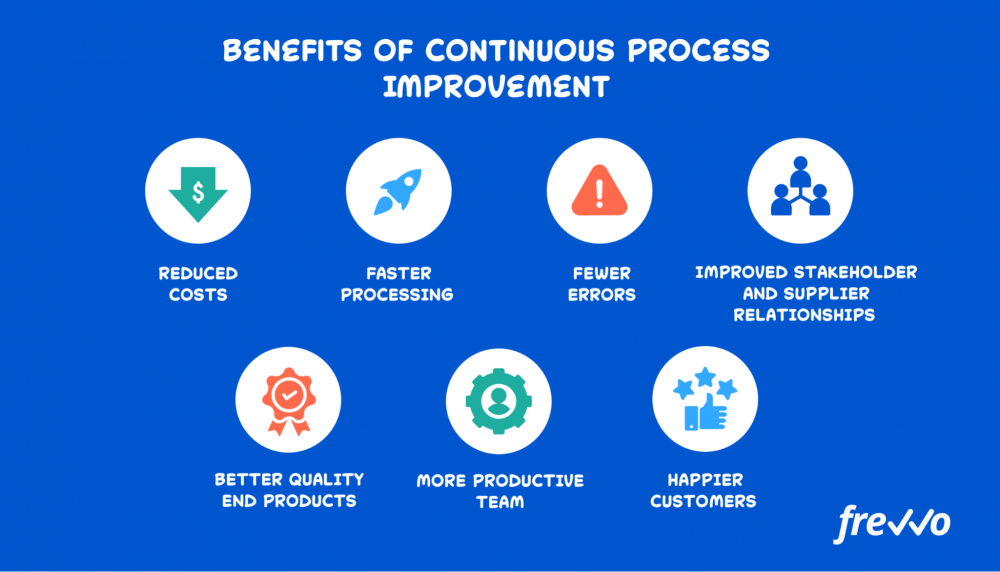

Case Study
Amazon has a strong focus on continuous improvement and innovation, which has contributed to its success as a global e-commerce and technology company.
Amazon’s approach to continuous improvement and employee engagement can be seen through the following practices:
1. Customer Obsession: Amazon’s core principle of being customer-centric drives its continuous improvement efforts. Employees are encouraged to think from the customer’s perspective and constantly find ways to improve the customer experience. This customer-focused mindset engages employees as they strive to deliver exceptional service and exceed customer expectations.
2. Employee Empowerment: Amazon empowers its employees to take ownership and make decisions. The company follows a decentralized decision-making model, allowing employees at all levels to contribute ideas and implement improvements. This empowerment fosters a sense of ownership and engagement among employees, as they feel valued and responsible for driving positive change.
3. Innovation Culture: Amazon nurtures an innovation culture that encourages employees to think creatively and challenge the status quo. The company values experimentation and supports initiatives that drive innovation and improvement. Employees are given the freedom to explore new ideas, which not only boosts engagement but also fuels the company’s continuous growth.
4. Data-Driven Approach: Amazon relies on data to drive continuous improvement. The company collects and analyzes vast amounts of data to gain insights into customer preferences, operational efficiency, and other key metrics. This data-driven approach provides employees with tangible information to identify areas for improvement and make data-backed decisions, enhancing engagement through a results-oriented mindset.
5. Learning and Development: Amazon invests in the learning and development of its employees. The company offers various training programs and resources to help employees enhance their skills and knowledge. Continuous learning opportunities not only contribute to individual growth but also empower employees to contribute to the company’s improvement initiatives effectively.
By combining these practices, Amazon has been able to foster a culture of continuous improvement and engagement, enabling the company to innovate, adapt, and thrive in a highly competitive market.
Key Principles of Continuous Improvement:
Customer Focus: Give readers a better understanding of this crucial continuous improvement strategy. Describe the value of understanding the requirements, expectations, and feedback of your customers. Discuss methods for gathering information for improvement, including as customer surveys, feedback systems, and customer path mapping. In order to increase happiness and loyalty, firms must make sure that their improvement initiatives are in line with client needs.
Consider the use of data in continuous improvement while making decisions. In order to find improvement possibilities, gauge progress, and make wise decisions, it is essential to emphasize the value of data collection, analysis, and interpretation. Talk about several data analysis methods, including control charts, process capability analysis, and Pareto charts. Stress the need of utilizing data to guide improvement initiatives, track success, and guarantee an evidence-based decision-making process.
Process optimization: Give a more thorough description of this important continuous improvement principle. Describe how value stream mapping works to distinguish between steps in processes that provide value and those that don’t. Talk about process redesign and other tools for process analysis, such as spaghetti diagrams and fishbone diagrams. Describe how businesses can use optimization to remove bottlenecks, restructure workflows, and increase process effectiveness.
Expand on the idea of employee empowerment in terms of continual development. Discuss methods for promoting an empowered culture, such as offering training and tools, supporting creativity, and establishing a secure environment for taking risks. Describe the significance of incorporating staff members in problem-solving and decision-making processes because they have significant knowledge and experience to contribute. Highlight the advantages of employee empowerment, such as improved motivation, a sense of ownership, and pride in having a part in the success of the company.
Explain the concept of ongoing innovation and learning in the context of continuous improvement. In order to encourage employees to seek knowledge, discuss ideas, and try out new strategies, it is important to foster a learning culture. Describe the advantages of encouraging creativity through meetings, test projects, and experimentation. Stress the necessity for businesses to adopt a growth mentality and adjust to shifting conditions through ongoing learning and innovation.
The Relationship Between A Company Strategy Of Constant Progress And Supreme Maturity
Instead of thriving during times of economic volatility, most organizations find it very simple — and expected — to prosper in a rising market. The problem is that ‘good times’ can lead to complacency and leave organizations exposed to a swift change in fortunes, as the past 18+ months have so amply shown. The enviable benefit of being able to adapt to change belongs to a mature organization, one that has achieved sustainable and world-class performance under every circumstance. It can quickly, nimbly, and relevantly react to market changes, introducing new and/or updated goods and services to ensure no revenue is lost. By directing its CI transformation throughout all business domains, such as product innovation, practices and processes, services and people, continuous improvement projects assist a less mature organization in achieving such world-class maturity.
Understanding the organization’s current maturity level is the first step in developing any CI plan. Performance improvement maturity refers to an organization’s people, processes, and technologies at each of its five levels. The organization can create a strong and focused continuous process improvement strategy based on that starting point and move the organization to stage 5 once it has analyzed and identified its state of maturity.
The five stages of organizational development are divided into the following categories:
1. Siloisation – no improvement strategy in place yet
Siloed thought and action are characteristics of an organization at stage 1.
Functions and workflows that concentrate on supply, demand, and product have little to no synchronization.
2. Internal coordination that is performance-oriented
An organization is currently working to increase performance by integrating previously incompatible business, operational, and supply chain strategies.
3. Functional alignment: Standardization of work
By successfully aligning their supply chain operations, fostering collaboration in product creation, and making investments in pertinent digital technology, stage 3 organizations have standardised output.
4. Value chain integration and alignment
When a company has implemented best practices across its network of activities and launched complicated performance improvement initiatives (PIPs) with its priority partners and important stakeholders, it has reached stage 4 maturity.
5. Demand-driven value network (DDVN) network alignment
When best practices are ingrained across the production network, maturity has reached its zenith. This makes it possible to establish a demand-driven value network (DDVN) involving employees, suppliers, and customers through transparent integration and explicit alignment.
How To Create A Plan For Ongoing Improvement
A maturity evaluation has the advantage of highlighting an organization’s baseline strengths and weaknesses, the holes in its defenses, and the skills it may not even be aware it possesses. With this knowledge, a company’s CI strategy can start to take shape, based on the theories and principles of kaizen, Six Sigma, Lean, and other methodologies.
Creating a clear continuous improvement strategy that is both market-based and suited for purpose calls for a two-pronged strategy – and strong leadership:
1. Boost competitiveness: To increase the organization’s competitiveness in these important areas, understand and define the success characteristics of the organization (how it acquires and retains consumers).
2. Measure performance: Establish a suitable method for evaluating the organization’s performance in relation to these crucial success characteristics.
Any CI strategy can be successfully developed with strong leadership. A cohesive and dedicated group of leaders collaborates to determine the skills shortages in their organization and makes sure that interdisciplinary teams are given priority at all levels to provide continuous improvement. The continual investment in talent made by a world-class mature organization to create a culture that emphasizes and rewards continuous progress may be easily identified. This ought to be the strategy’s focal point. The steering committee for the CI strategy is best served by leaders who exemplify the organization’s goal of best practice integration. The committee must carefully oversee the strategy’s creation and implementation to guarantee a smooth transition.
How To Carry Out Your Strategy For Continual Improvement
People are essential to developing and implementing CI strategies, as was already established. Only when the best teams are in place, the finest executives are in charge, and every employee is on board with the organization’s new goals can world-class production processes be achieved. Therefore, communication is a key element. Employees would most likely disengage and view the CI strategy with distrust if changes are abruptly deployed to production processes without consulting everyone. An inclusive approach to employee involvement not only expedites and streamlines the adoption of new best practices, it also empowers staff to continuously enhance the effectiveness of the organization.
Even when implemented for the benefit of the populace, change is not always simple to accept. An organization will win rather than lose support throughout the implementation phase of its CI strategy by connecting the improvement of its practices to the improvement of overall performance and conveying this crucial relationship across all levels. Fastest possible adoption of best practices is a major goal throughout implementation. This integrates CI within the company, safeguarding the top-notch culture from internal or external turbulence like a personnel changeover or a pandemic.
Change Is Improvement That Is Ongoing
“The most dangerous phrase in our language is ‘we’ve always done it this way.”
– Grace Hopper
It is crucial to remember that even the most meticulously designed CI strategies can – and frequently do – fail during implementation. Failure typically results from a company’s incompetence or unwillingness to implement change using an inclusive and comprehensive strategy. The skill and willingness to adapt are essential for creating and implementing an organizational plan for continuous development. An organization can’t advance or expand if it can’t evolve, which prevents it from changing. The fundamental idea behind continuous improvement is that making a series of incremental adjustments over time will lead to improved working conditions, a more successful firm, and, most importantly, a better position from which to face challenges and seize opportunities. Any management strategy for continual improvement should take this into account.
An organization can increase its adaptability and, as a result, maximize its potential for long-term success with the aid of the proper continuous improvement tactics and assistance. A manufacturer will not only survive the current downturn, but will thrive well into the future – no matter what the world throws next. This manufacturer will have world-class best practices embedded into its DNA, engaged and committed people at its helm, and a culture of continuous improvement ensuring consistent work process improvements.
Conclusion:
Summarize the main ideas covered in the course manual and place emphasis on the value of ongoing development for the resilience and adaptability of organizations. Draw attention to the ways that programs for continuous improvement help to increase effectiveness, quality, customer satisfaction, employee engagement, and competitive advantage. Encourage participants to use the information they learned in the course to promote long-term success in their businesses and continual improvement.

Exercise 1.1: Fishbone Diagram Analysis
Materials needed:
1. Whiteboard or large paper
2. Markers
3. Sticky notes
4. Fishbone diagram template (can be printed or drawn on the whiteboard)
Instructions:
1. Introduce the concept of continuous improvement and the importance of identifying root causes to solve problems effectively.
2. Explain the fishbone diagram (also known as the cause-and-effect diagram or Ishikawa diagram) and its purpose in visualizing the potential causes contributing to a problem.
3. Provide an example problem or scenario to the students, such as “Decreased sales in a retail store.”
4. Draw the main horizontal line of the fishbone diagram (the backbone) on the whiteboard or use a printed template.
5. Instruct students to brainstorm and write down potential categories of causes related to the problem. For example, categories could include “People,” “Process,” “Product,” “Promotion,” and “Physical Environment.” Each category should be written on a sticky note and placed as branches along the main line.
6. Have students work in 5 groups of 2 and assign each group one category to focus on.
7. Within their groups, students should brainstorm and write down specific causes or factors within their assigned category that could contribute to the problem. These causes should be added as sub-branches connected to the corresponding category branch on the fishbone diagram.
8. Encourage students to think critically and identify both obvious and underlying causes. They should consider asking “Why?” repeatedly to dig deeper and uncover the root causes.
9. After the groups have completed their analysis, have each group present their fishbone diagrams to the class, explaining the potential causes they identified and the reasoning behind them.
10. Facilitate a class discussion to compare and combine the causes identified by different groups. Encourage students to discuss the most significant root causes and potential solutions for addressing them.
11. Conclude the exercise by emphasizing the importance of continuous improvement and the role of root cause analysis in problem-solving.
Course Manual 2: Role of Leaders
The Manual’s Goals
This manual’s goal is to give senior leaders a thorough road map for strengthening an organization’s capacity for problem-solving and promoting a culture of continuous improvement. The goal is to give senior executives the knowledge and tools they need to foster an atmosphere that encourages effective problem-solving and continual improvement.
Purpose and Organization
The idea of continuous improvement, its advantages, and the components of a continuous improvement culture will all be covered in this guidebook. The role of senior leaders in fostering this culture will next be discussed in depth, including their duties in fostering an atmosphere that supports problem-solving skills. The document will also cover how to lead effectively, how to overcome obstacles, how to track success, and what role senior leaders have in organizational development.
The Role of Senior Leaders
Senior Leaders as Defined Senior leaders are those in high-level positions within an organization who have a lot of power and influence. They are in charge of establishing strategic objectives, setting the overall direction of the firm, and making sure initiatives are carried out successfully.
The Contribution of Senior Leaders to Change Senior leaders are crucial in fostering change and creating a culture of ongoing improvement. Their dedication, vision, and deeds serve as the foundation for the organization as a whole. They give staff members the tools they need to be independent and develop their problem-solving skills.
Major Tasks for Senior Leaders Leading a culture of continuous development and nurturing problem-solving skills are two of the major duties of senior leaders. Establishing clear expectations and goals is one of them. Others include creating a learning organization, encouraging innovation and creativity, and creating a change-friendly workplace.

Adopting a plan that works for your company is the first step in creating a culture of continuous development. This plan must be in line with the organization’s current business model, processes, and culture. Additionally, for the plan to be successful, it must have the support of all the key players. Even though each organization is different, the measures needed to create a culture of continuous improvement are universal. Here are 11 tips for creating and fostering a culture of continuous improvement in your business.
1) Keep the end in mind.
Every activity should be launched with the goal in mind. You must comprehend the current business model and culture of your organization. After determining the existing situation, consider the company’s potential future under the best-case and most optimistic scenario. Determine what the organization can realistically accomplish in the next 5, 10, and 50 years from this forward-looking and upbeat position. Your long-term objective should fall somewhere between the company’s realistic and enthusiastic visions.
After you’ve established the objective, collaborate with your team to figure out how to move the business from its present situation (point A) to the future you’ve envisioned (point B). Start by asking the following questions to accomplish this effectively:
• What are the company’s main performance indicators?
• How does performance compare between the present and the future?
• How much of an improvement should the business make every month and year in order to hit the goals?
• Which behaviors do you wish to encourage in your business?
• What are your team’s current core competencies?
• What fundamental skillsets will your team require in the future?
• What kind of leadership is required for the present and the future?
• How can you foster leadership inside your company so that it is ready for the future?
The first step in creating a continuous improvement culture is determining exactly where you want to go and the behaviors required to get there. The ultimate objective must be challenging enough to instill a sense of urgency. Goals that are too far away from being reached might cause discouragement and inaction, thus they should be within grasp.
2) Share the objective with everyone.
Once the goals for continuous improvement have been established, you must win the support of important stakeholders and spread the word throughout your company. The opinions of your stakeholders are crucial, and they will help you improve your goals. You must set your goals down on paper and make them available to everyone in the company. The entire organization can only advance in the direction of attaining the goals by sharing a common vision and understanding of the mission.
3) Have a structure
A procedure is necessary for every program of ongoing improvement. An operational model and set of procedures known as a process or improvement framework, when properly applied, will result in the development, evaluation, and implementation of improvement ideas. There are currently a number of effective frameworks for CIPs, including the Toyota Production System (TPS). Any continuous improvement program can incorporate a variety of management principles, philosophies, and techniques included in TPS. Kaizen, Plan-Do-Check-Act, 8 Wastes, 5S, Gemba, and other important ideas are just a few. All of these ideas don’t have to be understood at once. However, the more information you have about TPS, the more inspiration you will receive and opportunities for growth you will see every day.
4) Educate people and raise awareness
People are only as productive as the resources they have at their disposal. In corporations, continuous improvement is not a common occurrence. Employee education on the method and advantages of continual improvement is the only way to empower and enable them to begin this journey. Many TPS tools, like visual management, 5S, Kanban, etc., can be taught in an afternoon, and results are almost instantly apparent. The continuous improvement program may be impeded by other priorities and people’s fading memory over time, it is crucial to remember.
As a result, education and training must be ongoing. The course may serve as an introduction to tools and concepts for continuous improvement for some individuals. Others may use it as a prompt to remember the routines and attitudes they ought to have.
5) Everyone must take responsibility for change.
Every employee in the organization must take part in continuous improvement. Line employees, management, and the executive suite are all included in this. Employee involvement in the culture’s development and proactive identification of problem areas are key to the continuous improvement program’s success. Everyone needs to be aware of their part in the company’s continuous improvement program in order to accomplish this. The improvement program’s aims can only be met by “rowing” as a team. Sharing the program’s responsibility across the entire organization is a part of cooperating on this endeavour.
6) improving communication
A constant improvement plan will result in adjustments. When changes increase the effectiveness of business operations, they are generally favorable. Changes that are poorly handled or poorly communicated, however, can result in anarchy and disarray. While others work with the new procedure, some who are not aware of the advances may continue to do things the old-fashioned manner. This hybrid model may have issues and be inefficient. If this issue continues, the organization could be hesitant to pursue continuous improvement because every change results in extra work, disruptions to current procedures, and general disarray. Standardization and the documentation of best practices are two powerful means of communicating changes.
7) Be cautious and take your time.
A continuous improvement program is quite labor-intensive. Quite a bit more so than novice leaders anticipate. Prioritizing initiatives is crucial, and it’s best to avoid making too many changes at once. Track the work required to launch, spread, and sustain projects over the course of the first six to twelve months. This will provide you with a reliable indication of how many opportunities for improvement your team can manage at any given time. Doing too much at once can result in sloppy work delivery and further problems in the future.
8) Measure outcomes
A successful continuous improvement program will produce fruitful results. It is crucial to measure these results. Your program acquires vitality and momentum as you see additional successes from your efforts at continual improvement. Positive results will motivate higher management to devote additional time and money to the program. The influence and contribution that employees are having on the business will excite them.
9) Declare success!
Continuous development is challenging. Employees must reflect critically on their job and consider methods to make it better. It’s critical to keep in mind who makes your continuous improvement program possible as it picks up speed. Sharing success stories and praising individuals involved on a regular basis is one method to keep the process going. Many workers are organically motivated to enhance their work because they are proud of it. They merely want to be acknowledged and complimented for a job well done.
10) Develop new routines
It takes a culture change to implement continuous improvement. Habits are a group of habitual behaviors that people perform unconsciously. In actuality, it is really challenging to change them. Finding a set of desired behaviors and continually reinforcing them is one of the challenges of launching and maintaining a continuous improvement program. This can involve retraining and teaching personnel, assisting people in realizing when their actions conflict with efforts to improve continuously, and providing commendable feedback to those who exhibit the required behaviors.
11) Repeat
It takes effort and patience to create a culture of continual improvement. It requires years of thoughtful planning and execution. Additionally, it cannot be considered a “finished” effort. In general, if anything is not properly cared for, it will eventually rust and degrade. Your organization’s culture of continuous development is analogous. Your continuous improvement culture needs frequent care and upkeep much like your home or car do to operate at peak efficiency. The culture can be maintained by, among other things, continuing employee training and development, developing leaders who support the process, having corporate policies and incentives that are in line with your improvement goals, and praising those who go above and beyond in their work.

Case Study: GE
A company that utilizes its senior leaders in continuous improvement is General Electric (GE). GE is known for its implementation of the Lean Six Sigma methodology, which focuses on improving operational efficiency and reducing defects and variation.
At GE, senior leaders are actively involved in the continuous improvement process. They provide strategic guidance, set improvement goals, and ensure that the organization’s resources are aligned to support improvement initiatives. Senior leaders also play a role in promoting a culture of continuous improvement by encouraging employee participation, recognizing and rewarding improvement efforts, and providing the necessary training and resources for employees to contribute to the improvement process.
GE’s senior leaders are committed to driving a culture of continuous improvement and actively engage with employees at all levels of the organization to identify opportunities for improvement, implement changes, and monitor progress. This top-down involvement and support from senior leaders contribute to the success of continuous improvement efforts at GE.
Developing Problem-Solving Skills
The Importance of Problem-Solving Skills The ability to solve problems is necessary to promote ongoing improvement. Senior leaders should stress the importance of effective issue resolution and how it affects the performance of the organization. They ought to emphasize the value of proactive problem-solving above reactive firefighting.
Training Your Mind to Solve Problems Senior leaders should encourage critical thinking, curiosity, and a willingness to challenge the status quo in order to help staff develop a problem-solving mindset. They ought to create a mindset that sees challenges as chances for growth and rewards the development of creative solutions.
Providing Resources and Training Senior leaders must offer the required instruction, materials, and tools so that staff members are equipped with problem-solving abilities. Offering workshops, seminars, and online training courses with a problem-solving, root-cause analysis, and decision-making focus are examples of this.
Promoting Teamwork and Knowledge Exchange Effective problem solving requires collaboration and knowledge exchange. Senior leaders should provide platforms for sharing best practices and lessons gained, foster the formation of problem-solving teams, and promote opportunities for cross-functional collaboration.
Acknowledging and Praise for Problem Solving Senior leaders should applaud and praise people and groups for their remarkable problem-solving skills. This can be accomplished through providing possibilities for career growth, public recognition, incentives, and prizes, as well as by establishing an environment that supports and recognizes attempts at continuous improvement.
Leading by Example
Showing a Commitment to Constant Improvement Senior leaders must set an example for others to follow and show that they are committed to ongoing progress. This entails actively taking part in initiatives for improvement, interacting with staff members at all levels, and demonstrating a personal commitment to ongoing learning and development.
Communicating the Mission and Vision
The organization’s attempts to develop continuously should have a clear vision, mission, and goals that are properly communicated by senior management. They should explain the justification for these projects, instill a feeling of urgency, and make sure that staff members are aware of how their contributions fit into the organization’s larger goals.
Fostering employee empowerment and trust
Building a culture of continuous improvement requires trust. Senior leaders should encourage transparency, exhibit integrity, and provide staff members the freedom to make decisions and take charge of improvement initiatives in order to foster a culture of trust. Collaboration, risk-taking, and open communication are made possible by trust.
Promoting Transparency and Feedback
Senior leaders should promote open lines of communication and establish a secure environment where staff members can express ideas, worries, and comments. Employee opinion should be aggressively sought after, and managers should pay close attention, respond positively to suggestions, and address concerns.
Accepting Change and Growing from Mistakes
Senior executives must embrace change and guide staff members through transitions. They should cultivate a growth mentality, support a culture that values experimentation, and see mistakes as chances for learning. Leaders motivate staff by displaying resiliency in the face of obstacles. This encourages staff to take lessons from mistakes and adapt.
Strategies for Effective Leadership
Creating a Roadmap and a Clear Strategy
Senior leaders need to provide a clear plan and strategy for ongoing development. This entails prioritizing improvement projects, setting metrics and milestones to gauge success, and coordinating improvement activities with the organization’s overall plan.
Putting Performance Measurement Systems into Practice
To track the success of ongoing improvement activities, senior executives should set up performance measurement tools. This entails establishing key performance indicators (KPIs), putting in place data collection methods, and routinely monitoring and evaluating performance data to spot areas that could use improvement.
Mentoring and Coaching
Employees should receive coaching and mentorship from senior leaders, who should also support their professional development by helping them learn how to solve problems. In order to assist staff in overcoming obstacles and advancing their abilities, this entails offering advice, exchanging experiences, and giving constructive criticism.
Creating and Nurturing High-Performance
Teams Senior leaders need to put their efforts into creating and growing high-performing teams that can promote continuous improvement. This entails finding and choosing people with the appropriate aptitudes and perspectives, encouraging teamwork and collaboration, and spending money on team-building exercises and training.
Managing Change Resistance
Senior leaders must manage the resistance that change frequently confronts well. To win over employees and win their support and commitment, managers should be prepared for possible resistance, address worries and fears, describe the advantages of change, and involve staff in decision-making processes.

Exercise 1.2
1. Divide participants into 2 groups of 5.
2. Explain that the group has been stranded on a deserted island after a shipwreck. They have managed to salvage a lifeboat, but it can only hold a limited number of people.
3. Present the group with a scenario where they must decide who will be allowed on the lifeboat and who will be left behind, based on certain criteria. For example, they might need to consider skills, expertise, age, or any other relevant factors.
4. Give the group some time to discuss and come up with a plan. Encourage them to consider different perspectives and engage in a thoughtful decision-making process.
5. After the discussion, ask each group to present their plan and explain the rationale behind their choices.
6. Facilitate a debriefing session to discuss the leadership dynamics that emerged, the decision-making process, and the challenges faced by the groups.

Course Manual 3: Method Principles
Tools And Techniques For Putting Continuous Improvement Into Practice
People naturally go to the competition to copy their techniques or tool usage. Even if it’s okay to be inspired, creating your own continuous improvement strategy doesn’t just require benchmarking what others are doing.
The approaches and tools that are appropriate for each of them are given below, along with some implementation advice and best practices, to make things simpler.
1. Kaizen corner
Kaizen is the most often used concept in continuous improvement, thus it makes sense to start the list with it.
What is it: The Kaizen corner gets its name from the Kaizen idea, a Japanese management philosophy that is also known as positive change (kai = change, zen = good). Kaizen is an approximate translation of continuous improvement. As a result, employees can submit ideas and proposals for improvements at the Kaizen corner. Although it was initially utilized in workplaces like factories and places where workers were not in close proximity to upper management, it is now used in a wide range of sectors, including software.
The goal of this bottom-up strategy is to include every employee in the organization in the practices of continuous improvement. A Kaizen corner is a fantastic tool for identifying fresh chances for improvement, interacting with staff, and eventually fostering a culture of ongoing development.
Teams working in logistics or other fields where frequent, simple access to digital technologies is not available would benefit from it.
These are the workers whose suggestions are most frequently disregarded, but whose tacit knowledge may reveal unanticipated opportunities. It’s also useful to use this in a digital format with a tool for managing projects or ideas. Because it gives the process more organization and transparency, it adds even more value.
Tips for implementation: It’s usually a good idea to listen to your employees’ thoughts, worries, and suggestions, but this process shouldn’t end there. You must put those ideas into practice, share them, and follow up on them if you want long-term success.
Recommended tools: The traditional tools are always a smart choice if you’re just getting started and working with a small team in an environment without access to digital tools, such as a factory floor, a construction site, or a hospital. These might be as straightforward as suggestion boxes or post-it notes on a wall.
2. Kanban
What is it: Whether they call it by its formal name or not, many organizations employ kanban, which means “visual sign” in Japanese. Kanban is a lean concept that is used to organize and enhance work across systems. It is typically implemented using Kanban boards, cards, or flows that show a project’s roadmap and the status of each component. It’s a simple way to boost productivity.
Since kanban boards are frequently used in product management and development, this concept is generally applicable to every organization. It is simple to adopt and increases workflow effectiveness without requiring modifications to your team’s organizational structure.
Tips for implementation: The process for deploying Kanban is quite simple, but it’s crucial to monitor the roadmap and make adjustments as necessary. Every stage of the process has a milestone as the project moves forward, and occasionally bottlenecks may get in the way.
Recommended tools: Although there are many other options, Trello and Jira are two of the most well-liked applications for Kanban methods. The steps and milestones can be arranged in something as basic as an Excel or Google document. But it may get chaotic for bigger teams and projects.
Viima is more than simply a tool for idea gathering; it scales to meet your demands and enables you to create, manage, and maintain various boards and flows.
Additionally, Viima includes a Jira connector that enables you to link your preferred Viima statuses with Jira’s kanban stages and triggers the creation of new Jira issues once an idea in Viima advances to the first connected status phase.
Root cause analysis
Because they lack the skills to prioritize the areas that require development or because they haven’t determined the underlying causes of some problems, many businesses struggle to excel at continuous improvement.
So here are two strategies to assist you with this.
3. 5 whys
What is it: a common method for identifying the underlying causes of problems. With the help of the five whys, you can delve deeper into the variables that affect outcomes and go from contributing elements to the underlying causes of issues.
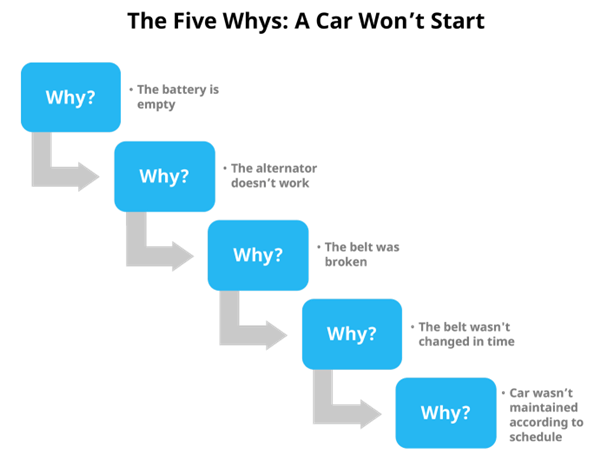
You could wish to find out why a team delivered a product late and what could have been done differently, for instance. You might also notice a drop in productivity. You can speculate that the cause is that perhaps more people are taking sick leaves than before. But if you look closer, can you determine why sick days are occurring more frequently than before? The 5 Whys can also aid in thinking differently and removing preconceptions.
Tips for implementation: While you could use this in your own thoughts, it’s ideal to put together a skilled team that can assist you in the process for more challenging issues. You can do this by organizing a time-limited meeting on a particular issue that needs to be resolved.
You identify the issue beforehand, gather everyone together, and launch the 5 Whys exercise to begin investigating all sides of the situation. You might hire a facilitator to lead the meeting and take notes for a smoother workflow.
4. Fishbone diagram
What is it: This image, also known as the Ishikawa diagram, is used in root cause analyses to indicate various causes of an occurrence. Professor Kaoru Ishikawa first discussed it as a quality control tool in the 1960s. The fishbone diagram is frequently employed in product design and defect prevention to pinpoint the potential contributing variables.

Case Study
For instance, the fishbone diagram is used in quality assurance and performance improvement (QAPI) by the CMS (Centers for Medicine & Medical Services). In this instance, they delve further to discover what procedures and systems result in a patient being hurt while receiving medical treatment.
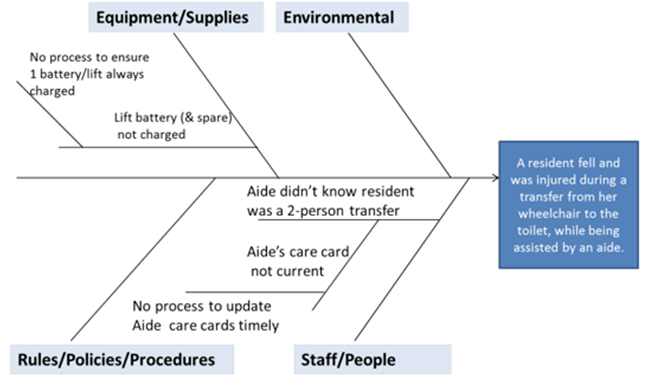
The interaction between causes might make things more difficult in the fishbone diagram for more complicated problems. Furthermore, it’s not always simple to identify every element that contributes to a problem. However, there can be so many parts to point out that it would be difficult to manage them in a straightforward diagram format. Thus, using the technology effectively requires some experience, a skilled team, and the appropriate setting.
Tips for implementation: When unsure of where to begin, some people design the main framework and list each cause-and-effect component that will be created in the fishbone diagram using the 5 Whys method.
5. Gemba walks
What is it: Another well-liked item in the toolbox of continuous improvement is the Gemba walk. It can be summed up as an observing practice where managers and leaders keep up with the inner workings of the company. Gemba, which translates to “the place to be” in Japanese, refers to the places in an organization where value is produced. Therefore, it makes sense that the Gemba walks would be implemented in places where things are accomplished. This may occur on a factory floor, in a hospital operating room, on a construction site, and so forth.
Even though it might not seem like much, a Gemba walk is not a stroll through the park. Careful planning and seasoned leaders with the ability to recognize problems from a distance are required.
Tips for implementation: As previously said, there should be a clear aim and a well-defined plan for Gemba walks. Consider your objectives for the Gemba trek first. Do you have a particular goal in mind that you’d like to learn, comprehend, accomplish, or address? Do you wish to examine the current status of the used procedures or the operation of the communication channels.
Another thing to bear in mind is that leaders should refrain from interjecting or pointing out problems that others should fix during these Gemba walks. As a manager or leader conducting a Gemba walk, your responsibility should be to observe and be receptive to learning about what others are doing and why.

Case Study
Here, a map of the topics you wish to cover can be useful (for instance, you start with sales and go on to shipping, assembly line, and so on). Create a checklist, particularly in the beginning when you are still getting the hang of it. An illustration of a Toyota Gemba walk plan is provided below.

6. mapping a value stream
What is it: Value stream mapping is a visual technique that is used to depict and organize the processes taken in the delivery of a good or service from the supplier to the client.
The analysis, management, and identification of inefficiencies and potential for value stream improvements are made easier by the visual representation of such processes.
VSM was initially employed in manufacturing, as is the case with other Lean approach tools and processes, but it has since been embraced by many other industries due to its success in continuously boosting productivity and decreasing and eliminating waste. A value stream map is used to illustrate the links and processes in manufacturing, production, scheduling, and other areas.
For instance, value map streaming can be used to find inefficiencies in the software development process.
Consequently, the team can reduce the number of steps or redundancies.

Tips for implementation: Start with a problem that needs to be repaired in the first place. On the basis of this, you gather information, do various analysis, and search for solutions. You draw the present state map to get a better perspective and to be able to spot the gaps and contradictions. You will comprehend the information and material flow better in this manner. Now that you have identified the problems, you can outline potential solutions. To depict the intended state of the process following enhancements, you develop a future state map last.
Organizations that operate with intricate processes with numerous touch points can benefit from using this technology. It is not, however, a tool with several uses that can be applied to many issues. If you have a problem that is unrelated to the flow or you don’t have a linear flow of information and material, this might not be the solution for you because the major goal is to eliminate waste.
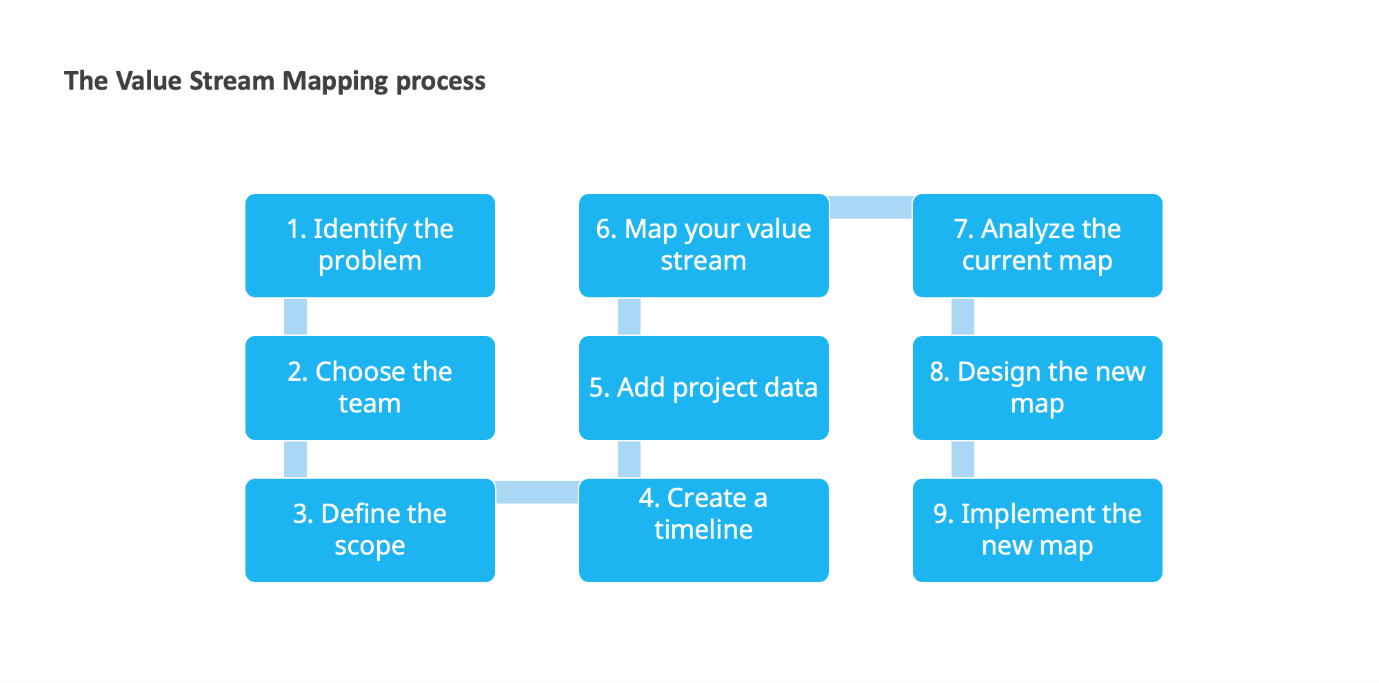
7. 5s
What is it: The 5s is a method for organizing a workplace and revealing waste and irregularities. It can be used to find workplace improvements by taking the following five steps:
• Sort (Seiri) is about arranging all items and eliminating unnecessary things from the workplace.
• Set in order (Seiton) is about putting everything in order, to its designated space, so they are easy to locate.
• Shine (Seiso) is about a clean workspace that creates a safe, easy to work environment.
• Standardize (seiketsu) helps you establish procedures and schedules that ensure the repetition of the previous three practices.
• Self-discipline (sustain). Last, but not least, in order to turn these into a continuous practice, you have to ensure that the approach is followed and that it becomes a habit for employees.
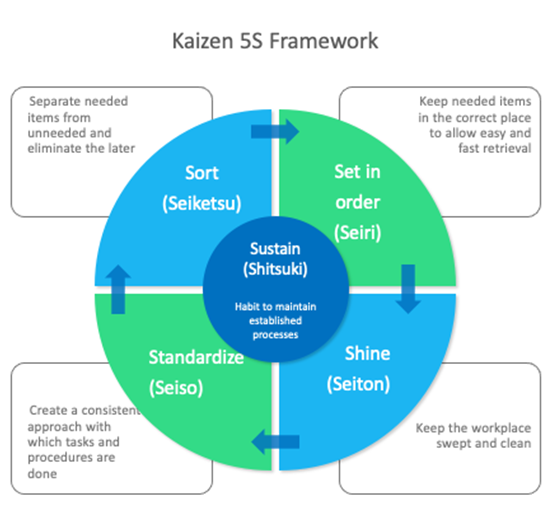
The 5S structure is primarily intended for physical workplaces, such manufacturing floors, as the words suggest. However, in today’s hybrid physical/virtual workplace, these same ideas still hold true. Today, the 5S is used in a variety of sectors including government, education, and the healthcare industry.
The majority of current lean tools and concepts are built around the 5S. Its low cost and strong impact make it advantageous because its implementation doesn’t cost a lot of money.
Tip for implementation: It is essential to have senior management support in order to successfully implement 5S practices. Leaders must set an example, offer training to all employees, and designate a person in charge of each task. Their dedication and an action plan will guarantee that the 5s practices will continue.
Audits are also crucial for maintaining the program and tracking its development and outcomes. This methodology and instrument for continuous improvement has similar difficulties to the majority of others. Some people would object, and there might not be agreement on how the ideas should be used.
Additionally, maintaining continuity may become difficult if important program participants leave the organization or if team structures change. Make sure everything is clearly documented to avoid this from happening, for instance in an implementation handbook that covers the principles, structures, and activities.
8. Error Checking
What is it: Another methodology used in lean management and production is error proofing (or mistake-proofing from the Japanese Poka-Yoke). Error proofing is frequently employed as a standardization tool to make sure that all requirements are satisfied before carrying out a process’s steps.
Anywhere there are processes that rely on people’s knowledge, expertise, and focus, mistake proofing can be used. Think of the de-icing layer that is put to airplane wings prior to each takeoff to prevent serious mishaps, the color coding of wires to prevent short-circuiting, or the electrical connections created to prevent incorrect plugging, to mention just a few.

Case Study
For businesses, the cost of not preventing errors and blunders can be very high. When more than four million laptops had to be recalled because their lithium-ion batteries posed a fire risk, Dell and Sony suffered losses of almost $400 million.
Tips for implementation: You need to either stop errors from happening or find them as they happen for error proofing to work effectively. Similar to other tools and approaches, top management’s commitment and support, as well as an action plan to spread the proper practices, are crucial.
9. SIPOC diagram
What is it: The DMAIC methodology uses the SIPOC (suppliers, input, process, outputs, customers) diagram as a visualizing tool to emphasize the key stages of the process.
It promotes mutual understanding and brings people together around the subject or issue at hand.
In order to determine results and spot inefficiencies along the route, the SIPOC diagram is utilized to specify the inputs and outputs of the process.
Tips for implementation: SIPOC can be as easy as a table in which the five components of the diagram are listed. The process includes the following steps: the suppliers engaged, the inputs—the most crucial resources needed, the process connecting the inputs to the outputs and the processes involved, the outputs and the process’s main outcomes, and finally, the client who will profit from the outputs.
Before drawing a SIPOC diagram, make a list of certain important components, such as the process’s owner, name, start and end dates, known limitations, and feedback loops that will specify how you will interact during the process.
It’s usually best used in conjunction with other tools that can aid in problem solving, even though it’s excellent for presenting the big picture and improving upon the current processes.

Exercise 1.3: Kaizen Simulation Game
Materials needed:
1. Paper or a whiteboard for recording data
2. Stopwatches or timers
3. Scorecards or performance tracking sheets
Instructions:
1. Divide students into 2 groups of 5.
2. Explain the concept of continuous improvement and its significance in organizations. Highlight how small changes can lead to significant improvements over time.
3. Introduce the Kaizen Simulation Game, where each group represents a production line or a team in a manufacturing process.
4. Provide a set of instructions and rules for the game, including the desired outcome, time limit, and performance metrics. For example:
• Each group needs to assemble a specific product (such as a puzzle or a Lego structure).
• The goal is to complete the assembly as quickly as possible while maintaining quality.
• Each group will have a fixed time (e.g., 10 minutes) to complete the task in the initial round.
• Record the time taken and any errors or quality issues observed.
• Emphasize the importance of teamwork, communication, and problem-solving during the exercise.
5. Start the first round of the game, allowing each group to complete the task within the given time limit. Note down the results, including the time taken and any errors or quality issues.
6. Facilitate a debriefing session after the first round, discussing the results and observations. Ask students to reflect on the challenges faced and potential areas for improvement.
7. Introduce the concept of continuous improvement and explain how small changes can be implemented to enhance performance. Discuss different improvement techniques like eliminating waste, streamlining processes, and fostering teamwork.
8. Encourage each group to brainstorm and implement at least one improvement idea for the next round. Examples of improvements can include rearranging the workspace, optimizing task allocation, improving communication, or refining the assembly process.
9. Conduct subsequent rounds, allowing each group to implement their improvement ideas and measure the impact on performance. Repeat the process for multiple rounds, encouraging groups to make further improvements after each round.
10. Facilitate discussions between rounds to share insights, lessons learned, and best practices. Encourage students to analyze the data, measure the progress, and assess the impact of their improvement efforts.
11. Conclude the exercise with a final debriefing session, highlighting the overall improvements achieved by the groups and the importance of continuous improvement in organizations.

Course Manual 4: Improving Performance.
Continuous improvement is a management philosophy and practice that has the power to transform organizations by boosting productivity and enhancing organizational performance. It encompasses a set of principles, methodologies, and tools aimed at driving incremental and ongoing improvements in various aspects of an organization’s operations. By embracing continuous improvement, organizations can achieve higher levels of efficiency, effectiveness, and competitiveness.
One of the key benefits of continuous improvement is its ability to identify and eliminate waste. Waste can manifest in many forms within organizations, including unnecessary steps, overproduction, excess inventory, defects, and waiting time. Continuous improvement methodologies, such as Lean and Six Sigma, provide organizations with systematic approaches to identify and eliminate these wastes. By streamlining processes and reducing waste, organizations optimize their resources, reduce costs, and enhance productivity.
Streamlining processes is another critical aspect of continuous improvement. Organizations often find themselves burdened with complex and convoluted processes that hinder productivity. Continuous improvement encourages organizations to critically evaluate their existing processes and identify areas for improvement. Through the use of process mapping, value stream analysis, and other improvement techniques, organizations can streamline their processes, remove non-value-added activities, and create a more efficient workflow. This leads to improved productivity, faster delivery times, and enhanced customer satisfaction.
A fundamental aspect of continuous improvement is the empowerment of employees. Recognizing that employees are valuable assets, continuous improvement encourages their active participation in improvement initiatives. Employees are the ones who are closest to the work processes and have valuable insights into areas that can be improved. By involving employees in problem-solving and decision-making, organizations tap into their knowledge, creativity, and expertise. Employees who are empowered to contribute ideas for improvement feel a sense of ownership and motivation, leading to increased engagement and productivity.
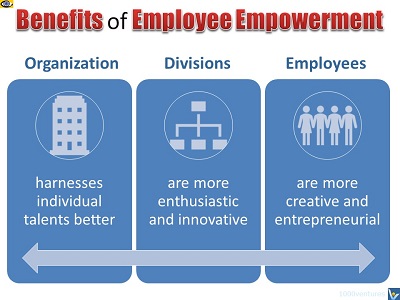
Cultivating a learning culture is another critical element of continuous improvement. Continuous improvement recognizes that organizations must embrace a mindset of continuous learning and growth to stay ahead. It encourages employees to seek out new knowledge, share best practices, and learn from both failures and successes. Organizations can create opportunities for training, cross-functional collaboration, and knowledge sharing to foster innovation, enhance problem-solving skills, and drive performance improvements. A learning culture supports employees in adapting to changes, acquiring new skills, and finding innovative solutions to challenges, ultimately boosting productivity and organizational performance.
Standardization plays a vital role in continuous improvement. By developing and implementing standardized practices and procedures, organizations ensure consistency and reliability in their operations. Standardization reduces errors, variations, and confusion, thereby enhancing efficiency. When employees have clear guidelines and standardized processes to follow, they can perform their tasks more effectively. Standardization improves productivity by providing a common framework for work, enabling employees to focus on value-added activities and achieve higher levels of performance.
Continuous improvement also encourages organizations to foster a culture of innovation. Innovation is essential for organizations to thrive in today’s rapidly changing business landscape. Continuous improvement provides a platform for employees to generate and implement innovative ideas. It creates an environment that supports and rewards experimentation, risk-taking, and creative problem-solving. By empowering employees to contribute to innovation efforts, organizations can improve products, processes, and services. This leads to increased productivity, competitive advantage, and customer satisfaction.
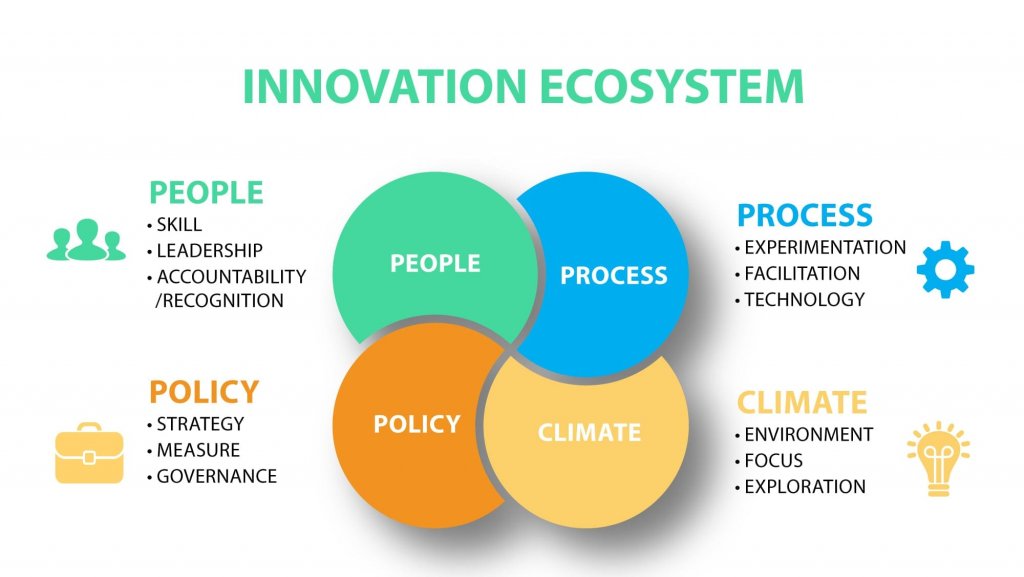
Enhancing quality is another significant aspect of continuous improvement. Continuous improvement methodologies emphasize the importance of quality enhancement as a means to drive organizational performance. By implementing robust quality control measures, organizations can identify and rectify defects, reduce rework, and prevent errors. Improved quality not only increases productivity by reducing waste and rework but also enhances customer satisfaction. Organizations that consistently deliver high-quality products and services build a strong reputation, cultivate customer loyalty, and achieve long-term success.
Data-driven decision making is a fundamental principle of continuous improvement. By collecting and analyzing relevant data, organizations gain insights into their current performance and identify areas for improvement. Key performance indicators (KPIs) serve as valuable metrics to measure progress and guide decision making. Data-driven decision making enables organizations to focus on the most critical improvement opportunities, prioritize resources effectively, and achieve sustainable productivity gains. Organizations can leverage technology and data analytics tools to collect, analyze, and visualize data, thereby facilitating informed decision making.
Continuous learning and training are crucial components of continuous improvement. By investing in ongoing learning and training initiatives, organizations enable employees to acquire the necessary knowledge, skills, and tools to perform their tasks more efficiently. Continuous learning ensures that employees stay updated with the latest industry trends, best practices, and technological advancements. This enhances individual competency levels and fosters a culture of continuous improvement, where employees actively seek ways to improve their work processes. Continuous learning and training contribute to increased productivity and organizational performance.
Lastly, continuous improvement emphasizes a customer-focused approach. Organizations must understand and meet customer needs to achieve sustainable success. By adopting a customer-centric mindset, organizations align their processes, products, and services with customer requirements. Continuous improvement methodologies help organizations gather customer feedback, analyze customer preferences, and adapt their operations accordingly. This results in improved customer satisfaction, increased repeat business, and positive word-of-mouth. Satisfied customers become loyal advocates, leading to business growth, market share expansion, and enhanced organizational performance.
In conclusion, continuous improvement is a powerful driver of productivity and organizational performance. By embracing continuous improvement, organizations can identify and eliminate waste, streamline processes, empower employees, foster a learning culture, standardize practices, encourage innovation, enhance quality, make data-driven decisions, promote continuous learning and training, and adopt a customer-focused approach. These factors collectively contribute to increased productivity, efficiency, effectiveness, and competitiveness. Continuous improvement enables organizations to adapt to changing market conditions, seize opportunities for growth, and achieve sustained success in today’s dynamic business environment.

Case Study
1. Toyota Production System (TPS): The Toyota Production System is a renowned example of continuous improvement in the automotive industry. Toyota’s focus on eliminating waste, streamlining processes, and empowering employees has led to significant improvements in productivity and quality. By implementing lean manufacturing principles, such as just-in-time production and continuous flow, Toyota achieved remarkable efficiency gains and became a global leader in the automotive industry.
2. General Electric (GE): GE implemented the Six Sigma methodology to drive continuous improvement and enhance organizational performance. Through a rigorous focus on data-driven decision making and process improvement, GE was able to streamline operations, reduce defects, and increase productivity. The company estimated that Six Sigma initiatives generated billions of dollars in savings and significantly improved customer satisfaction.
3. Amazon: Amazon is known for its relentless pursuit of continuous improvement. Through its “kaizen” philosophy, Amazon encourages employees at all levels to identify and implement improvements in their work processes. This commitment to continuous improvement has resulted in highly efficient operations, such as optimized warehouse layouts, streamlined order fulfillment processes, and advanced data analytics for demand forecasting. Amazon’s focus on continuous improvement has helped it become a global e-commerce giant.
4. Xerox Corporation: Xerox implemented a comprehensive continuous improvement program called “Leadership Through Quality” in the 1980s. This program focused on empowering employees, enhancing quality, and driving productivity improvements. By promoting employee involvement, Xerox achieved significant cost savings, reduced defects, and improved customer satisfaction. The program also played a vital role in transforming the company’s culture and creating a customer-focused mindset.
5. Boeing: Boeing, a leading aerospace company, implemented continuous improvement practices to enhance manufacturing processes and product quality. By applying Lean principles, such as value stream mapping and waste reduction, Boeing achieved substantial improvements in productivity and efficiency. The company’s continuous improvement initiatives resulted in reduced production time, increased output, and improved overall performance.
These case studies demonstrate how organizations across different industries have leveraged continuous improvement methodologies to drive productivity and improve organizational performance. By embracing a culture of continuous improvement, these companies were able to optimize their processes, engage employees, enhance quality, and deliver value to their customers. These success stories highlight the transformative impact of continuous improvement on organizational success.

Exercise 1.4: Performance Improvement Action Plan
Objective: The objective of this exercise is to engage participants in developing a comprehensive action plan to improve organizational performance. Participants will identify key areas for improvement, set measurable goals, and outline strategies and initiatives to enhance performance.
Instructions:
1. Divide participants into small groups of 5 people.
2. Introduce the workshop objective: Explain that each group will work together to create an action plan to improve the performance of a specific department or aspect of the organization.
3. Assign each group a specific department or aspect of the organization to focus on (e.g., sales department, customer service, production process, employee engagement).
4. Provide participants with relevant information about the department or aspect they are assigned. This information may include current performance data, challenges faced, customer feedback, and any existing improvement initiatives.
5. Instruct the groups to analyze the current state of their assigned department or aspect and identify key areas for improvement. Encourage them to consider both quantitative and qualitative factors such as productivity, quality, customer satisfaction, employee morale, and efficiency.
6. Once the improvement areas are identified, ask the groups to set specific, measurable, achievable, relevant, and time-bound (SMART) goals for each area. The goals should be aligned with the overall objectives of the organization.
7. Allocate time for the groups to brainstorm and develop strategies and initiatives to achieve their identified goals. They should consider both short-term and long-term actions and determine the resources, timelines, and responsibilities required for each initiative.
8. Each group will present their action plan to the rest of the participants. They should clearly outline the improvement areas, goals, strategies, initiatives, and expected outcomes. Encourage them to use visual aids, such as charts or diagrams, to enhance the presentation.
9. Facilitate a discussion and encourage participants to provide feedback and suggestions on the presented action plans. Discuss common themes, innovative ideas, and potential challenges in implementing the plans.
10. Summarize the key takeaways from the exercise and emphasize the importance of monitoring progress, adjusting strategies as needed, and fostering a culture of continuous improvement to sustain organizational performance enhancements.

Course Manual 5: Setting Strategy
Introduction:
Continuous improvement is a powerful approach that drives organizational success by fostering a culture of ongoing enhancement and innovation. To harness the full potential of continuous improvement, organizations need to develop a strategic framework that aligns improvement initiatives with their short- and long-term goals. By setting a clear strategy for continuous improvement, organizations can ensure that improvement efforts are focused, prioritized, and effectively contribute to the achievement of organizational objectives. This article will delve into the importance of setting a strategy for continuous improvement and provide insights into developing a strategic framework that maximizes the benefits of continuous improvement initiatives.

The Importance of a Strategic Framework:
While continuous improvement emphasizes the need for ongoing enhancement, it is crucial to have a strategic framework in place to guide improvement efforts. Without a clear strategy, organizations may find themselves engaged in ad hoc or scattered improvement activities that lack direction and fail to deliver significant results. A strategic framework for continuous improvement provides a roadmap that aligns improvement initiatives with organizational priorities, goals, and values. It ensures that improvement efforts are integrated into the fabric of the organization, creating a cohesive and purposeful approach to enhancing performance.

Case Study: Apple
Apple is a multinational technology company known for its innovative products and distinctive brand. The company follows a strategic framework known as the “Apple Ecosystem.”
The Apple Ecosystem is a comprehensive approach that integrates hardware, software, and services to create a seamless and interconnected user experience. Here are some key elements of Apple’s strategic framework:
1. Vertical Integration: Apple controls every aspect of its products, from design and manufacturing to software development and retail. This vertical integration allows Apple to ensure tight integration between hardware and software, resulting in a cohesive user experience.
2. Design Excellence: Apple places great emphasis on design aesthetics and user-friendly interfaces. The company’s products are known for their sleek and intuitive designs, which contribute to their appeal and differentiation in the market.
3. Interconnected Devices: Apple’s ecosystem is built on the idea of seamless integration between its devices, including iPhones, iPads, Macs, Apple Watches, and Apple TVs. These devices work together harmoniously, allowing users to sync data, access content, and seamlessly transition between devices.
4. Software and Services: Apple’s ecosystem is supported by its proprietary software and services, such as iOS, macOS, iCloud, iTunes, the App Store, and Apple Music. These offerings provide a seamless experience across devices, encourage customer loyalty, and drive recurring revenue through subscriptions and app purchases.
5. Retail Strategy: Apple’s retail stores play a crucial role in its strategic framework. The stores serve as physical touchpoints where customers can experience Apple’s products firsthand, receive personalized assistance, and participate in workshops and events.
The Apple Ecosystem framework has been instrumental in Apple’s success, fostering customer loyalty, and creating a unique and differentiated brand experience. It enables Apple to offer a cohesive and interconnected product ecosystem, enhancing user satisfaction and driving customer retention.
A strategic framework for continuous improvement serves several key purposes:
1. Alignment with Organizational Goals: By setting a strategy for continuous improvement, organizations ensure that improvement initiatives are aligned with their overall goals and objectives. This alignment ensures that improvement efforts directly contribute to organizational success and drive progress in areas that are critical for achieving strategic outcomes.
2. Prioritization of Improvement Efforts: A strategic framework helps organizations prioritize improvement initiatives based on their potential impact and alignment with organizational goals. It allows organizations to focus their resources and efforts on the most critical areas that will drive the greatest value and deliver the desired results.
3. Resource Allocation: Continuous improvement initiatives require resources, including time, budget, and personnel. A strategic framework enables organizations to allocate resources efficiently and effectively by identifying the areas of highest priority and allocating resources accordingly. This ensures that improvement initiatives receive the necessary support and investment to succeed.
4. Clear Communication and Engagement: A strategic framework provides clarity and direction to employees regarding the organization’s continuous improvement efforts. It helps communicate the importance of improvement initiatives, their link to organizational goals, and the role that employees play in driving improvement. This clear communication fosters employee engagement and encourages active participation in improvement initiatives.
Developing a Strategic Framework for Continuous Improvement:

Developing a strategic framework for continuous improvement involves several key steps:
1. Define Organizational Goals and Priorities: The first step is to clearly define the organization’s short- and long-term goals. This includes identifying key performance indicators (KPIs) and understanding the critical areas that require improvement. By aligning improvement efforts with organizational goals, organizations can ensure that improvement initiatives have a meaningful impact on performance.
2. Conduct a Current State Assessment: Before developing improvement strategies, it is essential to assess the organization’s current state. This involves analyzing existing processes, identifying areas for improvement, and understanding the root causes of inefficiencies or bottlenecks. This assessment provides a baseline against which progress can be measured and helps identify the areas where improvement efforts should be focused.
3. Establish Improvement Priorities: Based on the current state assessment and organizational goals, it is necessary to prioritize improvement initiatives. This involves evaluating the potential impact of each improvement opportunity, considering factors such as resource requirements, feasibility, and alignment with organizational priorities. Prioritization ensures that improvement efforts are targeted towards areas that will generate the most significant benefits.
4. Develop Improvement Strategies: Once improvement priorities have been established, organizations can develop improvement strategies. Improvement strategies outline the approaches, methodologies, and tools that will be used to drive continuous improvement. For example, organizations may choose to implement Lean Six Sigma methodologies, establish cross-functional improvement teams, or adopt technology-driven improvement initiatives. The strategies should be tailored to the specific needs and context of the organization.
5. Set Goals and Targets: To track progress and measure the success of continuous improvement initiatives, it is essential to set specific goals and targets. These goals should be aligned with the organization’s overall objectives and be measurable. By setting clear goals and targets, organizations can monitor progress, celebrate successes, and identify areas where improvement efforts need to be intensified.
6. Establish Key Performance Indicators (KPIs): KPIs serve as metrics to assess the effectiveness of improvement initiatives. Organizations should establish KPIs that are aligned with their improvement priorities and provide meaningful insights into performance. These KPIs should be regularly monitored and reviewed to track progress, identify trends, and take timely corrective actions when needed.
7. Implement Continuous Improvement Initiatives: With the strategic framework in place, organizations can begin implementing continuous improvement initiatives. These initiatives can take various forms, such as process improvement projects, employee training programs, suggestion systems, or innovation initiatives. The key is to ensure that improvement efforts are aligned with the defined strategy, and progress is regularly measured and evaluated.
8. Foster a Culture of Continuous Improvement: A strategic framework for continuous improvement should also include strategies to foster a culture of continuous improvement within the organization. This involves creating an environment that encourages and rewards innovation, collaboration, and learning. It requires providing training and support to employees, recognizing and celebrating improvement successes, and embedding continuous improvement principles into the organization’s values and behaviors.
9. Monitor, Evaluate, and Adjust: Continuous improvement is an iterative process, and it is essential to monitor the progress of improvement initiatives, evaluate their effectiveness, and make adjustments as needed. Regular reviews of improvement initiatives and their impact on performance help identify areas for further improvement and ensure that the strategic framework remains relevant and responsive to changing organizational needs.
Conclusion:
Setting a strategic framework for continuous improvement is crucial for organizations aiming to maximize the benefits of improvement initiatives. By aligning improvement efforts with organizational goals, prioritizing improvement opportunities, and establishing clear strategies and targets, organizations can enhance productivity and achieve sustainable performance improvements. Moreover, a strategic framework provides a roadmap for continuous improvement, fosters employee engagement, and ensures that improvement efforts are integrated into the fabric of the organization. Through the strategic alignment of improvement initiatives, organizations can create a culture of ongoing enhancement and innovation, positioning themselves for long-term success in today’s dynamic business environment.

Exercise 1.5: 5 Whys Root Cause Analysis Exercise
Materials needed:
1. Paper or a whiteboard for recording data
2. Pens or markers
Instructions:
1. Divide students into small groups (5 members per group).
2. Explain the concept of continuous improvement and the importance of identifying and addressing root causes of problems in organizations.
3. Introduce the “5 Whys” technique, which involves asking “why” repeatedly to delve deeper into the underlying causes of a problem.
4. Provide a real or hypothetical problem scenario to each group. For example, the scenario could be a manufacturing defect, a customer complaint, or a process inefficiency.
5. Instruct each group to use the “5 Whys” technique to identify the root cause of the problem. They should ask “why” at least five times, with each answer leading to a deeper understanding of the issue.
6. Provide paper or a whiteboard for each group to record their analysis and findings.
7. Allow sufficient time for the groups to discuss and analyze the problem using the “5 Whys” technique.
8. Once the groups have identified the root cause, ask them to brainstorm potential corrective actions or solutions to address the identified issue.
9. After the allotted time, bring the groups together for a debriefing session.
10. Ask each group to present their problem scenario, the identified root cause, and the proposed corrective actions.
11. Facilitate a discussion among the groups, encouraging them to compare their findings, share insights, and evaluate the effectiveness of the proposed solutions.
12. Summarize the exercise by emphasizing the importance of root cause analysis and continuous improvement in problem-solving. Discuss how organizations can use this technique to prevent problems from recurring and drive ongoing improvement.

Course Manual 6: Aligning Goals
You understand how crucial it is to support your team members in setting and achieving their goals as a team facilitator. However, did you know that coordinating team goals with corporate objectives can also improve the output, inspiration, and engagement of your team? This article will teach you how to set and express team goals that are consistent with the vision and mission of your company, as well as how to track your team’s development and accomplishments.
Why Should Team Goals And Organizational Goals Be Similar?
When team goals and organizational goals are in line, your team will have a clear sense of direction and will be working for the success of the organization as a whole. As a result, your team members may feel more driven, valued, and committed to their duties. As they share a same goal and work together to achieve it, it can also promote teamwork, accountability, and trust among team members.
Employee Goal Alignment with Corporate Objectives: A Playbook
Employees may put in a lot of effort and seem to be great at their employment to a casual observer when their aims aren’t in line with corporate objectives, but what are they striving toward?
In performance management, goal alignment makes sure that everyone in the organization, at all levels, is cooperating to achieve the same business objectives.
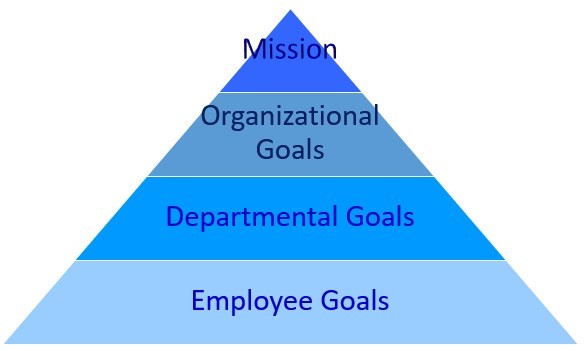
What Should Be Achievable With Goal Alignment
Goal alignment should encourage shared values, increase corporate transparency, and provide context for individuals to establish their own and their teams’ goals.
Encouragement of Shared Values
Employees shouldn’t or don’t work alone. The organization’s mission, vision, values, and strategic goals should be clear to them.
What is the purpose of the company? What does achievement entail? What part do their individual efforts play in that achievement?
By ensuring that employee efforts have an impact in ways that are meaningful and measurable, goal alignment aids in the promotion of shared values.
Shared alignment fosters stronger departmental and team collaboration as well as a sense of camaraderie that can raise morale, lower attrition, and increase productivity.
Offering more transparency
Every employee need knowledge of their performance. This understanding can be gained by information on the performance of their team, department, and organization as a whole, as well as through direct feedback they receive from their bosses.
Goal alignment provides more transparency so that workers can see the results of their efforts and the efforts of their coworkers. Greater transparency means that all employees in the organization participate in projects and goals.
Providing Background
The majority of employees struggle to succeed on their own. To accomplish particular aims or objectives, they collaborate in teams.
Employees who are working toward aligned goals are better able to see how their efforts support team and company objectives. Employees are able to perform more effectively and with more job satisfaction thanks to this environment.
How to Balance Individual Goals With Organizational Objectives
It takes a few measures to successfully align individual goals with company objectives in order to achieve comprehension, support, and participation. Here are three guidelines for coordinating individual objectives with those of the company:
1. Set escalating objectives
Setting cascading goals that will spread throughout the business is the first step in coordinating personal and organizational goals. This may take place just once a year, twice a year, or even four times a year. Departments, teams, and individuals determine their goals based on the direction that leadership has established for the organization.

Investment business Betterment discovered this strategy to be very successful. They concentrated on just two main business objectives:
1. Increase net deposits
2. Boost performance
According to CEO Joe Stein, “We thought it was perfect, having one revenue-driving metric and one efficiency metric. It was a clear signal to the team what was most important.”
Teams were given different objectives, and each team was given one to three goals that were related to the objectives. Teams returned with their own figures that complemented the overall strategy.
2. Follow everything in one location
As was already mentioned, enabling employees to monitor their performance on a continuous basis is a crucial component of goal alignment. Create a mechanism to track each person’s, the team’s, and the organization’s goals simultaneously after cascading goals have been established.
Metrics are accurate and everyone is viewing the same data when everything is tracked in one location. Additionally, it aids staff members in recalling the organization’s objectives and the effects of their contributions.
3. Put metrics online
Every employee benefits from having access to metrics that show how they and their teams are doing in relation to organizational objectives. This was accomplished by Betterment in a few distinct ways. They regularly emailed all employees to share the most recent data, and they also displayed top-line figures on walls for the entire organization to view.
This broad level of awareness “built in the ethic that there was no opportunity for teams to deviate from their goals to help another toward theirs,” according to Stein. The availability of measurements, however, produced “a shared sense that it was all hands on deck to make sure that everyone got where they needed to go.”
Making metrics public can be made easier the more reliable the system a corporation uses to track metrics.
But even without an automated method, businesses can still send out changes to staff via email or draw attention to them during routine company meetings.
The most crucial factor is that metrics are widely and frequently made available to all employees so that they can understand how they are performing (and how the business is doing).

Case Study: Goal Alignment in Performance Management
So what does aligning employee goals with corporate objectives look like?
Full-service receivables management is offered by InvestiNet. Owner of the business Bob Collins wanted all 100 of his staff members to say that working at InvestiNet was the best job they had ever had. He saw that performance management provided a chance to organize work around individual and organizational goals.
A multi-tiered system of goals that were often updated was employed by InvestiNet.
The business will establish thematic objectives at the highest level. These set the course for the company and last for around six months. They consist of both transformation initiatives and fundamental success measures.
Then, each person will have goals for the semester. These provide specific areas of attention for workers during the following 90 to 120 days. Each person may have three semester goals.
Each person will have 1-2 job-specific goals in addition to semester goals. These specify what is required of the employee’s position throughout the course of a year according to the organization.
Everybody has at least one objective for their professional progress. Development efforts are virtually always “strengths based.” While occasionally someone would focus on strengthening their flaws, the majority of the time these objectives center on enhancing your unique strengths.
Weekly check-ins between staff members and their managers center on the projects they were working on and how they helped achieve their objectives. Any misalignment is addressed in these meetings with an emphasis on linking routine tasks to the overarching organizational goal.
The question is “did we, the organization, have you working on the right things and what were our results?” Collins stated. An yearly evaluation featured employee self-appraisal along with their supervisors’ review.
The InvestiNet approach serves as an example of how organizations can strategically generate greater business results by coordinating personal objectives with group and corporate objectives. Employees gain understanding of the company’s priorities and how their efforts can benefit the organization by doing this.
How To Recognize Shared Team Objectives
Recognizing and rewarding your team members for their accomplishments and efforts is necessary to celebrate your shared team goals. To recognize and appreciate the efforts and accomplishments of your team, you can employ a variety of rewards and forms of appreciation, including as compliments, suggestions, awards, bonuses, or perks. Celebrations, events, or activities can also be used to foster a joyful environment, strengthen team unity, and boost morale.

Exercise 1.6: Goal Alignment Matrix
Objective: To help employees understand the importance of goal alignment and practice aligning individual goals with organizational goals.
Materials needed:
1. Whiteboard or large paper
2. Markers
3. Sticky notes
4. Goal Alignment Matrix template (can be created on the whiteboard or printed)
Instructions:
1. Begin by explaining the concept of goal alignment and its significance in driving organizational success. Emphasize that when individual goals are aligned with the broader objectives of the company, it creates synergy and improves overall performance.
2. Introduce the Goal Alignment Matrix, which visually represents the alignment between organizational goals and individual goals.
3. Draw the Goal Alignment Matrix on the whiteboard or use a printed template. The matrix should have two axes: “Organizational Goals” along the vertical axis and “Individual Goals” along the horizontal axis. Divide the matrix into four quadrants: “Aligned,” “Misaligned,” “Overlapping,” and “Blank.”
4. Discuss a few key organizational goals with the participants. These goals should be clear, specific, and measurable. Write them along the vertical axis of the matrix.
5. Instruct each participant to think about their individual goals and how they can contribute to the achievement of the organizational goals. Encourage them to consider their roles, responsibilities, and areas of expertise.
6. Provide sticky notes to the participants and ask them to write down their individual goals. Each participant should have multiple sticky notes, one for each goal.
7. Have the participants place their sticky notes on the matrix, positioning them in the corresponding quadrant based on the alignment between their individual goals and the organizational goals.
• If their goal directly contributes to an organizational goal, they should place it in the “Aligned” quadrant.
• If their goal is unrelated to the organizational goals, they should place it in the “Misaligned” quadrant.
• If their goal partially aligns with one or more organizational goals, they should place it in the “Overlapping” quadrant.
• If they don’t have any goals related to the organizational goals, they should place a blank sticky note in the “Blank” quadrant.
8. Once all participants have placed their sticky notes, review the matrix as a group. Discuss the distribution of goals and identify any commonalities or misalignments.
9. Facilitate a discussion on the importance of goal alignment and the potential benefits it brings to individuals and the organization. Encourage participants to share insights and discuss how they can realign their goals for better alignment.
10. Conclude the exercise by emphasizing the need for ongoing goal alignment and the role of regular communication and feedback in maintaining alignment.

Course Manual 7: Building Infrastructure
Can we all agree that an organization’s leadership is the single factor most responsible for success? Yes, we are aware that is a weird question, but consider it.
Is it true that successful coaching, reprimanding, and growth have a direct impact on how employees behave?
But is that sufficient? Hire extremely smart people and allow them to grow through experience? According to our experience, there is still a piece that needs to be added since, if it is not, chaos may result.
The crucial component? Infrastructure.
Infrastructure And Its Importance
Probably you’ve heard the adage “Culture eats strategy for breakfast.” Alternately, “If you pit a good performer against a bad system, the system will win almost every time.” But what do these clever proverbs actually mean?
They imply that the organization’s infrastructure—its systems, procedures, policies, and programs—must support and enable the behaviors that propel organizational performance.
Your performance and productivity will be severely damaged if the infrastructure is teaching or sending a different message. You can teach, communicate, inspire, motivate, and motivate others to accomplish the right work with acceptable behaviors.
With everyone performing their favorite piece, it’s like an orchestra. There is anarchy if they don’t agree. It’s similar to a racing pit crew where everyone rushes to the same tire to mend anything, causing one tire to receive all the attention while the others go flat. The framework for how managers and staff members conduct their operations is infrastructure.
Infrastructure is supported by values but not defined by them.
What do those “values and principles” posted on the wall, which mention things like communication, integrity, and customer service, serve? When addressing leaders and staff, they are referring to the ideal infrastructure and saying, “This is what is important; this is how we expect our team to behave.”
It isn’t sufficient to merely state, “Act with integrity,” or “Communicate effectively,” as those statements are subject to personal interpretation. The answer? programs created to test employee culture fit, pinpoint engagement gaps, and put values into practice.
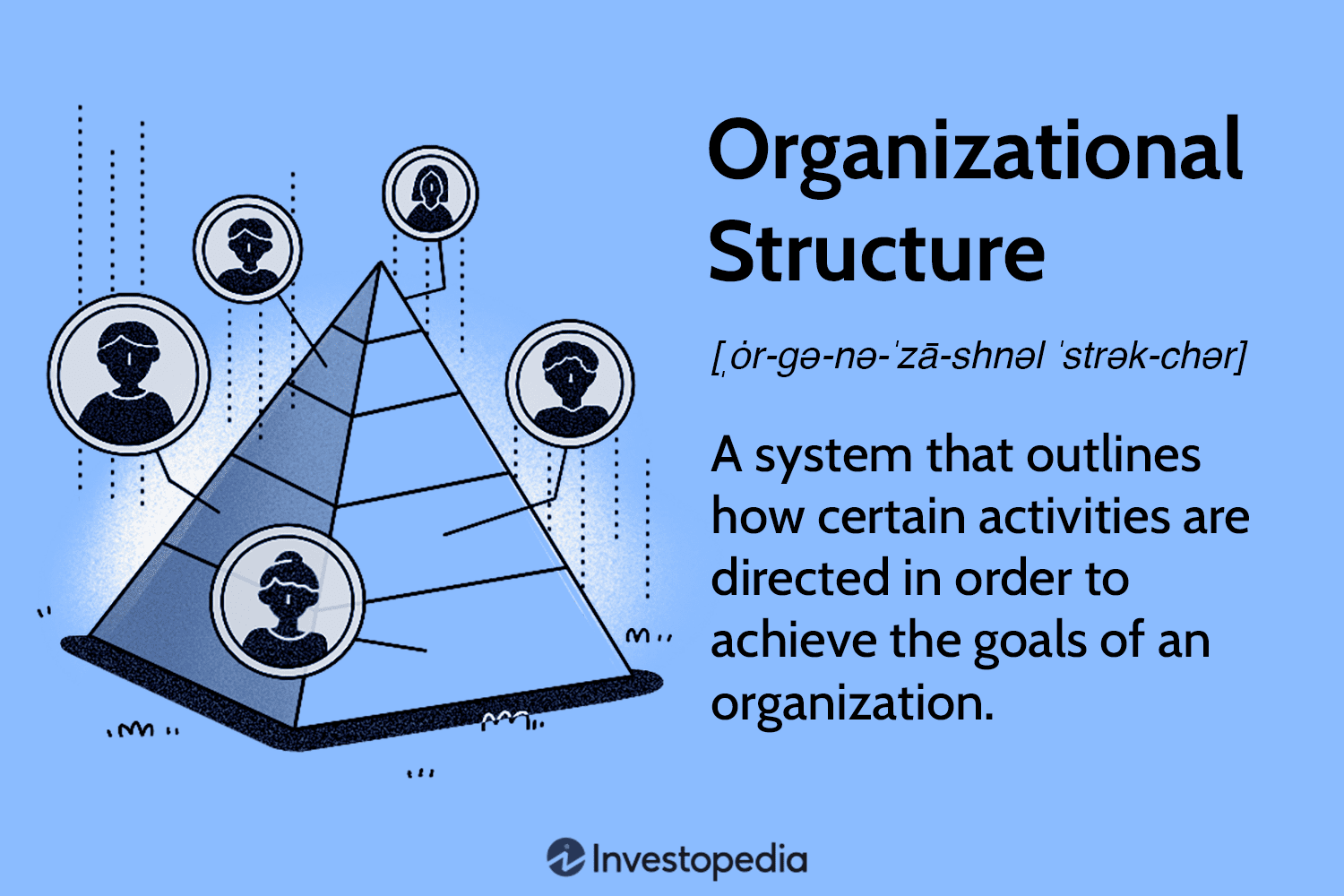

Case Study: Google
One example of a company that values its organizational infrastructure is Google. Google is renowned for its focus on creating a robust and innovative infrastructure to support its operations and enable its employees to work efficiently and effectively. Here are some key aspects that demonstrate Google’s emphasis on organizational infrastructure:
1. Data Centers: Google has built a global network of state-of-the-art data centers to handle its massive amount of user data and provide reliable and fast services. These data centers are designed with redundancy, security measures, and energy efficiency in mind.
2. Technology and Tools: Google invests heavily in developing and maintaining advanced technology and tools that support its employees’ work. This includes their proprietary software systems, collaboration tools like G Suite, and infrastructure frameworks such as Kubernetes for managing containerized applications.
3. Employee Facilities: Google places a strong emphasis on creating a comfortable and inspiring work environment for its employees. Its offices feature unique amenities, including recreational areas, gyms, free meals, and creatively designed workspaces that promote collaboration and creativity.
4. Communication and Collaboration: Google uses various communication and collaboration tools to connect its global workforce. Platforms like Google Hangouts, Gmail, and Google Drive facilitate seamless collaboration and knowledge sharing among employees, regardless of their geographical locations.
5. Research and Development: Google continuously invests in research and development to innovate and improve its infrastructure. Projects like Google Cloud, Google Fiber, and initiatives in artificial intelligence and machine learning demonstrate their commitment to advancing their organizational infrastructure.
6. Sustainability: Google is committed to sustainable practices in its infrastructure operations. The company strives to reduce its carbon footprint through energy-efficient data centers, renewable energy investments, and other environmentally friendly initiatives.
Overall, Google’s focus on organizational infrastructure enables it to deliver high-performance services, foster collaboration, and create a conducive work environment for its employees, aligning with its mission to organize the world’s information and make it universally accessible and useful.
Who then constructs infrastructure?
Modern businesses use a variety of strategies to guarantee that their values are put into practice.
These days, we write employee handbooks that outline proper conduct and spell out consequences for misconduct. We provide comprehensive manager training.
We create pay and benefit structures that honor excellent performance and decency. In order to make sure that the work being done by the organization is in line with the company plan, we put systems in place to set goals and assess performance. We assess the abilities and competences of our leaders and staff members and build plans for ongoing improvement. In order to find and hire new employees who can perform well and fit in with our culture, we often conduct behavioral interviews.
But wait—aren’t these all HR programs? They do, but far too frequently these programs fall short of accomplishing their main goal of creating a foundation based on values. Instead, with HR nagging and policing the programs and emphasizing compliance over strategy and completion over improvement, managers reluctantly fulfill their jobs. Instead, HR programs—which are fundamentally about creating the infrastructure of your organization—should be regularly assessed and adjusted to meet those needs.
Employees may be told through “words on the wall” that they are the company’s most valuable asset, but do managers’ actions support this assertion? Do your words and deeds align? Does the infrastructure you built work, or does it send conflicting signals?
The only person who can take the time to consider these concerns and your organization’s infrastructure is you. Executives, your HR department likely knows the answers to these questions very well. Ask them where there may be opportunities to improve the infrastructure if you want to improve your leadership culture. They undoubtedly have some nice suggestions.
Creating the Ideal Infrastructure for Your Business
Have you ever questioned why certain companies succeed while others struggle? Or why some business owners succeed while so many others fail? Why do some businesses sell for the most money possible, while others only make cents on the dollar or never sell at all?
A lack of understanding frequently lands business owners in difficulty. But the majority of the time, failure is brought on by a lack of implementation.
Lack of revenue, failure, or a hefty buyout is never the cause of the issue; rather, it is a sign that the infrastructure isn’t being used. It is what enables you to develop a profitable, sellable business. You make sure there is a sturdy foundation to withstand any storms that may come your way when you buy, build, or have a house built to keep you and your family safe. The same is true for businesses; having a strong infrastructure will enable you to weather any financial storms you may face along the way and significantly improve your chances of making a profit.
Steve Forbes estimates that only 20% of enterprises that are for sale will really close, leaving business owners with a much lower likelihood of success. Lack of infrastructure is the primary cause of business failure.
Experience shows that entrepreneurs don’t fail to plan; they just fail to execute it. Instead of creating a company that serves them, the majority of business owners have created for themselves a glorified job where they report to work every day.
Usually, if your car is operating poorly, it isn’t firing on all cylinders. The same is valid for your company.
Your business has to be operating at full capacity.
If one of the cylinders is missing, misaligned, or both, the operation will be insufficient, slow, and unprofitable.
Rate your firm on a scale of one to five, with one being the worst and five being the greatest, on each of the following factors to determine whether it is a success or failure:
People: Are the proper persons seated in the appropriate locations? Does your company have a management team, and can it function without you?
Product: Is the market for your good, service, or sector growing or declining? Do you, for instance, run a company similar to Amazon and have premier status? Or are you in the process of going out of business and operate a company similar to Blockbuster? Do you have three to five congruent revenue streams, at the very least?
Processes: Is your product, service, or industry on the way up, or on the way out? For example, do you own a business like Amazon and are in your prime? Or do you own a business like Blockbuster and are about to bust and go out of business? Do you have at least three to five congruent revenue streams?
Proprietary: Do you have a strong brand, federal trademarks, patents, transfer agreements, databases, a sass element, a recurring subscription plan, celebrity endorsements, digital real estate, etc.?
Patrons: Do you have a following of devoted customers that will go out of their way to use your goods or services? Do you have a customer concentration where 20% of your clients provide 80% of your revenue? Or do you have a diverse customer base? Are your current clients aging and in need of replacement by younger generations?
Profits: Are you running your company at the top profit margins in your sector? Are you making money or are you losing it? Have you saved up enough money for working capital for at least a year?
If you use these ideas to create a strong foundation for your company, it will develop into a scalable, profitable asset that can be sold.

How Can You Achieve Excellence in Infrastructure and Operations?
Think of tech solutions that could help your business flourish if you wish to establish faultless infrastructure and operational excellence in addition to cost-saving strategies:
1. Accept Metacloud: Many businesses adopt a multicloud environment strategy. More than 78% of businesses use three or more cloud platforms. A multicloud strategy does, however, come with some complexity related to data repositories and security setups. This then results in increased spending on services and security concerns.
A single-controlled system integrating all cloud platforms may be the metacloud. A business doesn’t have to deal with the same problems for every cloud with this approach. With the help of the metacloud, you can establish a single security configuration and guarantee its implementation on all cloud platforms.
2. Adopt AI Features: AI assists in the collection and processing of enormous amounts of data produced by various IT infrastructure components, detects and alerts users to application performance problems, and can even automatically fix them. Cloud service companies offers a wide range of AI tools. Azure AI features, for instance, let you design AI solutions for common business processes and expose AI models as APIs.
Companies who adopt AI are 1.7 times more likely to succeed than those who don’t. Perhaps for this reason, Microsoft is preparing to include ChatGPT’s functionality in its products.
3. Adopt Platform Engineering: Platform engineering, which derives from DevOps ideas, strives to optimize the delivery of business software solutions. Developing a shared platform for the development team is a component of this evolving technology strategy. They utilize it to develop automated infrastructure operations and self-service deployments.
The platform engineering technique has produced tremendous results, according to a recent report from Yahoo. More than 68% of individuals polled claimed they were able to speed up their development.

Exercise 1.7: Infrastructure Impact Analysis
Objective: To help employees understand the significance of infrastructure in supporting organizational operations and success.
Materials needed:
1. Whiteboard or large paper
2. Markers
3. Sticky notes
4. Infrastructure Impact Analysis template (can be created on the whiteboard or printed)
Instructions:
1. Begin by explaining the concept of infrastructure in an organizational context. Emphasize that infrastructure refers to the physical and digital systems, facilities, and resources that support the smooth functioning of the organization’s operations.
2. Introduce the Infrastructure Impact Analysis exercise and its purpose of assessing the importance of infrastructure.
3. Draw the Infrastructure Impact Analysis template on the whiteboard or use a printed template. The template should have two columns: “Infrastructure Components” and “Impact on Operations.”
4. Brainstorm with the participants to identify various infrastructure components that are relevant to the organization. Examples may include technology systems, communication networks, office facilities, equipment, transportation, data storage, and security systems. Write these components in the left column of the template.
5. Divide the participants into small groups and assign each group a specific infrastructure component to focus on.
6. Instruct each group to discuss and analyze the impact of their assigned infrastructure component on the organization’s operations. Encourage them to consider both positive and negative impacts.
7. Provide sticky notes to each group and ask them to write down the impacts they identified, one impact per sticky note.
8. Have the groups place their sticky notes under the corresponding infrastructure component on the template, capturing the impacts on operations.
9. Once all groups have placed their sticky notes, reconvene as a whole group and review the Infrastructure Impact Analysis. Discuss the impacts identified for each infrastructure component and their significance in supporting organizational operations.
10. Facilitate a discussion on the importance of infrastructure in achieving organizational goals and maintaining efficiency. Encourage participants to share insights and examples of how infrastructure can impact productivity, communication, customer satisfaction, and overall success.
11. Conclude the exercise by summarizing the key takeaways and emphasizing the need for ongoing investment in and maintenance of infrastructure to support the organization’s operations.

Course Manual 8: Standards & Consistency
The daily processes of an organization will be easier to maximize efficiency and productivity the more constant they are. These modifications may then result in increased client satisfaction, decreased expenses, and reduced waste. Here are a few strategies for enhancing consistency in any organization.
1. Making Use of a Management System
Adding a management system to a company is a terrific method to boost productivity. In order to help organizations establish more effective working practices and implement procedures that make them run more efficiently, management systems seek to create a standard way of doing things.
The Quality Management Standard, ISO 9001, can be very helpful when aiming to enhance efficiency inside a firm. There are numerous ISO Standards available, to provide for all industries and business types. With ISO 9001, you can consistently exceed client needs and expectations, which will help you save money, expand your business, and increase revenues. This is accomplished by changing complex or ineffective processes that might result in errors and harm a company’s reputation as well as standardizing operations.
No matter which Standard a firm chooses, it’s critical to ensure that the Management System is in line with both its short- and long-term strategic objectives. This will help to guarantee that any modifications made are the right ones. This includes making the required adjustments to guarantee that systems and processes are continuously improved. To receive an unbiased assessment of their progress toward this objective, ISO Certified companies collaborate with an external auditor.
2. Setting (And Sharing) SMART Objectives
Businesses may naturally increase their efficiency by making sure that everyone inside their organization is working toward the same objectives and nobody is going against the flow.
The most effective goals are those that are SMART (Specific, Measurable, Achievable, Relevant, and Time-bound).
• Specific: If a goal is not clearly stated, progress toward it can be challenging. To prevent misunderstandings and inefficient work, make sure that all corporate goals are clear and accurate.
• Measurable: It might be challenging to decide whether a goal has been attained if there is no means to gauge its achievement. More effective firms consider how they will know when a goal has been attained or not while setting goals.
• Achievable: Larger goals should be broken down into smaller, more manageable ones so that many different areas and changes can contribute to their accomplishment. This will also motivate people to work toward the goals because they don’t seem so far away.
• Relevant: If a company is pursuing irrelevant aims, efficiency could be lost. For instance, if employees are functioning well and there are no service delays, a hiring target is useless because overhead costs would rise without producing any discernible benefits.
• Time-bound: When a customer receives what they want when they want it, a business is considered efficient. The same is true of goals; in order to be successful, they must have a clear timeline.
Making sure that everyone who can help achieve the goal is doing so is an essential step in goal-setting. More effective companies are aware of this and let their personnel and occasionally customers know what they are trying to accomplish. By assigning employees projects and goals that are relevant to the company’s objectives, managers can help their staff feel more motivated to support the enterprise’s objectives.
3. Recognizing The Value Of Employees
Both customers and employees are essential. Without motivated, satisfied workers, staff turnover may rise, productivity may decline, and customer satisfaction may drop.
Employees will work harder, be more productive, and be more engaged if they believe that their employer cares about them. When it comes to general customer service, they will be more likely to go above and above. Additionally, up-selling and cross-selling automatically enhance if employees have faith in the company.
Make sure you have documented policies and procedures that everyone is aware of and abides by since your employees need to know exactly what is expected of them in any circumstance.
Employees should be heard. Create a system that will allow employees to communicate their opinions. Consider their suggestions carefully and, if at all possible, put them into practice, even if just for a short trial. It is recommended practice to explain why these ideas cannot be implemented further if making certain adjustments is not viable. Employee engagement will increase as a result of them seeing the value of their input.
Make it known that everyone is responsible for their own performance while also holding yourself accountable. An organizational dashboard that shows performance measures for the entire business keeps everyone informed and alert.

4. Put The Consumer First
No matter how big or small a business is or what industry it operates in, providing excellent customer service should be at the core of all it does. No matter the reason for their contact, clients of the greatest businesses in this field are aware of what to expect.
Providing personnel with the necessary skills and expertise through intensive, continuing training is a crucial step in guaranteeing consistent customer service.
Training needs to include everything from how the phone is answered, the voice used in email responses, and the demeanor of staff members who interact with customers to understanding of return policies and the capacity to handle any issue or query, no matter how difficult, with fairness and consistency.
Customers will be more loyal and trustworthy if their experience and journey are consistent. Switched-off employees with a lack of product expertise, inadequate training, or authority will alienate clients and drive them to rival businesses’ doors.
5. Maintain The Machinery In Good Condition
The smallest issues can occasionally derail a business. The ink runs out as you attempt to print some information for a client who is waiting. It doesn’t appear expert.
Don’t let your hectic schedule keep you from taking care of all the minor things that need to get done, especially since fixing problems that could have been avoided with frequent checkups can be expensive. Essential maintenance may go unnoticed when a team is pressed for time because employees may be unwilling to take time away from their busy schedules to fix something they feel is not their responsibility.
All employees can be encouraged to help with general activities like clearing away dust and trash, but more specialized jobs like repairing worn-out or broken parts could require outside assistance. In either case, workers should be aware of what to do and who to contact if something goes wrong and should feel empowered to offer assistance if needed.
A company’s slowness and inefficiency, as well as the irritation of both employees and customers, can be caused by outdated systems. In today’s very competitive market, inefficiencies like waiting for slow internet speeds, using outdated software, or using sluggish computers can increase expenses and have a negative impact on reputation. It might be a false economy to ignore these problems. Effective companies periodically assess their equipment to make sure it is fit for purpose and have a system in place for personnel to report problems and have them immediately resolved.
Successful companies and organizations are always looking for ways to improve their consistency and efficiency. Make sure yours is not forgotten.
What constitutes standard work? How should it be used?

Defined Standard Work in Lean Manufacturing
Standardized work is a technique used in lean manufacturing to create accurate processes for producing goods in the safest, simplest, and most efficient manner possible based on current technological advancements.
One of the tenets of lean manufacturing is standard work. There are three things it needs:
1. Take time: The rate at which components or goods must be produced to satisfy consumer demand.
2. Work Sequence: The steps that operators must execute within Takt time, in the correct order.
3. Standard inventory, also known as in-process stock, is the minimal amount of components and raw materials required to maintain operations.
Advantages Of Regular Work
1. decreases variation
Standardized work decreases output variance by standardizing the most effective approach to carry out processes. Work becomes predictable, making it possible to foresee delivery schedules, inventory requirements, and costs.
2. aids your population
Shop floor workers occasionally believe that their highly variable labor cannot be standardized or that putting standards into place will make their work monotonous.
On the contrary, standardizing work improves productivity, freeing up more time for creative endeavors.
Operators can better organize their job by using standard work. By lessening the stress of doing jobs incorrectly, it relieves pressure on operators.
Last but not least, standardizing work makes training considerably simpler by documenting the proper approach to carry out every procedure. It guarantees that new hires receive all the information they require to function on par with other operators.
3. Promotes ongoing progress
Kaizen is the idea of continuous improvement, another Lean principle. A foundation for Kaizen is standard work. Indeed, standardizing and documenting existing methods is the only way to enable objective evaluation of improvements. The process of enhancing standardized work is ongoing, and as standards rise, the new standard for Kaizen serves as the foundation for even greater advancements.
It is more challenging to identify the 8 wastes of lean manufacturing when operators carry out duties differently. In other words, when processes are consistent, it is simpler to identify chances for improvement.

Case Study: McDonald’s Standardized Service Experience
McDonald’s, the global fast-food chain, is recognized for its consistent and standardized service experience across its thousands of restaurants worldwide. The company has successfully implemented standardized processes to ensure that customers receive the same quality of service and food regardless of the location. Here’s a case study highlighting McDonald’s approach to standardized service experience and the benefits it has achieved:
Background: McDonald’s operates in a highly competitive industry, where customer satisfaction and brand loyalty are crucial. To maintain consistency and meet customer expectations, McDonald’s focuses on implementing standardized processes and procedures throughout its restaurants.
Implementation of Standardized Service Experience: McDonald’s follows a comprehensive approach to establish and maintain a standardized service experience:
1. Clear Service Guidelines: McDonald’s provides detailed service guidelines that outline the company’s expectations for customer service. These guidelines cover various aspects, including greeting customers, order-taking, food preparation, cleanliness, and speed of service.
2. Extensive Training: McDonald’s invests heavily in training its employees to ensure they understand and adhere to the standardized service procedures. New hires undergo comprehensive training programs that cover all aspects of their roles, emphasizing the importance of consistency and following established guidelines.
3. Standard Operating Procedures (SOPs): McDonald’s has well-defined SOPs for each operational area, such as food preparation, customer service, and cleanliness. These SOPs outline step-by-step instructions and performance standards that employees must follow to deliver a consistent service experience.
4. Quality Control Measures: McDonald’s implements rigorous quality control measures to monitor and maintain standards across its restaurants. This includes regular inspections, mystery shopper programs, and feedback mechanisms to identify deviations from the standardized service experience.
Application for standard work in 6 simple steps
1. gather information about your existing operations
Establishing your work sequence and Takt time is the first step. Modern manufacturers may automatically measure Takt time and collect data using cloud computing and IoT-connected technologies. Metrics like step time per operator and cycle time are reliably recorded. The ability to see their operations in real time allows manufacturers to know exactly how tasks are being carried out at any given time.

2. Take note of changes and problems
There are frequently multiple ways to complete a work, but only one of them makes best use of the supplies, equipment, and laborers.
Examine the data you have gathered and look for variations. Are there employees whose production differs substantially despite performing the same tasks? Are there any operators going over Takt time? Some jobs might be merged. Where are there problems with quality or safety?
3. Find the most effective operating method for your business
Here is where you want to optimize your work processes and sequence using Lean techniques. For instance, you could use poka-yoke to error-proof your processes or value stream mapping to find non-value-adding stages. Your aim is to discover strategies that are easy to implement, beneficial to everyone, and practical.
4. Record everything
You can approach this in a variety of ways. The use of digital work instructions is one of the easiest methods. An app for manufacturing can be used to provide digital work instructions. They walk operators through procedures step by step with interactive media.
Digital work instructions make sure that workers perform each and every step as specified by your standardized job, ensuring that they adhere to the most recent best practices. More crucially, it only takes a few clicks to alter digital job instructions. As a result, it will be simple for you to maintain your standard work updated and recorded as it changes.
5. Adjust your training initiatives
It’s crucial that staff members are aware of and follow the new standard operating procedures. Current employees may need to undergo retraining for this.
Additionally, you need to guarantee that the new operator training programs you develop are based on your standardized output.
Digital training modules can be quickly created and adjusted in manufacturing apps, much like digital work instructions. The most recent standardized procedures can be self-guided by new staff using videos, graphics, and other multimedia materials.
6. maintain and continually raise the bar
One common error is to believe you are finished once you establish uniform tasks. Instead, you ought to make an effort to raise the bar continually.
Once standardized work is used, it is much simpler to spot anomalies and problems. Every time a problem arises, perform root-cause analysis and develop a new standard that fixes the issue.
Work that is standardized is never flawless or complete. It stands for a current best practice that ought to be questioned every day using Kaizen.

Exercise 1.8: Consistency Challenge
Objective: To help employees understand the significance of consistency in achieving organizational goals and maintaining a positive reputation.
Materials needed:
1. Whiteboard or large paper
2. Markers
3. Sticky notes
4. Consistency Challenge template (can be created on the whiteboard or printed)
Instructions:
1. Start by explaining the concept of consistency in an organizational context. Emphasize that consistency refers to the uniformity and reliability of actions, decisions, and communication within the organization.
2. Introduce the Consistency Challenge exercise and its purpose of highlighting the importance of consistency.
3. Draw the Consistency Challenge template on the whiteboard or use a printed template. The template should have three columns: “Scenarios,” “Consistent Approach,” and “Impact of Inconsistency.”
4. Divide the participants into small groups and distribute sticky notes and markers to each group.
5. Instruct each group to brainstorm and come up with various scenarios where consistency is crucial within the organization. Examples may include customer service interactions, brand messaging, product quality, meeting deadlines, adhering to company policies, and decision-making processes.
6. Ask each group to write down one scenario on each sticky note, ensuring that they capture both positive and negative instances of consistency or inconsistency.
7. Once the groups have prepared their sticky notes, have them place the scenarios in the left column of the template.
8. Instruct each group to discuss and identify a consistent approach or action that should be taken in each scenario to demonstrate consistency. They should write this consistent approach on a new sticky note and place it in the middle column of the template.
9. Next, ask the groups to brainstorm and discuss the potential impact of inconsistency in each scenario. They should identify the negative consequences that can arise from inconsistency. Write down these impacts on sticky notes and place them in the right column of the template.
10. Once all groups have completed the Consistency Challenge template, reconvene as a whole group and review the scenarios, consistent approaches, and impacts of inconsistency.
11. Facilitate a discussion on the importance of consistency in achieving organizational goals, maintaining customer trust, and building a positive reputation. Encourage participants to share their insights and examples of how consistency (or lack thereof) can affect teamwork, customer satisfaction, employee morale, and overall success.
12. Conclude the exercise by summarizing the key takeaways and discussing strategies for promoting consistency within the organization. Emphasize the need for clear communication, standardized processes, and regular training to ensure consistent actions and decision-making.

Course Manual 9: Developing Strategy
How Do I Create a Strategy for Continuous Improvement?
If an organization wants to stay in the game, keep its competitive advantage, and experience long-term success, it must constantly improve. Even while the majority of us are aware of how crucial it is to continuously develop, both on an individual and organizational level, we frequently forget to make it a habit.
For the majority of us, continuous development is basic sense. Whether for personal or professional development, it is something that most people aim to do. Because it gives us purpose, boosts our mood, and is fulfilling, we want to get better and improve.
But after the initial enthusiasm of beginning a new project fades, things proceed similarly to New Year’s resolutions. Until a new project comes along and the pattern repeats, we lose interest, fall back into old habits, and cease getting better.
What is a Continuous Improvement Strategy?
When we take into account both new products, services, or businesses and incremental innovations, we can observe the active role of continuous improvement in innovation. Therefore, if we take a step back, continuous improvement helps many types of innovations, from incremental to novel ones, succeed.
As you can see, constant improvement is crucial to innovation, making it one of our favorite subjects that we have already covered in great detail on our blog. Even so, it’s still helpful to quickly define continuous improvement for the sake of this article.
Conscious, purposeful investment in and attention on progress constitute continuous improvement. Continuous improvement refers to the constant process of enhancing goods, services, or procedures in a business setting.
The word “conscious” is crucial here because, in order to develop something consciously, you need a plan outlining the steps you will take. Therefore, a plan for continual improvement is precisely that. a roadmap for choices that result in improvement.
A continuous improvement strategy can also be used to uniformly improve across the entire organization. A standard procedure is beneficial for many firms, but larger businesses can use it more like best practices while still creating a continuous improvement program that addresses the demands of many departments, divisions, or teams.
The key to effective continuous improvement is for it to become established in the organization’s core procedures and practices.
A continuous improvement strategy should be precise enough to handle the issues and untapped potential in various divisions or departments even though it must take into account the overall organization’s business goals and objectives. For instance, the R&D department may require a different strategy than the marketing department.
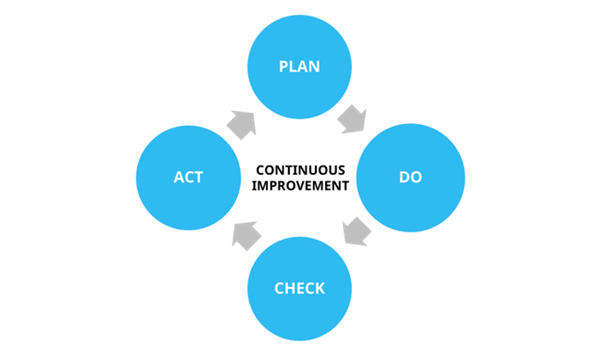
The importance of improvement in achieving excellence and innovation is acknowledged by many leaders. They might work hard to get better every day, but they also tend to wing it, which might be successful with the correct approach and enough commitment.
However, not everyone can actively do this in larger firms, which means they may lose out on numerous opportunities for innovation. Let’s now examine why adopting a well-planned continuous improvement method is preferable.
Why You Need A Continuous Improvement Strategy?
So far, continuous improvement has seemed simple; why would you need a plan that outlines how to improve every day?
If we use the analogy of New Year’s resolutions and consider how many individuals fail to keep them, we can see some trends that illustrate why developing and following a plan could avoid that.
The race to the finish line is one of the problems. We concentrate so hard on the broader objective that it becomes overpowering and impossible to achieve. Making modest adjustments each day and breaking down the larger objective into manageable steps will help you improve your behavior and frame of mind. We must develop a plan in order to do it.
We concentrate so hard on the broader objective that it becomes overpowering and impossible to achieve. Making modest adjustments each day and breaking down the larger objective into manageable steps will help you improve your behavior and frame of mind.
Continuous improvement is viewed as a journey with a goal, and once the objective is attained, it is over, which is another important feature. If we want to see long-lasting behavioral changes that become part of the organization’s culture, this path should never end. Daily operations will be focused on improvement in this way.
You’ll eventually need to decide what to do in order to carry out these daily tasks that contribute to progress. All areas cannot be subject to continuous improvement at once. No matter if it’s in your personal life or in a team within an enterprise, it becomes burdensome and counterproductive. Because of this, a continuous improvement plan should take into account the requirement for prioritization and deliberate decision-making.
Let’s now go over a few, more detailed advantages of continuous improvement planning:
Provides Direction And Emphasis
It’s crucial to give everyone working toward shared objectives in a company a clear focus and sense of direction. A continuous improvement approach puts the organization’s goals and the duties of each individual in perspective. Explaining why something is significant and requires improvement also helps.
It is simpler to establish the objectives when the goals, roles, and ways to attain them are represented visually.
Win Over Stakeholders
One of the key elements of a successful innovation strategy is getting the right stakeholders to implement continuous improvement approaches in their routine job.
A strong plan can win them over, whether they are investors who support and provide resources to your improvement activities or employees who have invaluable knowledge of improvement prospects and how to pursue them. Even if they reject it on the first try, their comments can help the plan become more effective.
A long-term vision can act as a catalyst and motivation so that both sides can profit, even though every business has some individuals who are more resistant to change.
Encourage proactivity
People tend to react to external factors when they lack a strategy. You may see past the fast triumphs with the help of this future projection. Instead of having to put out flames all the time, it gives time to think about possible courses of action.
Better Business Performance Overall
Although having a plan for how to do it is important, these business advantages are more of a side effect of adopting continuous improvement.
Cost savings, waste minimization, and improved operational effectiveness are all benefits of continuous improvement. We won’t go into great depth about these advantages because most executives are already aware of them, but it is important to keep in mind that creating a realistic yet ambitious strategy will have a significant impact on the organization’s bottom line.
Creating a Continuous Improvement Culture Strategy
Continuous improvement is ultimately just common sense, as was previously noted, therefore planning for it shouldn’t be overly difficult. A successful continuous improvement approach must have three key components: it must be straightforward, strategic, and operational.

Let’s quickly go over each of these before examining the key actions involved in developing a continuous improvement approach.
Simple
There’s no need to make things too complicated because, one, it will deter individuals from participating and, second, it will make it more challenging to communicate it and put it into practice across the business. After all, it only takes a few little actions each day to have a significant long-term influence.
Strategic
Strategic planning is required for continuous improvement since it must take the organization’s vision, objectives, and goals into account. A few people would gain from incremental improvements without a clear aim, but not the organization as a whole.
Operational
A strategic approach provides guidance, but the operational component explains how to put the strategy into practice, who is in charge, what the deadlines are, what resources are needed, and what metrics are used to determine success. Choosing the best procedures and supporting tools is a necessary step in preparing to execute continuous improvement.
Let’s now go through a few fundamental stages that will help you launch a continuous improvement strategy or perhaps improve an existing one.
1. Assess the current state
You may choose to start this initial stage by gathering some data that enables you to pinpoint the opportunities, bottlenecks, and strengths of existing procedures, goods, and services, or whatever you are especially working on.
2. Map the desired outcomes
Though you are aware of your location, where do you want to go? The business-integrated goals and objectives are mapped in the following stage. This stage will also assist you in identifying the differences between the situation as it is and the intended result.
Naturally, things may sound too abstract at this time, but it’s best to keep things straightforward and avoid overcomplicating things at this early stage of the planning process. Additionally, as continuous improvement involves so many various factors, every firm will choose a distinct strategy when it comes to taking particular actions.
3. Chart the improvement journey
Following these first two phases, you may begin mapping out your path to improvement. This stage explains how to close those gaps by taking specific steps that promote ongoing progress and foster the cultural conditions necessary for it.
Now is the time to focus a little more on the specifics, including how you’ll know when you’ve succeeded and when you’ve reached your goals (for instance, construct KPIs that, among other things, show you how much you’ve improved and how well continuous improvement was applied). Consider assigning duties and creating a timeframe as well.
4. Implement, test, adjust and scale
Again, this stage will look extremely different depending on the company, but the broad principles are generally applicable worldwide. You begin by including the workforce at all levels of the organization in the implementation of your strategy.
The standards, processes, and best practices for continuous improvement should be understood by all parties involved, from senior managers to frontline staff. Additionally, managers need a broad range of abilities to handle complicated procedures and manage change.
It ultimately depends on the dedication and participation of the senior leaders to accomplish this. They are essential for sustaining, scaling, and making adjustments to continuous improvement. This leads us to the topic of our following section: the essential ingredients for developing and maintaining a continuous improvement plan.

Case Study
All this theory is fascinating, but how does it actually play out? We streamlined the plan to only have four steps for the sake of clarity and conciseness, but these are subject to change, development, and transformation in accordance with each organization. Let’s use the logistics firm Coyote Logistics as an example to illustrate how things work in practice.
After conducting a state assessment, the business discovered that a food shipper was paying $98 000 more than necessary as a result of inadequate planning and communication. Therefore, they wanted to reduce extra expenditures, improve operational efficiency, improve pick-up performance, and streamline communication between those involved in the process.
To do this, they first created a strategy map where key stakeholders could add suggestions for potential solutions and underline advantages and difficulties along the route.
They then took action, regularly monitored the projects, and evaluated those actions and their outcomes.
They eventually managed to save $85,000 in a single year, cut back on extra expenses by 84.81%, and improve communication by ceasing pointless email exchanges. They took sure to acknowledge and share the outcomes with their staff, so their program did not end here. They honored and praised those people and groups whose efforts resulted in a positive change.
Key Success Factors For A Good CI Strategy
It’s simple to become mired in the planning process and put off execution until you arrive at what you consider to be the ideal continuous improvement approach. This error is frequent and can prevent implementation. It is difficult to identify the areas of a continuous improvement plan that require improvement unless you put it into practice because improvements are always possible.
Let’s move on to some crucial success characteristics that will help you keep things straightforward, maintain your focus, and get to the execution stage more quickly.
Alignment Of Business Objectives
Change can occur top-down or bottom-up in an organization, but in either instance, it won’t last without strong top-down alignment. As a result, executives and managers in charge of high-level operations must coordinate the aims and objectives of the company and link them to the continuous improvement approach.

Case Study
For instance, officials at the Nordic agricultural cooperative Lantmännen tied their strategy to precise financial goals in order to support development and creative ideas. They sought to grow their main business by 6% and new organic enterprises by 2%. These overarching objectives were broken down into product groups and business units, and they eventually attained a 13% annual growth rate.
Involving Management
Especially when innovation is at stake, management is crucial to the success of larger ventures, and failing to innovate could lose them their company’s future. Leaders ought to be dedicated to actively promoting and supporting continual development.
Even studies have demonstrated the need of top leaders’ involvement in maintaining gains. In fact, after studying data from 204 lean initiatives, researchers came to the conclusion that those with stronger head office assistance improved 25% more after a year than those without it, and 79% fared better than average.
In comparison to projects without more head office support, those projects improved 25% more after a year, and 79% performed better than average.
Frontline staff would believe that the organization is no longer dedicated if management did not openly encourage continual improvement.
A series of interviews with leaders who discussed continuing continuous improvement in organizations provided some useful insights into how management may take part and maintain their enthusiasm. The “immersion program” for lean management was suggested by one of the vice presidents. Senior leaders can participate in Kaizen events to see continuous improvement in action while also honing their abilities and seeing the successes of their peers.
Effective Communication
When you desire support from the entire organization, you cannot undervalue the importance of communication. Again, since top-down strategic planning is the norm, leaders should not only explain the program but also do it using the appropriate narrative.
For instance, the strategy should make it crystal apparent how it supports the organization’s mission and how it addresses certain issues that will also be advantageous to employees. For instance, a hospital intended to prioritize patient care by cutting down on staff time dedicated to paperwork. It resulted in mutual benefit.
Additionally, communication must continue throughout the entire course of the project. Employee motivation and engagement rise when leaders share, recognize, and celebrate modest victories and the contributions of their teams.
Continued, Persistent Attempts
The continuous improvement strategy should abandon project-based improvements, which are typically one-time activities, in order to achieve long-term success. While going after the low-hanging fruit is simpler and does produce benefits in the near term, you’ll find that there are fewer and fewer of those over time.
You’ll want to see continual improvement in order to support these efforts, and you may achieve that by picking the appropriate measures for success. What changes were made, how did they affect the bottom line, or how did they help with the overall objective? Each organization’s version of these metrics will be unique, but the most essential thing is to avoid vanity metrics that don’t tell the real story.
Include lean management behaviors in the performance reviews, for instance, if you want to keep workers motivated and engaged. People would be able to see their impact after tackling particular issues in their locality in this way.
Conclusion
There are numerous considerations when it comes to organizing an ideation process. Finally, it’s crucial to keep in mind that taking actual action is more vital than getting bogged down in detailed preparation. If you feel yourself getting bogged down in the details, pause, stand back, and consider how you could maintain a sharp focus that enables decision-makers to take action.
Even though a new program’s initial enthusiasm and hype will eventually wear off, you should continue introducing essential changes, no matter how unimpressive or mundane they may seem. These incremental victories add up to significant gains over time. Rushing into new endeavors causes you to lose focus, which prevents long-term benefits from materializing.
The culture will change as a result of this kind of dedication. Although it takes time and effort to create a continuous improvement culture, persistence and patience will pay off in the end.

Exercise 1.9: Mission Impossible
Objective: To engage participants in a problem-solving activity that highlights the importance of strategic thinking, communication, and collaboration in achieving organizational goals.
Materials needed:
1. Pen and paper for each participant
2. Timer
3. Printed envelopes with secret mission cards (prepare multiple missions based on the number of teams)
Instructions:
1. Introduce the purpose of the workshop exercise, emphasizing the role of strategy in overcoming challenges and achieving success.
2. Divide participants into small teams of 5 members.
3. Provide each team with an envelope containing a secret mission card.
4. Explain that each team has been assigned a unique mission that they must accomplish within a specific time limit (e.g., 30 minutes).
5. Instruct the teams to read their mission cards carefully and discuss the best approach to accomplish the mission.
6. Start the timer and allow the teams to brainstorm, strategize, and plan their actions.
7. After the time limit is up, gather all the teams together for a debriefing session.
8. Ask each team to present their mission and the strategies they devised to accomplish it.
9. Facilitate a discussion on the different strategies employed, the challenges faced, and the lessons learned.
10. Summarize the exercise by highlighting the importance of strategic thinking, effective communication, and collaboration in achieving organizational goals.

Course Manual 10: Operationalizing CI
Making reasonable decisions in a work environment requires the use of operationalization. This method can be utilized in a wide range of circumstances and is mostly employed in the workplace to make non-quantifiable concepts simpler to examine. Increased performance is just one of the many advantages that operationalization may bring to the workplace. It can also provide rules for evaluating both individual and group behavior and performance.
This course manual defines operationalization, explains its significance, examines its advantages, and provides examples of operationalization processes in action.
What Is Operationalization?
Operationalization is a technique for transforming intangible or abstract ideas into quantitative information. By doing so, they become observable and recordable and offer clean data that can be sorted and analyzed. For examining behaviors and patterns that are otherwise impossible to quantify, operationalization is a useful technique. The ability for companies to better understand and evaluate employee behavior, productivity, and motivation makes this procedure advantageous in the workplace.

What Makes Operationalization Crucial?
Operationalization is crucial because it enables businesses to more accurately define and analyze a variety of elements related to the workplace and its workers. For instance, operationalization can be used to measure various motivational aspects in order to determine what inspires employees the most. This can give a clearer sense of the precise factor that maintains employee motivation at work. Employers and managers can make use of operationalization in a variety of circumstances, such as when figuring out how to reduce staff churn, enhancing customer loyalty, and gauging employee job satisfaction.
Operationalization Advantages
Using operationalization procedures can help businesses in a number of ways, including the following:
Quantifying data
The ability to convert abstract, intangible concepts into quantitative facts is the main advantage of operationalization. As a result, a business’s capacity to evaluate the data is increased. Quantifiable data, for instance, gives specific variables that go into a staff member’s total motivation at work rather than leaving it up to the employer to guess what inspires their employees the most.
Keeping a focus throughout an evaluation
Clarity when reviewing material can also be achieved by using quantification to an assessment. Clearly defining the metrics you’re using to record data about a notion and its purpose is part of the operationalization process. Employee performance can be improved as a result of having a better comprehension of the significance of the information provided to them.
Developing tendencies
Operationalization enables you to monitor that data and search for trends in the workplace by turning abstract concepts into quantifiable statistics. You can do analytical tasks like sorting, charting, and averaging once you have quantified the facts pertaining to the idea you are studying. This makes it feasible to study data in ways that aren’t possible with qualitative data, including information about the notion and its prevalence among the investigated population.
Improving performance
An operationalization process’ main objective is to find ways to improve employee and organizational performance levels. You can create new strategies and concepts to apply in a professional context by discovering novel ways to think about material.
By tracking how the quantifiable data changes when you make changes to procedures, operationalization also enables you to test the effects of these changes, enabling you to further deploy effective approaches and drop ineffective ones.
How to implement operationalization at work
You can take the following actions to introduce operationalization procedures at work:
1. Decide on a focus
Select a focus for your operationalization efforts before using them. You are attempting to discover new knowledge about the abstract thought or unquantifiable concept in question. In order to apply subsequent processes and generate useful data that will aid in guiding future professional decisions, it is crucial to precisely describe what you are aiming to research.
For instance, a business can be concerned about the sense of camaraderie among its employees. This is a worthwhile topic due to the impact it may have on performance levels as a whole, yet it is an ill-defined idea that cannot be precisely measured. In this situation, the operationalization process would center on team spirit.
2. Choose your variables.
The variables that can indicate a concept’s performance, whether strong or weak, must be defined in order to evaluate the concept you are studying. In the aforementioned illustration, the business decides that peer perceptions and employee interactions are crucial factors to take into account. These variables reflect their general relationships with coworkers as well as how frequently they spend time together voluntarily.
3. Define your signals
To give your variables values, you can utilize indicators, which are quantifiable measurements. The variables give you a mechanism to categorize the data you observe, collect, and analyze. By using indicators, you can more precisely quantify the data using simple concepts.
Using the same scenario, suppose the employer gauges interactions by looking at the number of people who show up for optional team-building activities and the typical number of people per table in the dining hall. An anonymous survey about relationships between coworkers is also given to the workforce. These metrics enable the employer to collect measurable information on employees’ perceptions of their coworkers, which has a direct bearing on team spirit.
4. Watch and evaluate the outcomes.
You can start gathering important pieces of information as soon as you’ve decided on the metrics you’ll use to evaluate your data. It may be possible to access data right away using previously compiled data sets, or it may take more observation and recording. Your data set’s ability to accurately reflect the larger community will increase with size.
5. Data analysis and sorting
You can start categorizing and analyzing the information about your topic once you’ve transformed it into numerical data. Depending on the data you have access to and the goals you have for the research, the specific analysis you conduct may change.
Using the team spirit scenario as an example, the employer can opt to plot attendance and group sizes versus projects finished within the same time period on a graph to see whether there is any association. In their analysis, they also incorporate data from the employee questionnaires. Given that the graph demonstrates a direct association between times of high cohesion and high performance, this information enables the employer to draw inferences about how to improve team spirit.
6. Make modifications, then repeat
You’re prepared to make changes depending on what the data tells you after identifying potential improvement areas. It’s advantageous to keep tracking your quantifiable data after making changes. This enables you to evaluate the efficacy of your adjustments and, if necessary, increase or lessen their impact.
The team spirit example’s survey findings revealed that Friday night social events saw the highest turnout from employees. More of these opportunities are planned by the business in an effort to promote stronger team bonding and boost workplace productivity.
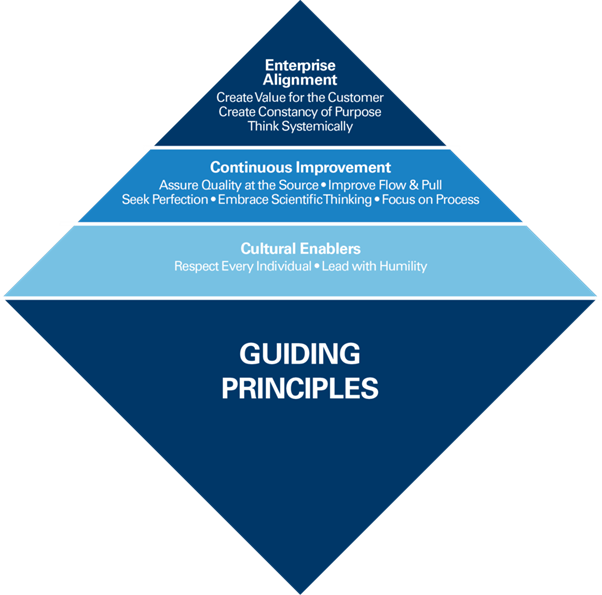
4 Workplace Operationalization Instances
1. team’s trust in sales
This is an illustration of a sales team:
A corporation with an outside sales division wants to know if its personnel have an effective level of confidence in their abilities.
This is a crucial idea for the employer to comprehend because overconfidence might result in poor performance. The division manager asks the sales team to forecast their sales for the following quarter in order to translate confidence into quantifiable measures.
The management evaluates each employee’s sales performance against their forecasts at the conclusion of each quarter. The data gives the division manager an overview of the general levels of confidence within the sales force in relation to their actual performance in addition to enabling them to evaluate each employee’s productivity over a certain time period.
2. employee satisfaction
Here is an illustration of a content employee:
Keeping employee morale strong is a priority for many businesses. In addition to helping to increase performance levels, a happy workforce makes it simpler to keep hold of essential personnel. An executive looks at two quantifiable pieces of data to quantify staff pleasure. The retention rate and the typical proportion of new job seekers with an internal recommendation are among these factors.
While a large number of recommendations may indicate that staff members appreciate their place of employment enough to recommend it to a friend or acquaintance, a high retention rate frequently indicates that employees love their responsibilities and workplace. The CEO can then decide if workers are satisfied in their jobs or whether implementations to boost morale inside the organization are necessary by comparing the data they collect to generic data.
3. Staff challenges
Here is an illustration of a staff challenge:
For many businesses, finding the ideal balance in terms of the difficulties employees experience is crucial. Overly demanding employment can have a negative effect on morale and increase stress. A lack of expectations can distract workers and prevent them from working to the best of their abilities, which can diminish output.
Employers and managers can use a variety of measures, such as employee evaluations, the percentage of tasks finished beyond the given target date, and the percentage of assignments finished one or more days early, to assess workload management. For instance, data from a manager’s team shows that few assignments are submitted after the due date and that most work is finished by employees at least one day ahead of schedule. The manager feels that the effort placed on their team is appropriate because team members’ review ratings are similarly high.
4. consumer contentment
Here is an illustration of a satisfied customer:
For many client-facing businesses, maintaining customer satisfaction is an important objective. Customers who are satisfied with a product or service are more inclined to tell others about it and use it again. A company’s product manager monitors average purchase amounts, repeat purchases, and product returns while releasing a new product. These three measures each provide important clues about how well customers are like the product.
The project manager analyzes statistics for their new product to that of earlier offerings after selling the product for a month. They find that they are fulfilling a lesser percentage of refund requests while selling the goods in greater quantities and with more repeat purchases. Since the data indicates that their team has created a successful product, the manager decides to increase the marketing budget in order to further increase sales and reach.

Case Study: Starbucks
One example of a company that successfully operationalized its strategy is Starbucks Corporation. Starbucks is a global coffeehouse chain that has demonstrated effective implementation of its strategic initiatives to achieve its growth and expansion goals. Here is an overview of how Starbucks operationalized its strategy:
1. Strategic Objective: Starbucks’ strategic objective was to become the leading purveyor of the finest coffee in the world while maintaining its uncompromising principles.
2. Market Expansion: Starbucks identified the need to expand its market presence both domestically and internationally. It formulated a growth strategy focused on opening new stores in strategic locations, targeting high-traffic areas, and entering new markets.
3. Store Expansion and Localization: To operationalize the strategy, Starbucks developed a systematic approach to store expansion and localization. It conducted market research to identify suitable locations, demographics, and cultural nuances of target markets. This information helped determine the number and size of stores, store formats (e.g., drive-thru, express stores), and product offerings tailored to local preferences.
4. Partnerships and Licensing: Starbucks formed strategic partnerships and licensing agreements with local companies and franchises to facilitate market entry and expand its global footprint. This approach enabled Starbucks to leverage the local expertise of its partners, gain access to prime real estate, and navigate regulatory requirements in different countries.
5. Employee Training and Development: Starbucks recognized the importance of its employees in delivering an exceptional customer experience and maintaining the company’s culture. It invested in comprehensive training programs to ensure consistency in product quality, service standards, and the Starbucks experience across its stores worldwide. This operationalized the strategy of being the leading purveyor of high-quality coffee.
6. Sustainable Sourcing and Ethical Practices: Starbucks operationalized its commitment to sustainability and ethical sourcing by implementing specific programs and initiatives. This included establishing relationships with coffee farmers, supporting fair trade practices, and promoting environmentally friendly farming methods. These efforts aligned with the strategic objective of maintaining the highest standards while cultivating long-term supplier relationships.
7. Technology Integration: Starbucks embraced technology to enhance operational efficiency and improve the customer experience. The company developed its mobile ordering and payment app, allowing customers to conveniently order and pay for their drinks in advance. This operationalized the strategy of leveraging technology to drive customer engagement and streamline operations.
8. Continuous Innovation: Starbucks fostered a culture of continuous innovation to stay ahead in the highly competitive coffee industry. The company introduced new product offerings, such as seasonal beverages and food items, and experimented with store formats and design concepts. This operationalization of innovation aligned with the strategic objective of maintaining Starbucks’ position as a leader and trendsetter in the industry.
By effectively operationalizing its strategic initiatives, Starbucks has achieved significant growth and become a globally recognized brand. The company’s ability to translate its strategic objectives into actionable plans and execute them consistently has been instrumental in its success.

Exercise 1.10: Operationalizing Strategy
Objective: The objective of this exercise is to engage participants in understanding and operationalizing strategic initiatives within an organization. Participants will learn how to translate strategic objectives into actionable tasks, assign responsibilities, and develop a roadmap for successful implementation.
Instructions:
1. Divide participants into small groups of 5 people.
2. Introduce the workshop objective: Explain that each group will work together to operationalize a strategic initiative or objective of the organization.
3. Provide participants with information about the strategic initiative or objective they need to operationalize. This information should include the strategic goal, its importance to the organization, and any existing strategies or plans related to it.
4. Instruct the groups to discuss and identify the key tasks, actions, and milestones required to achieve the strategic objective. Encourage them to think about the specific actions and outcomes needed to operationalize the strategy.
5. Ask the groups to categorize the identified tasks into different functional areas or departments within the organization (e.g., marketing, operations, human resources).
6. Allocate time for each group to assign responsibilities for each task. They should consider the skills, expertise, and resources required for each task and determine the individuals or teams responsible for their execution.
7. Instruct the groups to develop a timeline or roadmap for the implementation of the strategic initiative. The roadmap should outline the sequence of tasks, their start and end dates, and any dependencies or critical milestones.
8. Encourage the groups to consider potential risks, challenges, and mitigation strategies associated with the implementation of the strategic initiative. They should identify any obstacles that may arise and develop contingency plans or alternative approaches to address them.
9. Each group will present their operationalization plan to the rest of the participants. They should clearly explain the strategic initiative, the tasks and responsibilities assigned, the timeline, and the anticipated outcomes. Visual aids, such as Gantt charts or process flow diagrams, can be used to enhance the presentation.
10. Facilitate a discussion and encourage participants to provide feedback and suggestions on the presented operationalization plans. Discuss common challenges, best practices, and potential integration points between different initiatives.
11. Summarize the key takeaways from the exercise and emphasize the importance of clear communication, coordination, and ongoing monitoring to ensure successful implementation of strategic initiatives.

Course Manual 11: Ensuring Success
How To Measure The Success Of Your Process Improvement
Your goal for process improvement is the same as any other improvement initiative: to make processes more effective or efficient, regardless of the sector of business or division in which you operate. But how can you tell if your attempts to optimize your processes were successful?
Establishing metrics and KPIs (key performance indicators) evaluating your process baseline and the change in these characteristics over time can help you determine the success of your process improvement. Cycle time, the amount of defects, customer happiness, and cost are just a few of the metrics you can use to gauge the effectiveness of your process improvement activities.
The significance of process improvement, the objectives you should set, and an explanation of some of the metrics stated above are all covered in this article. Don’t be intimidated by the technical terms; the concepts are simple to understand and apply to your procedures.
What Is The Goal Of Process Improvement?
To properly respond to this query, it is first crucial to comprehend what the word “process improvement” actually means. The purpose of process improvement is to increase quality, productivity, and/or cost-effectiveness of business processes by adopting a systematic approach to their study and redesign.
Depending on your organization, process improvement may have a variety of objectives. Some businesses might work to raise quality in order to better serve customers. Others might concentrate on productivity in order to boost effectiveness and cut costs. Some people might even want to emphasize a balance between production and quality.
Regardless of the precise objectives of your process improvement project, it is crucial to remember that any improvement will demand a commitment of time, resources, effort, and—most importantly—the support of your team. It seems unlikely that any meaningful advancements will be made without this dedication.
What Indicators Should You Use To Assess The Success Of Process Improvement?
Choosing the metrics that relate to you is the first step in gauging the performance of your process improvement initiatives. Do you want to find flaws that could lead to errors or are your improvement efforts intended to decrease wastage of time and resources? Are you attempting to gauge and raise employee or customer satisfaction? Once you’ve identified the metrics that are most pertinent to your individual requirements, be sure to link them to the larger aims and objectives of your firm. This not only makes it easier to monitor the success of your efforts but also guarantees that you and your team will be given credit for the gains in reaching your company’s goals.
How you plan to gather the necessary data is the second factor to take into account while establishing these measures. Will data collecting be carried out manually or automatically? Will you monitor data over time or only take a picture when anything happens? After gathering the data, you must evaluate it to look for trends and patterns. You can use all of this information to evaluate the accomplishment of your efforts to improve your processes.
Taking these factors into account, let’s examine the most popular process improvement metrics:
Process Cycle Time (PCT)
Naturally, speeding up a procedure is your top priority if you want to complete a task more quickly. The amount of time it takes to complete one cycle of a process is known as the process cycle time. It serves as a gauge of how effective your process is and is employed in process improvement to pinpoint opportunities for process improvement. If you want to figure out which parts of your process are taking too long and creating bottlenecks, you must establish this statistic.
Process cycle time can be utilized in a number of ways to help with process improvement:
• Cutting down on cycle completion times.
• Finding and eliminating process bottlenecks.
• Appreciating the process’s potential.
• Improving process predictability.
A useful statistic for any firm looking to optimize its processes is process cycle time. Organizations may increase their efficiency and boost their bottom line by monitoring and lowering cycle time.
Process Uptime
The percentage of time a process is running and accessible to its users is known as process uptime. It serves as a gauge of process dependability and is a crucial statistic for determining how well your process improvement efforts are working.
Process downtime, system downtime, and user-side downtime are just a few of the variables that might have an impact on process uptime. System failures, process problems, and user mistakes are just a few of the many factors that can result in downtime. This indicator can demonstrate the direct impact a procedure has on the revenue your business can produce. A process that is not operating well is not bringing in money, therefore even a minor improvement in uptime can have a big effect on the bottom line.
Additionally, process uptime can be utilized to spot future improvement opportunities and is an excellent indicator of process health. For instance, if you see that your process’ uptime is low at particular times of the day, you can look into the cause and take precautions to avoid it in the future.
Process Capability.
Process capability is the ability to deliver outputs that satisfy predetermined criteria. In other words, it evaluates how well a process can generate results that satisfy your desired requirements.
The ability to compare a process’ performance to the specified specification levels makes process capability essential to process improvement. The opportunities for improvement can then be determined using this comparison. Additionally, process capacity can be used to track a process’s performance over time to make sure it maintains the intended levels.
Customer Satisfaction.
One of the objectives you should set to guide your process improvement plan is customer satisfaction. Understanding what your clients or consumers want and need enables you to build methods that produce these results. Surveys, interviews, focus groups, and other techniques can be used to collect customer feedback. You can then use this knowledge to enhance your operations, goods, and services.
Customer happiness is crucial for business performance in general as well as process improvement. Customers who are satisfied are more likely to use a business again and refer it to others. As a result, businesses should work to ensure that customers are very satisfied at all times.

Case Study: AirBnB
A company that heavily relies on customer feedback to improve its business is Airbnb. Airbnb is a global online marketplace and hospitality service that enables individuals to rent out their properties or spare rooms to travelers. Customer feedback plays a vital role in shaping the Airbnb experience for both hosts and guests.
Airbnb collects feedback from guests through reviews and ratings after their stays. These reviews are publicly available on the platform, allowing potential guests to make informed decisions based on previous guests’ experiences. Hosts are also able to leave reviews for guests, ensuring a fair and transparent feedback system.
The feedback received by Airbnb helps in multiple ways. Firstly, it allows hosts to improve the quality of their listings and provide better accommodations for future guests. Hosts can learn from feedback about cleanliness, amenities, communication, and other aspects of their listings. This drives hosts to continuously enhance their properties and overall hosting experience.
Secondly, the feedback system helps Airbnb to identify and address any issues or concerns that may arise during a guest’s stay. If a guest reports a problem or complaint, Airbnb’s customer support team steps in to resolve the issue and takes appropriate action to ensure customer satisfaction. This feedback-driven approach helps Airbnb maintain high standards and improve their services over time.
Airbnb also actively seeks feedback from its host community through surveys and communication channels. By understanding the needs and expectations of hosts, Airbnb can make informed decisions about platform improvements, policy changes, and feature additions. Host feedback is invaluable for Airbnb’s ongoing efforts to refine their service and make it more host-friendly.
In summary, Airbnb is a company that values customer feedback and utilizes it to continuously enhance its platform, improve guest experiences, and provide better support to hosts. By actively collecting and acting upon customer feedback, Airbnb fosters a culture of continuous improvement and ensures that their business evolves in response to the needs and expectations of their customers.
How Do You Plan to Monitor Your Progress?
You need to choose the measurement approach after deciding on the metrics to track your progress and improvement success. You can keep tabs on the development of your process improvement in a number of ways.
A control chart can be used to monitor process development. A control chart is a graph that displays the evolution of a process. You can use it to determine whether your process is improving, degrading, or remaining unchanged.
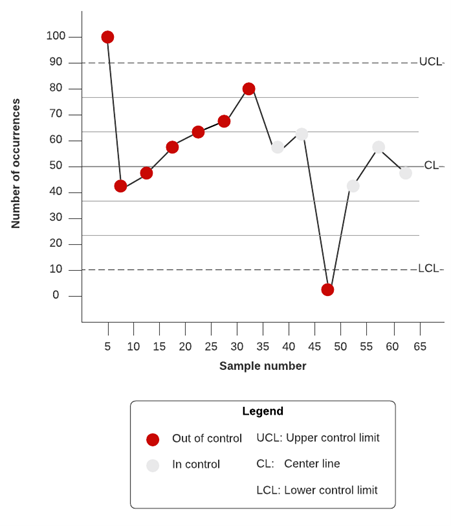
To monitor the development of your process improvement, you can also use a process map (similar to a flowchart). An illustration of the steps in a process is called a process map. You may be able to spot potential areas for improvement.
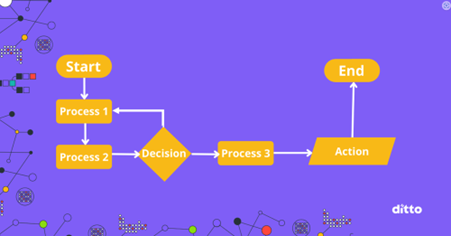
A checklist can also be used to monitor the development of your process improvement. You can find areas for improvement with the aid of a checklist.
Finally, you can monitor the development of your process improvement by keeping a journal. You can track your development and think back on your achievements and difficulties by keeping a journal. Add a recurring task to your work management program to produce reports on the status of your improvement initiatives and distribute them to the rest of your team. This will help you stay engaged.
What Timetable Do You Have For Process Improvement?
This question does not have a single solution. The length of time relies on a number of variables, such as the nature and extent of your process improvement endeavor, the resources at your disposal, and the level of team commitment. To keep everyone on track and prevent the initiative from fading away, it is crucial to have a realistic deadline for the achievement of a process improvement endeavor.
An example of a typical schedule for a successful process improvement endeavor may be as follows:
• 3 months: carry out a preliminary analysis and create a high-level plan.
• 6 months: put changes into practice and monitor outcomes.
• 9 months: assess the results and make any necessary modifications.
• 12 months: acknowledge accomplishments and provide wisdom.
This is merely a general timeframe that you can modify depending on the size of your team, the quantity of your processes, and of course, the early-stage targets you set.
You can assess the accomplishment of your process improvement in a number of ways. The most crucial lesson to learn from this piece is to keep in mind that getting better is a never-ending process. You can sustain this development and keep everyone on your team accountable by setting the appropriate KPIs and providing regular updates.

Exercise 1.11: Process Mapping and Improvement
Materials needed:
1. Whiteboard or large paper
2. Sticky notes or index cards
3. Pens or markers
Instructions:
1. Divide students into small groups (5 members per group).
2. Explain the importance of process improvement in organizations and the benefits of visualizing processes through process mapping.
3. Provide a simple process scenario to each group, such as a customer order fulfillment process or a student enrollment process.
4. Instruct each group to create a process map for the given scenario using sticky notes or index cards. They should break down the process into individual steps and visualize the flow, including inputs, outputs, and decision points.
5. Once the process maps are complete, have each group present their maps to the class, explaining the different steps and decision points.
6. Facilitate a discussion about potential areas for improvement in each process. Encourage students to identify bottlenecks, inefficiencies, and unnecessary steps.
7. Ask each group to brainstorm and suggest potential improvements for their respective processes. They should focus on practical solutions that can enhance efficiency, reduce waste, or improve the overall customer experience.
8. Have each group update their process maps to reflect the proposed improvements, using different colored sticky notes or markers.
9. Conclude the exercise by discussing the importance of continuous improvement and how organizations can benefit from analyzing and optimizing their processes regularly.
Project Studies
Project Study (Part 1) – Customer Service
The Head of this Department is to provide a detailed report relating to the Improvement Strategy process that has been implemented within their department, together with all key stakeholders, as a result of conducting this workshop, incorporating process: planning; development; implementation; management; and review. Your process should feature the following 11 parts:
01. Continuous Improvement
02. Role of Leaders
03. Method Principles
04. Improving Performance.
05. Setting Strategy
06. Aligning Goals
07. Building Infrastructure
08. Standards & Consistency
09. Developing Strategy
10. Operationalizing CI
11. Ensuring Success
Please include the results of the initial evaluation and assessment.
Project Study (Part 2) – E-Business
The Head of this Department is to provide a detailed report relating to the Improvement Strategy process that has been implemented within their department, together with all key stakeholders, as a result of conducting this workshop, incorporating process: planning; development; implementation; management; and review. Your process should feature the following 11 parts:
01. Continuous Improvement
02. Role of Leaders
03. Method Principles
04. Improving Performance.
05. Setting Strategy
06. Aligning Goals
07. Building Infrastructure
08. Standards & Consistency
09. Developing Strategy
10. Operationalizing CI
11. Ensuring Success
Please include the results of the initial evaluation and assessment.
Project Study (Part 3) – Finance
The Head of this Department is to provide a detailed report relating to the Improvement Strategy process that has been implemented within their department, together with all key stakeholders, as a result of conducting this workshop, incorporating process: planning; development; implementation; management; and review. Your process should feature the following 11 parts:
01. Continuous Improvement
02. Role of Leaders
03. Method Principles
04. Improving Performance.
05. Setting Strategy
06. Aligning Goals
07. Building Infrastructure
08. Standards & Consistency
09. Developing Strategy
10. Operationalizing CI
11. Ensuring Success
Please include the results of the initial evaluation and assessment.
Project Study (Part 4) – Globalization
The Head of this Department is to provide a detailed report relating to the Improvement Strategy process that has been implemented within their department, together with all key stakeholders, as a result of conducting this workshop, incorporating process: planning; development; implementation; management; and review. Your process should feature the following 11 parts:
01. Continuous Improvement
02. Role of Leaders
03. Method Principles
04. Improving Performance.
05. Setting Strategy
06. Aligning Goals
07. Building Infrastructure
08. Standards & Consistency
09. Developing Strategy
10. Operationalizing CI
11. Ensuring Success
Please include the results of the initial evaluation and assessment.
Project Study (Part 5) – Human Resources
The Head of this Department is to provide a detailed report relating to the Improvement Strategy process that has been implemented within their department, together with all key stakeholders, as a result of conducting this workshop, incorporating process: planning; development; implementation; management; and review. Your process should feature the following 11 parts:
01. Continuous Improvement
02. Role of Leaders
03. Method Principles
04. Improving Performance.
05. Setting Strategy
06. Aligning Goals
07. Building Infrastructure
08. Standards & Consistency
09. Developing Strategy
10. Operationalizing CI
11. Ensuring Success
Please include the results of the initial evaluation and assessment.
Project Study (Part 6) – Information Technology
The Head of this Department is to provide a detailed report relating to the Improvement Strategy process that has been implemented within their department, together with all key stakeholders, as a result of conducting this workshop, incorporating process: planning; development; implementation; management; and review. Your process should feature the following 11 parts:
01. Continuous Improvement
02. Role of Leaders
03. Method Principles
04. Improving Performance.
05. Setting Strategy
06. Aligning Goals
07. Building Infrastructure
08. Standards & Consistency
09. Developing Strategy
10. Operationalizing CI
11. Ensuring Success
Please include the results of the initial evaluation and assessment.
Project Study (Part 7) – Legal
The Head of this Department is to provide a detailed report relating to the Improvement Strategy process that has been implemented within their department, together with all key stakeholders, as a result of conducting this workshop, incorporating process: planning; development; implementation; management; and review. Your process should feature the following 11 parts:
01. Continuous Improvement
02. Role of Leaders
03. Method Principles
04. Improving Performance.
05. Setting Strategy
06. Aligning Goals
07. Building Infrastructure
08. Standards & Consistency
09. Developing Strategy
10. Operationalizing CI
11. Ensuring Success
Please include the results of the initial evaluation and assessment.
Project Study (Part 8) – Management
The Head of this Department is to provide a detailed report relating to the Improvement Strategy process that has been implemented within their department, together with all key stakeholders, as a result of conducting this workshop, incorporating process: planning; development; implementation; management; and review. Your process should feature the following 11 parts:
01. Continuous Improvement
02. Role of Leaders
03. Method Principles
04. Improving Performance.
05. Setting Strategy
06. Aligning Goals
07. Building Infrastructure
08. Standards & Consistency
09. Developing Strategy
10. Operationalizing CI
11. Ensuring Success
Please include the results of the initial evaluation and assessment.

Project Study (Part 9) – Marketing
The Head of this Department is to provide a detailed report relating to the Improvement Strategy process that has been implemented within their department, together with all key stakeholders, as a result of conducting this workshop, incorporating process: planning; development; implementation; management; and review. Your process should feature the following 11 parts:
01. Continuous Improvement
02. Role of Leaders
03. Method Principles
04. Improving Performance.
05. Setting Strategy
06. Aligning Goals
07. Building Infrastructure
08. Standards & Consistency
09. Developing Strategy
10. Operationalizing CI
11. Ensuring Success
Please include the results of the initial evaluation and assessment.

Project Study (Part 10) – Production
The Head of this Department is to provide a detailed report relating to the Improvement Strategy process that has been implemented within their department, together with all key stakeholders, as a result of conducting this workshop, incorporating process: planning; development; implementation; management; and review. Your process should feature the following 11 parts:
01. Continuous Improvement
02. Role of Leaders
03. Method Principles
04. Improving Performance.
05. Setting Strategy
06. Aligning Goals
07. Building Infrastructure
08. Standards & Consistency
09. Developing Strategy
10. Operationalizing CI
11. Ensuring Success
Please include the results of the initial evaluation and assessment.

Project Study (Part 11) – Logistics
The Head of this Department is to provide a detailed report relating to the Improvement Strategy process that has been implemented within their department, together with all key stakeholders, as a result of conducting this workshop, incorporating process: planning; development; implementation; management; and review. Your process should feature the following 11 parts:
01. Continuous Improvement
02. Role of Leaders
03. Method Principles
04. Improving Performance.
05. Setting Strategy
06. Aligning Goals
07. Building Infrastructure
08. Standards & Consistency
09. Developing Strategy
10. Operationalizing CI
11. Ensuring Success
Please include the results of the initial evaluation and assessment.

Project Study (Part 12) – Education
The Head of this Department is to provide a detailed report relating to the Improvement Strategy process that has been implemented within their department, together with all key stakeholders, as a result of conducting this workshop, incorporating process: planning; development; implementation; management; and review. Your process should feature the following 11 parts:
01. Continuous Improvement
02. Role of Leaders
03. Method Principles
04. Improving Performance.
05. Setting Strategy
06. Aligning Goals
07. Building Infrastructure
08. Standards & Consistency
09. Developing Strategy
10. Operationalizing CI
11. Ensuring Success
Please include the results of the initial evaluation and assessment.
Program Benefits
Human Resources
- Learning
- Employee Growth
- Increased Motivation
- Buy-In
- Full Potential
- Collaboration
- Skill Development
- Goal Setting
- Accountability
- Improved Feedback
Management
- Decision-Making
- Shared Responsibility
- Collective Goals
- Improved Communication
- Collective Leadership
- Sustainability
- Process Identification
- Data Analysis
- Critical Thinking
- Continuous Improvement
Production
- Stakeholder Needs
- Value Identification
- Improved Processes
- Agility
- People Development
- Improved Framework
- Strategic Planning
- Develop KPI’s
- Governance
- Strong Infrastructure
Client Telephone Conference (CTC)
If you have any questions or if you would like to arrange a Client Telephone Conference (CTC) to discuss this particular Unique Consulting Service Proposition (UCSP) in more detail, please CLICK HERE.

























